Paul van Yperen's Blog, page 320
January 23, 2017
Mylène Demongeot
Beautiful Mylène Demongeot (1935) became one of the blond sex symbols of the French cinema when she seduced Yves Montand in Les sorcières de Salem (1957). The coquettish French actress would go on to co-star in the three Fantômas adventures and many other European films of the 1950s and 1960s. In the 1980s she also became a producer.
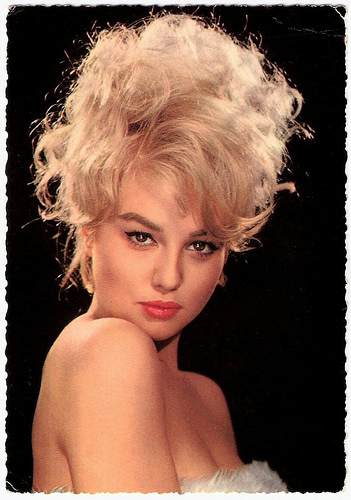
German postcard by Kruger, no. 902/162.
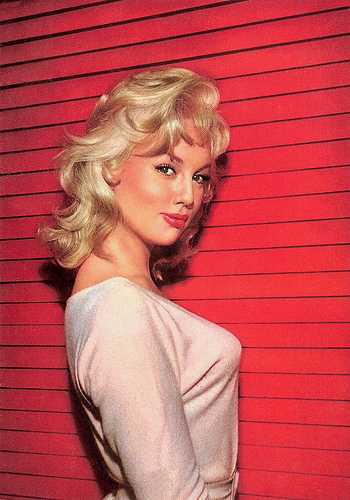
French postcard by Editions P.I., Paris, no. 1066. Photo: Dimitri/Dalmas.
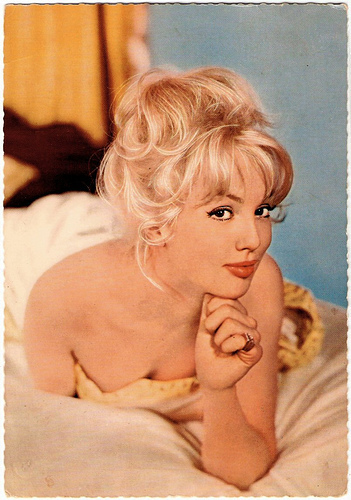
German postcard by Kruger, no. 902/76.
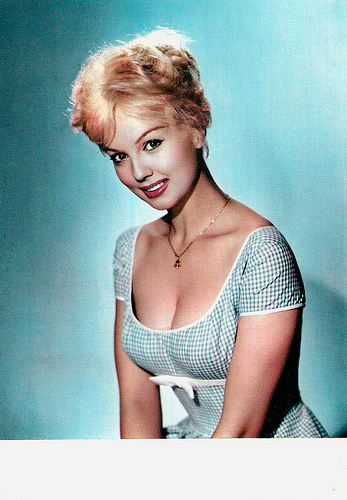
French postcard by Editions P.I., Paris, no. 1014. Photo: Sam Lévin.
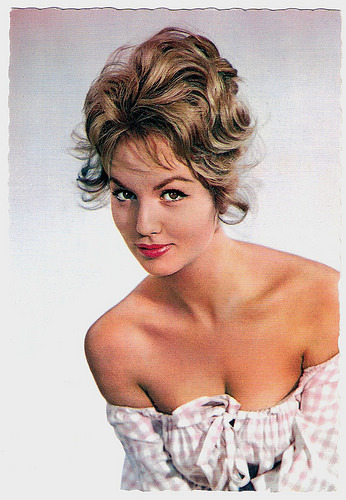
French postcard by E.D.U.G., no. 143. Photo: Sam Lévin.
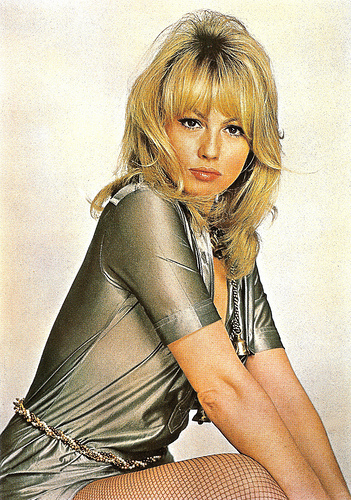
French postcard by E.D.U.G., no. 501. Photo: Sam Lévin.
Seduction Scene
Marie-Helene Demongeot was born in Nice, France in 1935 into a family of actors. Her parents met in Shanghai, China, and moved to Nice, France.
Her mother, Klaudia Trubnikova, was a Russian-Ukrainean emigre from Kharkiv who escaped from the horrors of the Russian Civil War. Her father, Alfred Demongeot, was of French-Italian heritage. The family was bilingual and young Demongeot was able to use Russian and French, but eventually switched to French. She grew up in Nice.
After the war, at the age of 13 she went to Paris and continued her education there. She studied piano under the tutelage of Marguerite Long and Yves Nat. At the age of 15 she became a model in the atelier of Pierre Cardin, and studied dramatic art with Marie Ventura at Le Cours Simon in Paris.
Two years later she made her film debut with a supporting role in Les enfants de l'amour/Children of Love (Léonide Moguy, 1953) starring Etchika Choureau .
More small roles followed in Futures Vedettes/Joy of Living (Marc Allégret, 1955) with Brigitte Bardot , and the British musical comedy It's a Wonderful World (Val Guest, 1956).
Then she had her breakthrough at the side of Yves Montand and Simone Signoret with a memorable seduction scene in Les sorcières de Salem/The Crucible (Raymond Rouleau, 1957), based on the play by Arthur Miller.
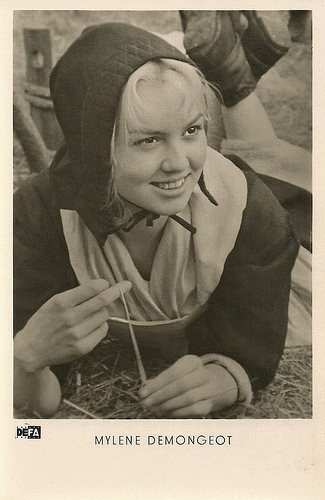
German postcard. Photo: DEFA. Publicity still for Les sorcières de Salem (1957).
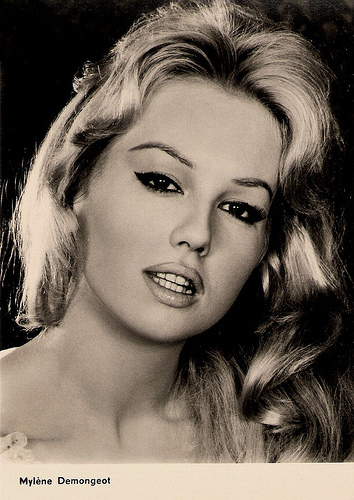
East-German postcard by VEB Progress Film-Vertrieb, Berlin, no. 1852, 1963. Retail Price: 0,20 DM. Photo: Progress.
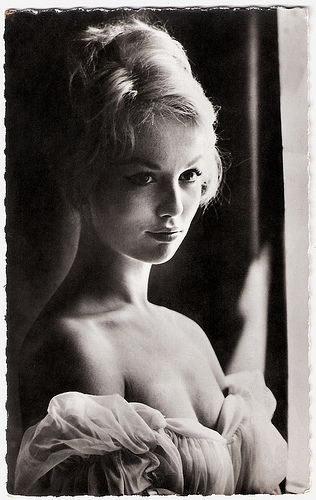
French postcard by Editions P.I., Paris, no. 1039, offered by Les Carbones Korès 'Carboplane. Photo: H. Coste.
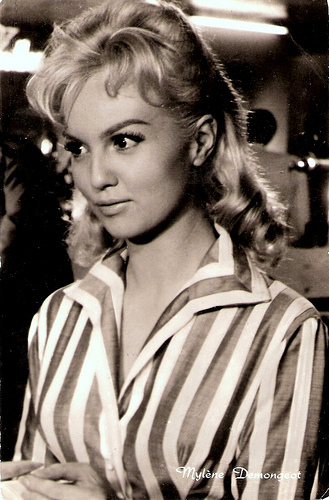
Dutch postcard by IFP, Amsterdam, no. 3014.
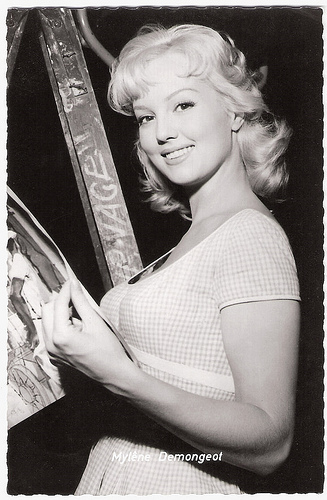
German postcard by Kolibri-Verlag G.m.b.H, Minden/Westf. Sent by mail in the Netherlands in 1964.
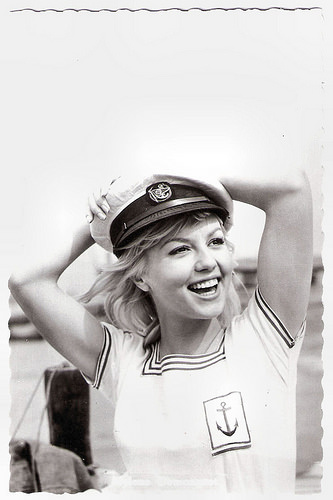
Dutch postcard by Uitg. N.V. v.h. Weenenk & Snel, Baarn, no. 133.
Manipulative but Humorous
With appearances in three or four feature films every year, Mylène Demongeot would rise to international fame in the late 1950s.
Demongeot's first notable leading role was in Sois belle et tais-toi/Be Beautiful But Shut Up (Marc Allégret, 1958) opposite Henri Vidal , where she played a 17-year-old jewel smuggler.
She further developed her screen image of a manipulative but humorous blond mistress opposite David Niven in Bonjour tristesse (Otto Preminger, 1958, and opposite Alain Delon in the comedy Faibles femmes/Three Murderesses (Michel Boisrond, 1959).
Many of her screen assignments were along the ooh-la-la lines of her Swedish maid in the British Upstairs, Downstairs (Ralph Thomas, 1959).
In Italy she played opposite Steve Reeves in the Peplum (sword and sandal epic) La battaglia di Maratona/Giant of Marathon (Jacques Tourneur, 1959), with Rosanna Schiaffino and Elsa Martinelli in La notte brava/Bad Girls Don't Cry (Mauro Bolognini, 1959) based on a script by Pier Paolo Pasolini, again with Elsa Martinelli in the comedy Un amore a Roma/Love in Rome (Dino Risi, 1960) and with Roger Moore in Il ratto delle sabine/Romulus and the Sabines (Richard Pottier, 1961).
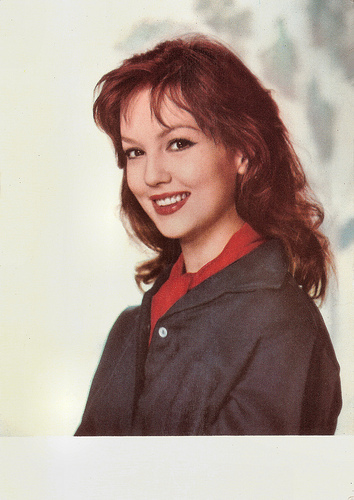
French postcard by Editions P.I., Paris, no. 1022. Photo: Sam Lévin.
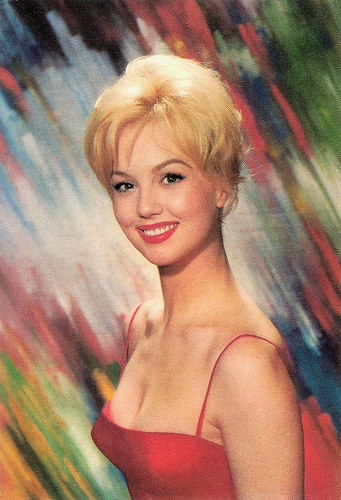
Spanish postcard by Oscarcolor, no. 268.
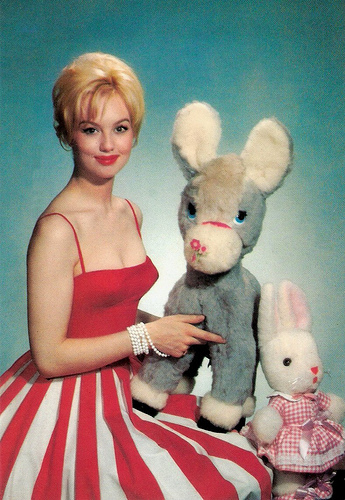
Spanish postcard by Oscarcolor, no. 266.
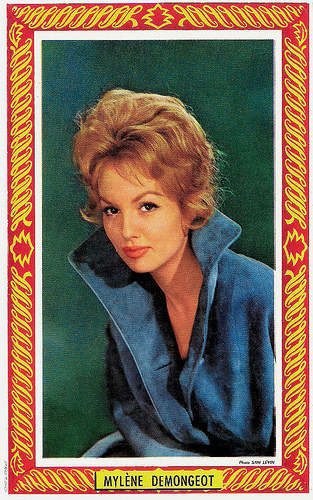
French postcard by St. Anne, Marseille. Photo: Sam Lévin.
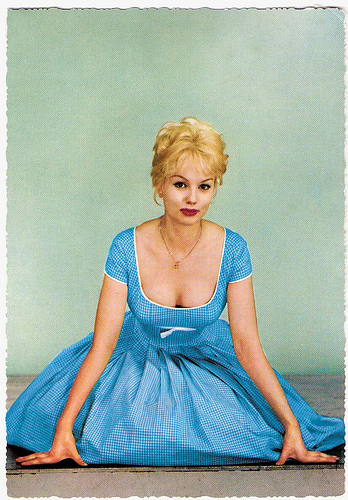
German postcard by Krüger, no. 902/41. Photo: Sam Lévin.
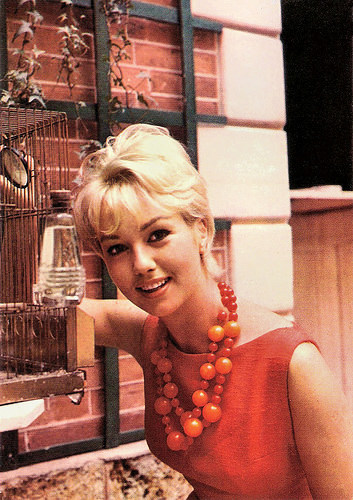
French postcard by Editions Borde, Paris, no. 130. Photo: Morel.
Milady de Winter
Among Mylène Demongeot's best known film-works are the role of manipulative Milady de Winter in the two-part adventure film Les trois mousquetaires/The Three Musketeers (Bernard Borderie, 1961) and the role of Helen in the Fantômas trilogy (André Hunebelle, 1964-1967), co-starring with Jean Marais and Louis de Funès .
Other incidental interesting films were À cause, à cause d'une femme (Michel Deville, 1963) with Jacques Charrier , the comedy 12 + 1 (Nicolas Gessner, 1969) with Sharon Tate, and the Canadian drama Quelques arpents de neige/A Few Acres of Snow (Denis Héroux, 1972).
Although she gradually fazed out of her stereotypical image of a beautiful French coquette, she still looked pretty convincing in the image of a mid-aged Madame, which she developed in the 1980s in films like Tenue de soirée/Evening Dress (1986, Bertrand Blier) starring Gérard Depardieu .
On TV she appeared in the detective series Il professore/Big Man (Steno, 1988-1989) starring Bud Spencer , and in The Man Who Lived at the Ritz (Desmond Davis, 1988).
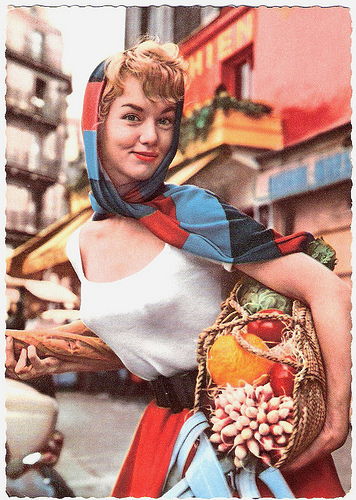
German postcard by Universum-Film Aktiengesellschaft (UFA), Berlin-Tempelhof, no. CK 150. Retail price: 30 Pfg. Photo: Klaus Collignon / UFA.
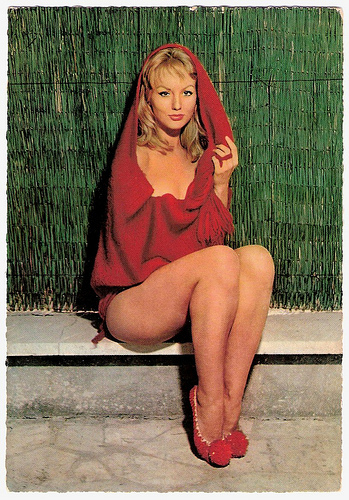
German postcard by Krüger, no. 902/66. Photo: Bernard of Hollywood.

German postcard by Krüger, no. 902/326. Photo: Gérard Decaux.

German postcard by Krüger, no. 902/327. Photo: Gérard Decaux.
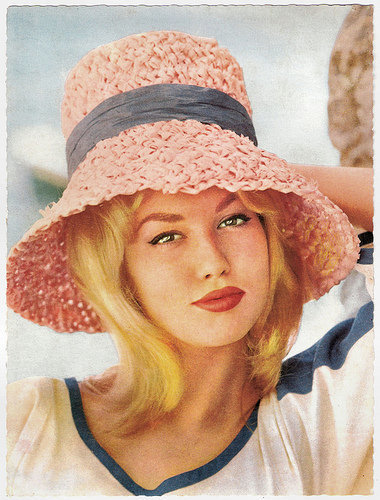
Big Dutch postcard, no. 608.
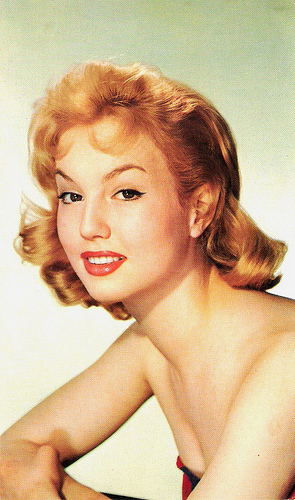
French postcard by E.D.U.G., offered by Corvisart, Epinal, no. 29. Photo: Sam Lévin.
Comeback
Mylène Demongeot was the co-owner of Kangarou Films, a production company she had founded with her late husband, director Marc Simenon, the son of Georges Simenon.
During the 1970s and 1980s they produced a number of unsuccessful films like Par le sang des autres/By the Blood of Others (Marc Simenon, 1974) and Signé Furax/Signed Furax (Marc Simenon, 1981). Marc Simenon died in 1999.
Demongeot made a comeback in the crime drama 36 Quai des Orfevres/Department 36 (Olivier Marchal, 2004) starring Daniel Auteuil, and Victoire (Stephanie Murat, 2004) as the mother of Sylvie Testud.
Later films were La Californie/French California (Jacques Fieschi, 2006) based on a short story by Georges Simenon, the hit comedy Camping (Fabien Onteniente, 2006), and the sequel Camping 2 (Fabien Onteniente, 2010). With director Hiner Saleem, she made Sous les toits de Paris/Beneath the Rooftops of Paris (Hiner Saleem, 2007) and Si tu meurs, je te tue/If You Die, I'll Kill You (Hiner Saleem, 2011).
Demongeot also wrote several books, the best known are Tiroirs Secrets (Secret drawers, 2001) and Animalement vôtre (Animally Yours.2005). In the 2000s Demongeot made a pilgrimage to the birthplace of her mother in Kharkiv, Ukraine. There she planted a commemorative tree and presented her autobiographical book, Les Lilas de Kharkov (The Lilacs of Kharkiv, 1990).
In 2006 she was named Commander in the Order of Arts and Letters for her achievements in acting. Mylène Demongeot is currently residing in Nice in the south of France.
Her latest films include the comedy-drama Elle s'en va/On My Way (Emmanuelle Bercot, 2013), starring Catherine Deneuve , and Camping 3 (Fabien Onteniente, 2016), which became the second highest-grossing domestic film in France in 2016, with 3,228,313 tickets sold.
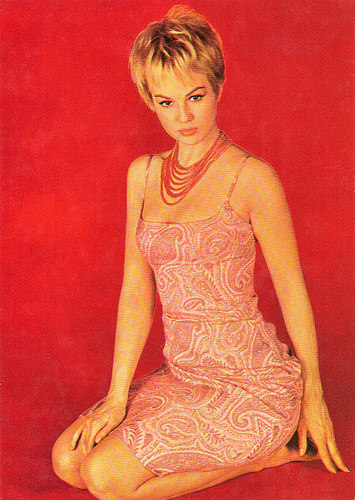
Romanian postcard by Casa Filmului Acin, no. 558.
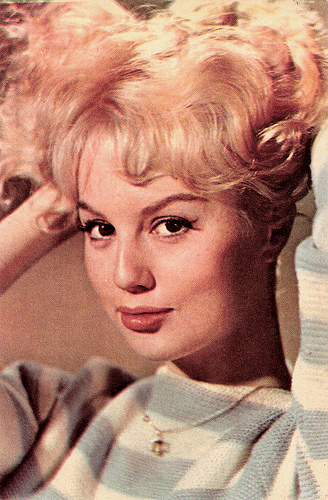
Belgian postcard by Cox, no. 42.
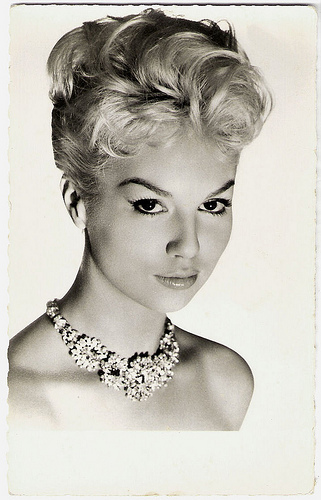
French postcard by Editions P.I., Paris, no. 955. Photo: Sam Lévin.
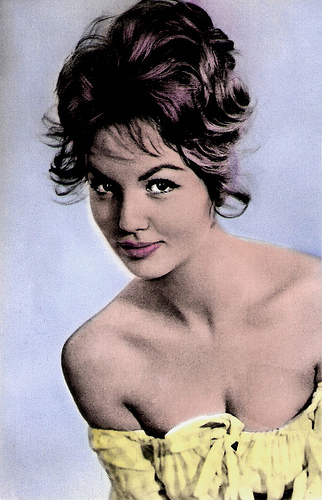
Yugoslavian postcard by Studio Sombor, no. 294.
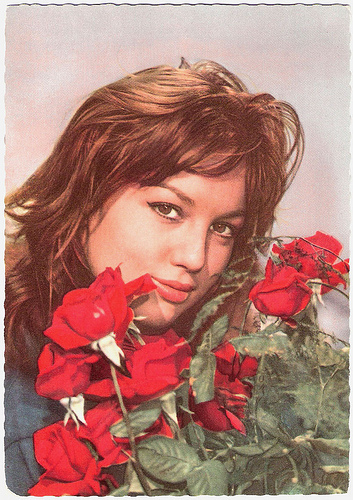
German postcard by UFA (Universum-Film Aktiengesellschaft), Berlin-Tempelhof, no. CK-268. Retail price: 300 Pfg. Photo: UFA.
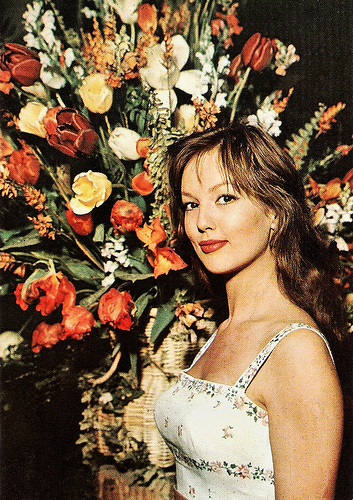
French postcard by Editions P.I., Paris, no. 1035. Photo: D. Roger.
Sources: (IMDb), Hal Erickson (AllMovie), Personal website (French), Allociné (French), Wikipedia, and

German postcard by Kruger, no. 902/162.

French postcard by Editions P.I., Paris, no. 1066. Photo: Dimitri/Dalmas.

German postcard by Kruger, no. 902/76.

French postcard by Editions P.I., Paris, no. 1014. Photo: Sam Lévin.

French postcard by E.D.U.G., no. 143. Photo: Sam Lévin.

French postcard by E.D.U.G., no. 501. Photo: Sam Lévin.
Seduction Scene
Marie-Helene Demongeot was born in Nice, France in 1935 into a family of actors. Her parents met in Shanghai, China, and moved to Nice, France.
Her mother, Klaudia Trubnikova, was a Russian-Ukrainean emigre from Kharkiv who escaped from the horrors of the Russian Civil War. Her father, Alfred Demongeot, was of French-Italian heritage. The family was bilingual and young Demongeot was able to use Russian and French, but eventually switched to French. She grew up in Nice.
After the war, at the age of 13 she went to Paris and continued her education there. She studied piano under the tutelage of Marguerite Long and Yves Nat. At the age of 15 she became a model in the atelier of Pierre Cardin, and studied dramatic art with Marie Ventura at Le Cours Simon in Paris.
Two years later she made her film debut with a supporting role in Les enfants de l'amour/Children of Love (Léonide Moguy, 1953) starring Etchika Choureau .
More small roles followed in Futures Vedettes/Joy of Living (Marc Allégret, 1955) with Brigitte Bardot , and the British musical comedy It's a Wonderful World (Val Guest, 1956).
Then she had her breakthrough at the side of Yves Montand and Simone Signoret with a memorable seduction scene in Les sorcières de Salem/The Crucible (Raymond Rouleau, 1957), based on the play by Arthur Miller.

German postcard. Photo: DEFA. Publicity still for Les sorcières de Salem (1957).

East-German postcard by VEB Progress Film-Vertrieb, Berlin, no. 1852, 1963. Retail Price: 0,20 DM. Photo: Progress.

French postcard by Editions P.I., Paris, no. 1039, offered by Les Carbones Korès 'Carboplane. Photo: H. Coste.

Dutch postcard by IFP, Amsterdam, no. 3014.

German postcard by Kolibri-Verlag G.m.b.H, Minden/Westf. Sent by mail in the Netherlands in 1964.

Dutch postcard by Uitg. N.V. v.h. Weenenk & Snel, Baarn, no. 133.
Manipulative but Humorous
With appearances in three or four feature films every year, Mylène Demongeot would rise to international fame in the late 1950s.
Demongeot's first notable leading role was in Sois belle et tais-toi/Be Beautiful But Shut Up (Marc Allégret, 1958) opposite Henri Vidal , where she played a 17-year-old jewel smuggler.
She further developed her screen image of a manipulative but humorous blond mistress opposite David Niven in Bonjour tristesse (Otto Preminger, 1958, and opposite Alain Delon in the comedy Faibles femmes/Three Murderesses (Michel Boisrond, 1959).
Many of her screen assignments were along the ooh-la-la lines of her Swedish maid in the British Upstairs, Downstairs (Ralph Thomas, 1959).
In Italy she played opposite Steve Reeves in the Peplum (sword and sandal epic) La battaglia di Maratona/Giant of Marathon (Jacques Tourneur, 1959), with Rosanna Schiaffino and Elsa Martinelli in La notte brava/Bad Girls Don't Cry (Mauro Bolognini, 1959) based on a script by Pier Paolo Pasolini, again with Elsa Martinelli in the comedy Un amore a Roma/Love in Rome (Dino Risi, 1960) and with Roger Moore in Il ratto delle sabine/Romulus and the Sabines (Richard Pottier, 1961).

French postcard by Editions P.I., Paris, no. 1022. Photo: Sam Lévin.

Spanish postcard by Oscarcolor, no. 268.

Spanish postcard by Oscarcolor, no. 266.

French postcard by St. Anne, Marseille. Photo: Sam Lévin.

German postcard by Krüger, no. 902/41. Photo: Sam Lévin.

French postcard by Editions Borde, Paris, no. 130. Photo: Morel.
Milady de Winter
Among Mylène Demongeot's best known film-works are the role of manipulative Milady de Winter in the two-part adventure film Les trois mousquetaires/The Three Musketeers (Bernard Borderie, 1961) and the role of Helen in the Fantômas trilogy (André Hunebelle, 1964-1967), co-starring with Jean Marais and Louis de Funès .
Other incidental interesting films were À cause, à cause d'une femme (Michel Deville, 1963) with Jacques Charrier , the comedy 12 + 1 (Nicolas Gessner, 1969) with Sharon Tate, and the Canadian drama Quelques arpents de neige/A Few Acres of Snow (Denis Héroux, 1972).
Although she gradually fazed out of her stereotypical image of a beautiful French coquette, she still looked pretty convincing in the image of a mid-aged Madame, which she developed in the 1980s in films like Tenue de soirée/Evening Dress (1986, Bertrand Blier) starring Gérard Depardieu .
On TV she appeared in the detective series Il professore/Big Man (Steno, 1988-1989) starring Bud Spencer , and in The Man Who Lived at the Ritz (Desmond Davis, 1988).

German postcard by Universum-Film Aktiengesellschaft (UFA), Berlin-Tempelhof, no. CK 150. Retail price: 30 Pfg. Photo: Klaus Collignon / UFA.

German postcard by Krüger, no. 902/66. Photo: Bernard of Hollywood.

German postcard by Krüger, no. 902/326. Photo: Gérard Decaux.

German postcard by Krüger, no. 902/327. Photo: Gérard Decaux.

Big Dutch postcard, no. 608.

French postcard by E.D.U.G., offered by Corvisart, Epinal, no. 29. Photo: Sam Lévin.
Comeback
Mylène Demongeot was the co-owner of Kangarou Films, a production company she had founded with her late husband, director Marc Simenon, the son of Georges Simenon.
During the 1970s and 1980s they produced a number of unsuccessful films like Par le sang des autres/By the Blood of Others (Marc Simenon, 1974) and Signé Furax/Signed Furax (Marc Simenon, 1981). Marc Simenon died in 1999.
Demongeot made a comeback in the crime drama 36 Quai des Orfevres/Department 36 (Olivier Marchal, 2004) starring Daniel Auteuil, and Victoire (Stephanie Murat, 2004) as the mother of Sylvie Testud.
Later films were La Californie/French California (Jacques Fieschi, 2006) based on a short story by Georges Simenon, the hit comedy Camping (Fabien Onteniente, 2006), and the sequel Camping 2 (Fabien Onteniente, 2010). With director Hiner Saleem, she made Sous les toits de Paris/Beneath the Rooftops of Paris (Hiner Saleem, 2007) and Si tu meurs, je te tue/If You Die, I'll Kill You (Hiner Saleem, 2011).
Demongeot also wrote several books, the best known are Tiroirs Secrets (Secret drawers, 2001) and Animalement vôtre (Animally Yours.2005). In the 2000s Demongeot made a pilgrimage to the birthplace of her mother in Kharkiv, Ukraine. There she planted a commemorative tree and presented her autobiographical book, Les Lilas de Kharkov (The Lilacs of Kharkiv, 1990).
In 2006 she was named Commander in the Order of Arts and Letters for her achievements in acting. Mylène Demongeot is currently residing in Nice in the south of France.
Her latest films include the comedy-drama Elle s'en va/On My Way (Emmanuelle Bercot, 2013), starring Catherine Deneuve , and Camping 3 (Fabien Onteniente, 2016), which became the second highest-grossing domestic film in France in 2016, with 3,228,313 tickets sold.

Romanian postcard by Casa Filmului Acin, no. 558.

Belgian postcard by Cox, no. 42.

French postcard by Editions P.I., Paris, no. 955. Photo: Sam Lévin.

Yugoslavian postcard by Studio Sombor, no. 294.

German postcard by UFA (Universum-Film Aktiengesellschaft), Berlin-Tempelhof, no. CK-268. Retail price: 300 Pfg. Photo: UFA.

French postcard by Editions P.I., Paris, no. 1035. Photo: D. Roger.
Sources: (IMDb), Hal Erickson (AllMovie), Personal website (French), Allociné (French), Wikipedia, and
Published on January 23, 2017 22:00
January 22, 2017
Michael York
English actor Michael York (1942) is the athletic star of several Shakespeare adaptations and three popular Musketeer films. His blond, blue-eyed boyish looks and plummy accent incarnated a traditionally English public-school manliness in such classic films as Joseph Losey's Accident (1967) and Cabaret (1972).
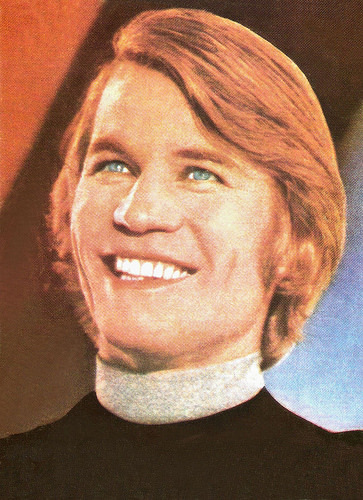
Romanian postcard by Casa Filmului Acin. Photo: publicity still for Logan's Run (Michael Anderson, 1976).

Romanian postcard by Casa Filmului Acin, no. C.P.C.S. 43033.
Something for Everyone
Michael York, OBE was born Michael Hugh Johnson in 1942, in Fulmer, Buckinghamshire. He is the son of Florence Edith May (née Chown), a musician; and Joseph Gwynne Johnson, an executive with Marks & Spencer department stores.
At age three, Michael broke his nose when he jumped off the roof of a coal house while trying to fly. During his teenage years, York was educated at Bromley Grammar School for Boys, Hurstpierpoint College and University College, Oxford.
He began his career in a 1956 production of The Yellow Jacket. In 1959 he made his West End debut with a small part in a production of Hamlet. York was a member of National Youth Theatre in London's East End and on international tour. He also performed with the Oxford University Dramatic Society and the University College Players. In 1964, he graduated from the University of Oxford with a degree in English.
After some time with the Dundee Repertory Theatre, where he played in Brendan Behan's The Hostage, York joined the National Theatre under Laurence Olivier where he worked with Franco Zeffirelli during the 1965 staging of Much Ado About Nothing.
Following his role on British TV as Jolyon (Jolly) in The Forsyte Saga (1967), York made his film debut as Lucentio in William Shakespeare’s The Taming of the Shrew (Franco Zeffirelli, 1967), starring Elizabeth Taylor and Richard Burton . He also appeared in Accident (Joseph Losey, 1967), Harold Pinter's dramatic film adaptation of the 1965 novel by Nicholas Mosley. At the 1967 Cannes Film Festival the film won the award for Grand Prix Spécial du Jury.
Then York was cast as Tybalt Capulet in Zeffirelli’s innovative Romeo and Juliet (Franco Zeffirelli, 1968). He starred in The Guru (James Ivory, 1969) as a rock star who wants to learn to play the sitar, and he played an amoral bisexual drifter in the black comedy Something for Everyone (Harold Prince, 1970) with Angela Lansbury.
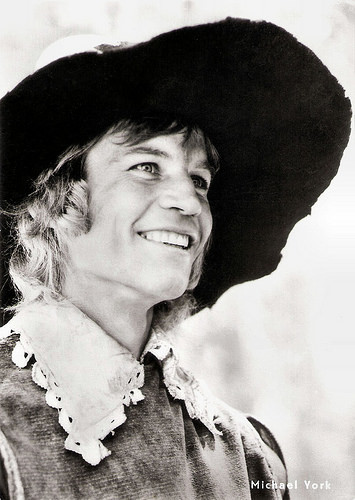
East-German postcard by Progress Film-Verleih, Berlin, no. 115/76. Photo: publicity still for The Three Musketeers (Richard Lester, 1973).
Cabaret
Michael York starred in the British World War I action-drama Zeppelin (Étienne Périer, 1971), which depicts a fictitious German attempt to raid on Great Britain in a giant Zeppelin to steal the Magna Carta from its hiding place in one of Scotland's castles.
He then portrayed the bisexual Brian Roberts in Bob Fosse's film version of Cabaret (1972) opposite Liza Minelli. Cabaret opened to glowing reviews and strong box office, eventually taking in more than $20 million. The film won eight Oscars and seven British Academy Film Awards.
York then starred as D'Artagnan in Alexandre Dumas’ The Three Musketeers (Richard Lester, 1973), and he made his Broadway debut in the original production of Tennessee Williams's Out Cry. One year later the sequel to The Three Musketeers was released (roughly covering events in the second half of the book) titled The Four Musketeers (Richard Lester, 1974). Fifteen years later, most of the cast and crew joined together in a third film titled The Return of the Musketeers (Richard Lester, 1989), based on the Alexandre Dumas novel Twenty Years After.
York was among the ensemble cast of the British mystery film Murder on the Orient Express (Sidney Lumet, 1974), based on the 1934 novel by Agatha Christie. It was another box-office hit. He played a young officer in India in the British drama Conduct Unbecoming (Michael Anderson, 1975), and the title character in the American science fiction film Logan's Run (Michael Anderson, 1976).
The following year, he starred opposite Burt Lancaster in The Island of Dr. Moreau (Don Taylor, 1977), based on H.G. Wells novel of the same name. He also reunited with Zeffirelli as John the Baptist in the TV mini-series Jesus of Nazareth (Franco Zeffirelli, 1977), starring Robert Powell as Jesus, and he played Marty Feldman’s twin brother in the American historical comedy The Last Remake of Beau Geste (Marty Feldman, 1977).
His next films, Fedora (Billy Wilder, 1978), the English spy thriller The Riddle of the Sands (Tony Maylam, 1979) and the Canadian spy caper Final Assignment (Paul Almond, 1980) were all box office flops, and York started to work more and more for television.
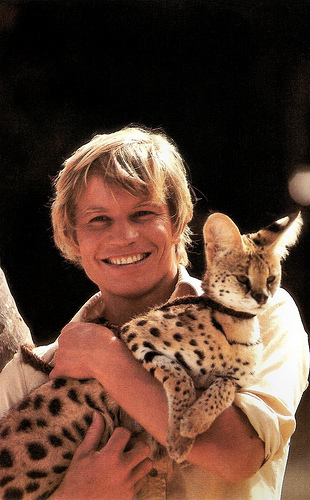
American postcard by Coral-Lee, Rancho Cordova, CA, no. Cl/Personality #48-1979. Photo: Douglas Kirkland / Contact.
International Man of Mystery
In the following decades, Michael York enjoyed a busy and varied career in television and on the stage. On television he starred in such TV films as The Master of Ballantrae (Douglas Hickox, 1984), Sword of Gideon (Michael Anderson, 1986), and The Lady and the Highwayman (John Hough, 1989), and he appeared in two episodes of the series Road to Avonlea (1991).
His Broadway theatre credits include Bent (1980), The Crucible (1992), Someone Who'll Watch Over Me (1993) and the ill-fated musical The Little Prince and the Aviator (1982), which closed during previews. He also has made many sound recordings as a reader, including Harper Audio's production of C. S. Lewis' The Lion, the Witch and the Wardrobe.
He kept returning to the cinema. Remarkable was the French-British drama Success Is the Best Revenge (Jerzy Skolimowski, 1984), which was entered into the 1984 Cannes Film Festival. He appeared in the Dutch costume drama Eline Vere (Harry Kümel, 1991). He played Basil Exposition in Austin Powers: International Man of Mystery (Jay Roach, 1997) and its two sequels. He was also in the action-adventure The Omega Code (Robert Marcarelli, 1999) with Casper Van Dien.
On TV, he appeared as Mason Fairbanks, Homer Simpson's possible father in an 2006 episode of The Simpsons, and played the character Bernard Fremont (inspired by real life serial killer Charles Sobhraj) in the Law & Order: Criminal Intent episode Slither (2006). In 2009, he lent his voice to Star Wars: The Clone Wars, and in 2016, he returned to The Simpsons as Dr. Budgie.
In the cinema, he was seen in the remarkable Polish film Młyn i krzyż/The Mill and the Cross (Lech Majewski, 2011), starring Rutger Hauer . His autobiography (1993) was issued as Accidentally on Purpose in the U.S. and Travelling Player in Britain. He also co-wrote a book with Adrian Brine called A Shakespearean actor prepares.
York was awarded the OBE (Officer of the Order of the British Empire) in the 1996 Queen's Birthday Honours List for his services to drama. Michael York is married to photographer Patricia McCallum. They met in 1967 when she was assigned to photograph him, and they married in 1968. His stepson is Star Wars producer Rick McCallum. In 2013, York announced he was suffering from the rare disease amyloidosis (a blood disorder). Doctors initially thought he had bone cancer, and in 2012, he had undergone a stem cell transplant, which can alleviate symptoms.
Trailer Cabaret (1972). Source: Warner Movies On Demand (YouTube).
Trailer The Three Musketeers (Richard Lester, 1973). Source: TheTrailerGal (YouTube).
Trailer for Logan's Run (Michael Anderson, 1976). Source: Movieclips Trailer Vault (YouTube).
Sources: Andrew Spicer (Encyclopedia of British Film), (IMDb), Wikipedia and .

Romanian postcard by Casa Filmului Acin. Photo: publicity still for Logan's Run (Michael Anderson, 1976).

Romanian postcard by Casa Filmului Acin, no. C.P.C.S. 43033.
Something for Everyone
Michael York, OBE was born Michael Hugh Johnson in 1942, in Fulmer, Buckinghamshire. He is the son of Florence Edith May (née Chown), a musician; and Joseph Gwynne Johnson, an executive with Marks & Spencer department stores.
At age three, Michael broke his nose when he jumped off the roof of a coal house while trying to fly. During his teenage years, York was educated at Bromley Grammar School for Boys, Hurstpierpoint College and University College, Oxford.
He began his career in a 1956 production of The Yellow Jacket. In 1959 he made his West End debut with a small part in a production of Hamlet. York was a member of National Youth Theatre in London's East End and on international tour. He also performed with the Oxford University Dramatic Society and the University College Players. In 1964, he graduated from the University of Oxford with a degree in English.
After some time with the Dundee Repertory Theatre, where he played in Brendan Behan's The Hostage, York joined the National Theatre under Laurence Olivier where he worked with Franco Zeffirelli during the 1965 staging of Much Ado About Nothing.
Following his role on British TV as Jolyon (Jolly) in The Forsyte Saga (1967), York made his film debut as Lucentio in William Shakespeare’s The Taming of the Shrew (Franco Zeffirelli, 1967), starring Elizabeth Taylor and Richard Burton . He also appeared in Accident (Joseph Losey, 1967), Harold Pinter's dramatic film adaptation of the 1965 novel by Nicholas Mosley. At the 1967 Cannes Film Festival the film won the award for Grand Prix Spécial du Jury.
Then York was cast as Tybalt Capulet in Zeffirelli’s innovative Romeo and Juliet (Franco Zeffirelli, 1968). He starred in The Guru (James Ivory, 1969) as a rock star who wants to learn to play the sitar, and he played an amoral bisexual drifter in the black comedy Something for Everyone (Harold Prince, 1970) with Angela Lansbury.

East-German postcard by Progress Film-Verleih, Berlin, no. 115/76. Photo: publicity still for The Three Musketeers (Richard Lester, 1973).
Cabaret
Michael York starred in the British World War I action-drama Zeppelin (Étienne Périer, 1971), which depicts a fictitious German attempt to raid on Great Britain in a giant Zeppelin to steal the Magna Carta from its hiding place in one of Scotland's castles.
He then portrayed the bisexual Brian Roberts in Bob Fosse's film version of Cabaret (1972) opposite Liza Minelli. Cabaret opened to glowing reviews and strong box office, eventually taking in more than $20 million. The film won eight Oscars and seven British Academy Film Awards.
York then starred as D'Artagnan in Alexandre Dumas’ The Three Musketeers (Richard Lester, 1973), and he made his Broadway debut in the original production of Tennessee Williams's Out Cry. One year later the sequel to The Three Musketeers was released (roughly covering events in the second half of the book) titled The Four Musketeers (Richard Lester, 1974). Fifteen years later, most of the cast and crew joined together in a third film titled The Return of the Musketeers (Richard Lester, 1989), based on the Alexandre Dumas novel Twenty Years After.
York was among the ensemble cast of the British mystery film Murder on the Orient Express (Sidney Lumet, 1974), based on the 1934 novel by Agatha Christie. It was another box-office hit. He played a young officer in India in the British drama Conduct Unbecoming (Michael Anderson, 1975), and the title character in the American science fiction film Logan's Run (Michael Anderson, 1976).
The following year, he starred opposite Burt Lancaster in The Island of Dr. Moreau (Don Taylor, 1977), based on H.G. Wells novel of the same name. He also reunited with Zeffirelli as John the Baptist in the TV mini-series Jesus of Nazareth (Franco Zeffirelli, 1977), starring Robert Powell as Jesus, and he played Marty Feldman’s twin brother in the American historical comedy The Last Remake of Beau Geste (Marty Feldman, 1977).
His next films, Fedora (Billy Wilder, 1978), the English spy thriller The Riddle of the Sands (Tony Maylam, 1979) and the Canadian spy caper Final Assignment (Paul Almond, 1980) were all box office flops, and York started to work more and more for television.

American postcard by Coral-Lee, Rancho Cordova, CA, no. Cl/Personality #48-1979. Photo: Douglas Kirkland / Contact.
International Man of Mystery
In the following decades, Michael York enjoyed a busy and varied career in television and on the stage. On television he starred in such TV films as The Master of Ballantrae (Douglas Hickox, 1984), Sword of Gideon (Michael Anderson, 1986), and The Lady and the Highwayman (John Hough, 1989), and he appeared in two episodes of the series Road to Avonlea (1991).
His Broadway theatre credits include Bent (1980), The Crucible (1992), Someone Who'll Watch Over Me (1993) and the ill-fated musical The Little Prince and the Aviator (1982), which closed during previews. He also has made many sound recordings as a reader, including Harper Audio's production of C. S. Lewis' The Lion, the Witch and the Wardrobe.
He kept returning to the cinema. Remarkable was the French-British drama Success Is the Best Revenge (Jerzy Skolimowski, 1984), which was entered into the 1984 Cannes Film Festival. He appeared in the Dutch costume drama Eline Vere (Harry Kümel, 1991). He played Basil Exposition in Austin Powers: International Man of Mystery (Jay Roach, 1997) and its two sequels. He was also in the action-adventure The Omega Code (Robert Marcarelli, 1999) with Casper Van Dien.
On TV, he appeared as Mason Fairbanks, Homer Simpson's possible father in an 2006 episode of The Simpsons, and played the character Bernard Fremont (inspired by real life serial killer Charles Sobhraj) in the Law & Order: Criminal Intent episode Slither (2006). In 2009, he lent his voice to Star Wars: The Clone Wars, and in 2016, he returned to The Simpsons as Dr. Budgie.
In the cinema, he was seen in the remarkable Polish film Młyn i krzyż/The Mill and the Cross (Lech Majewski, 2011), starring Rutger Hauer . His autobiography (1993) was issued as Accidentally on Purpose in the U.S. and Travelling Player in Britain. He also co-wrote a book with Adrian Brine called A Shakespearean actor prepares.
York was awarded the OBE (Officer of the Order of the British Empire) in the 1996 Queen's Birthday Honours List for his services to drama. Michael York is married to photographer Patricia McCallum. They met in 1967 when she was assigned to photograph him, and they married in 1968. His stepson is Star Wars producer Rick McCallum. In 2013, York announced he was suffering from the rare disease amyloidosis (a blood disorder). Doctors initially thought he had bone cancer, and in 2012, he had undergone a stem cell transplant, which can alleviate symptoms.
Trailer Cabaret (1972). Source: Warner Movies On Demand (YouTube).
Trailer The Three Musketeers (Richard Lester, 1973). Source: TheTrailerGal (YouTube).
Trailer for Logan's Run (Michael Anderson, 1976). Source: Movieclips Trailer Vault (YouTube).
Sources: Andrew Spicer (Encyclopedia of British Film), (IMDb), Wikipedia and .
Published on January 22, 2017 22:00
January 21, 2017
Imported from the USA: Robert De Niro
Legendary American actor Robert De Niro (1943) has starred in such classic films as Taxi Driver (1976), Novecento/1900 (1978), The Deer Hunter (1978), Awakenings (1990) and GoodFellas (1990). His role in The Godfather: Part II (1974) brought him his first Academy Award, and he scored his second Oscar for his portrayal of Jake La Motta in Raging Bull (1980). De Niro worked with many acclaimed film directors, including Brian DePalma, Francis Coppola, Elia Kazan, Bernardo Bertolucci and, most importantly, Martin Scorsese. He also appeared in French, British and Italian films.
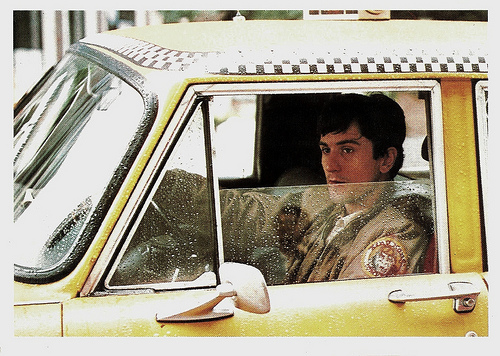
French postcard in the Collection Cinema Couleur by Edition La Malibran, Paris, no. MC 33, 1990. Photo: publicity still for Taxi Driver (Martin Scorsese, 1976).
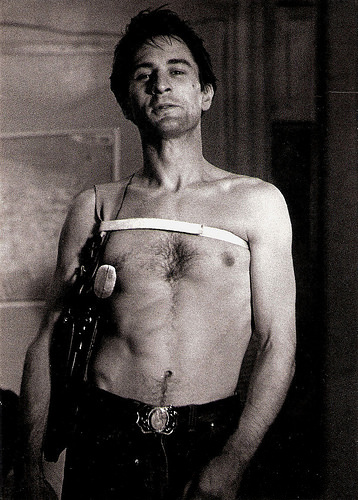
Belgian promotion card by Tasschen Gallery for the exhibition 'Taxi Driver - unseen photographs from Scorsese's Masterpiece'. Photo: Steve Schapiro. Publicity still for Taxi Driver (Martin Scorsese, 1976).
The most chilling performance of his career
Robert Anthony De Niro was born in the Greenwich Village area of Manhattan, New York City in 1943. His mother, Virginia Admiral, was a cerebral and gifted painter, and his father, Robert De Niro Sr., was a painter, sculptor and poet whose work received high critical acclaim. They split ways in 1945, when young Robert was only 2 years old, after his father announced that he was gay.
De Niro was raised primarily by his mother, who took on work as a typesetter and printer in order to support her son. A bright and energetic child, Robert De Niro was incredibly fond of attending films with his father when they spent time together. De Niro's mother worked part-time as a typist and copy editor for Maria Picator's Dramatic Workshop, and as part of her compensation, De Niro was allowed to take children's acting classes for free. At the age of 10, De Niro made his stage debut as the Cowardly Lion in a school production of The Wizard of Oz.
De Niro proved to be uninterested in school altogether and, as a teenager, joined a rather tame street gang in Little Italy that gave him the nickname Bobby Milk, in reference to his pale complexion. While De Niro was by all accounts only a very modest troublemaker, the gang provided him with experience to skilfully portray Italian mobsters as an actor.
He left school at age 16 to study acting Stella Adler Conservatory. Adler, who had taught Marlon Brando and Rod Steiger, was a strong proponent of the Stanislavski method of acting, involving deep psychological character investigation. He studied briefly with Lee Strasberg at the Actor's Studio in New York City, and then began auditioning.
After a momentary cameo in the French film Trois chambres à Manhattan/Three Rooms in Manhattan (Marcel Carné, 1965), De Niro's real film debut came in Greetings (Brian De Palma, 1968). However, De Niro's first film role already came at the age of 20, when he appeared credited as Robert Denero in De Palma’s The Wedding Party (Brian De Palma, Wilford Leach, 1963), but the film was not released until 1969.
He then appeared in Roger Corman's film Bloody Mama (1970), featuring Shelley Winters . His breakthrough performances came a few years later in two highly acclaimed films: the sports drama Bang the Drum Slowly (John D. Hancock, 1973), in which he played a terminally ill catcher on a baseball team, and the crime film Mean Streets (1973), his first of many collaborations with director Martin Scorsese, in which he played street thug Johnny Boy opposite Harvey Keitel.
De Niro and Martin Scorsese worked successfully together on eight films: Mean Streets (1973), Taxi Driver (1976), New York, New York (1977), Raging Bull (1980), The King of Comedy (1983), Goodfellas (1990), Cape Fear (1991), and Casino (1995).
In 1974, De Niro established himself as one America’s finest actors with his Academy Award-winning portrayal of the young Vito Corleone in The Godfather: Part II (Francis Ford Coppola, 1974), a role for which he learned to speak Sicilian.
Two years later, De Niro delivered perhaps the most chilling performance of his career, playing vengeful cabbie Travis Bickle in Taxi Driver (Martin Scorsese, 1976) alongside Jodie Foster. His iconic performance as Travis Bickle catapulted him to stardom and forever linked his name with Bickle's famous 'You talkin' to me?' monologue, which De Niro largely improvised.
In Italy, De Niro appeared opposite Gérard Dépardieu in the epic historical drama Novecento/1900 (Bernardo Bertolucci, 1976). The film is an exploration of life in Italy in the first half of the 20th century, seen through the eyes of two Italian childhood friends at the opposite sides of society's hierarchy.
He also starred in The Last Tycoon (1976), the last film directed by Elia Kazan. The Hollywood drama is based upon Harold Pinter's screenplay adaptation of F. Scott Fitzgerald's The Last Tycoon, De Niro continued to show his tremendous skill as a dramatic actor in the Vietnam war drama The Deer Hunter (Michael Cimino, 1978). The film follows a group of friends haunted by their Vietnam experiences.
De Niro later portrayed middleweight boxer Jake LaMotta in the commercially unsuccessful but critically adored film Raging Bull (Martin Scorsese, 1980). The previously skinny De Niro had put on 60 pounds of muscle for his riveting turn as LaMotta and was rewarded for his dedication with the 1981 Academy Award for best actor.
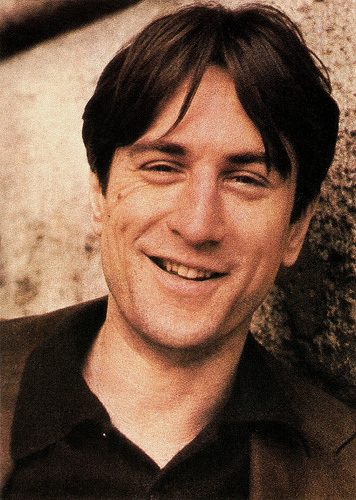
French postcard by Editions F. Nugeron, no. STAR 66. Photo: J. Ritchie / Classico, San Francisco.
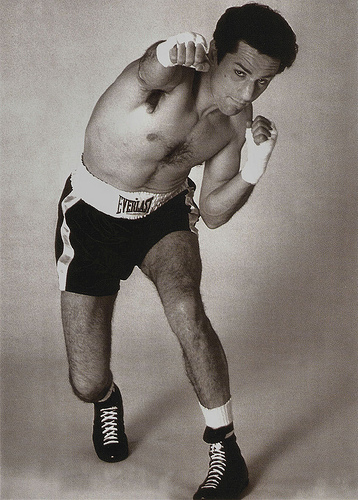
British postcard by Classic. Photo: publicity still for Raging Bull (Martin Scorsese, 1980).
Reunited in a terrifying way
In the 1980s, Robert De Niro first roles were a worldly ambitious Catholic priest in True Confessions (Ulu Grosbard, 1981), an aspiring stand-up comedian in Scorsese's The King of Comedy (Martin Scorsese, 1983) and as a Jewish mobster in the sprawling historical epic Once Upon a Time in America (Sergio Leone, 1984).
Other notable projects included Sci-fi art film Brazil (Terry Gilliam, 1985) and the British drama The Mission (Roland Joffé, 1986), about the experiences of a Jesuit missionary in 18th century South America, which won the Golden Palm at the Cannes Film Festival. It was followed by fare like the crime drama The Untouchables (Brian De Palma, 1987), in which De Niro portrayed gangster Al Capone opposite Kevin Costner as Eliot Ness, the mysterious thriller Angel Heart (Alan Parker, 1987) and the action comedy Midnight Run (Martin Brest, 1988).
De Niro opened the 1990s with Goodfellas (Martin Scorsese, 1990), yet another acclaimed gangster film from Scorsese that saw the actor teaming up with Ray Liotta and Joe Pesci. De Niro next starred in a project that earned him another Oscar nomination, portraying a catatonic patient brought back to awareness in Awakenings (Penny Marshall, 1990), co-starring Robin Williams as a character based on physician Oliver Sacks.
Dramas continued to be the genre of choice for De Niro, as he played a blacklisted director in Guilty by Suspicion (Irwin Winkler, 1991) and a fire chief in Backdraft (Ron Howard, 1991).
Soon afterwards, the actor was once again front and centre and reunited with Scorsese in a terrifying way, bulking up to become a tattooed rapist who stalks a family in Cape Fear (Martin Scorsese, 1991). The film was a remake of the 1962 thriller starring Gregory Peck and Robert Mitchum. Peck and Mitchum made appearances in the remake as well. De Niro received his sixth Academy Award nomination for Cape Fear, with the film becoming the highest grossing collaboration between the actor and Scorsese, earning more than $182 million worldwide.
After somewhat edgy, comedic outings like Night and the City (Irwin Winkler, 1992) and Mad Dog and Glory (John McNaughton, 1993), another drama followed in the form of This Boy's Life (Michael Caton-Jones, 1993), in which De Niro portrayed the abusive stepfather of a young Leonardo DiCaprio.
That same year, De Niro made his directorial debut with A Bronx Tale (Robert De Niro, 1993), a film adaptation of a one-man play written and performed by Chazz Palminteri. In 1994, De Niro was practically unrecognisable as the monster in actor-director Kenneth Branagh's adaptation of the Mary Shelley novel Frankenstein (Kenneth Branagh, 1994).
It was followed by another Scorsese telling of mob life, this time in Las Vegas. De Niro portrayed a character based on real-life figure Frank ‘Lefty’ Rosenthal in Casino (Martin Scorsese, 1995), co-starring Sharon Stone and Joe Pesci. In Heat (Michael Mann, 1995), De Niro re-teamed with fellow Godfather star Al Pacino in a well-received outing about a bank robber contemplating getting out of the business and the police detective aiming to bring him down.
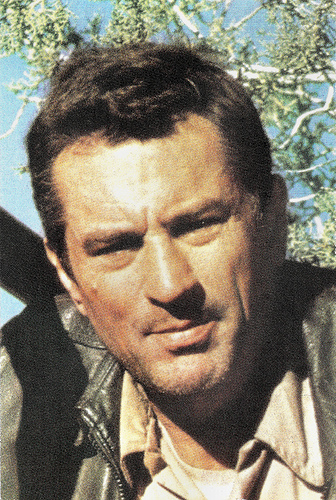
Romanian postcard by Casa Filmului Acin. Photo: publicity still for Midnight Run (Martin Brest, 1988).
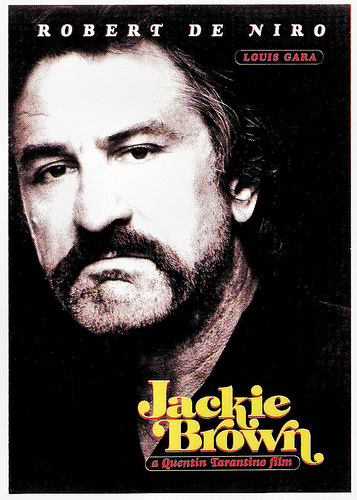
French postcard, no. 654. Photo: publicity still for Jackie Brown. (Quentin Tarantino, 1997) with Robert De Niro as Louis Gara.
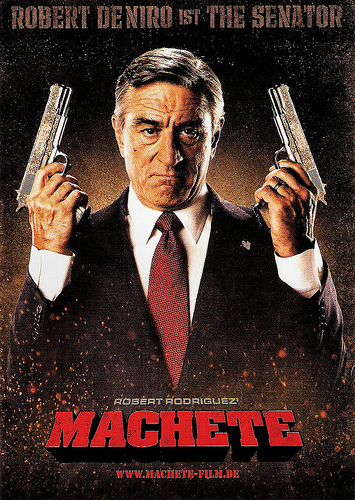
German postcard by CTMG, 2010. Photo: publicity still for Machete (Ethan Maniquis, Robert Rodriguez, 2010) with Robert De Niro as Senator McLaughlin.
Striking out into decidedly different territory
For the rest of the 1990s and into the new millennium, Robert De Niro featured yearly in a big screen project as either a lead or supporting figure. His films include the legal crime drama Sleepers (Barry Levinson, 1996), the black comedy Wag the Dog (Barry Levinson, 1997), the crime drama Cop Land (James Mangold, 1997), the crime thriller Jackie Brown (Quentin Tarantino, 1997), the spy action-thriller Ronin (John Frankenheimer, 1998) and the crime comedy-drama Flawless (Joel Schumacher, 1999).
At the turn of the century, De Niro struck out into decidedly different territory with Analyze This (Harold Ramis, 1999), a hilarious and highly popular spoof of the mob movies that had garnered him fame. Analyze This earned more than a $100 million domestically, with De Niro playing a Mafioso who seeks help from a psychiatrist (Billy Crystal).
De Niro took on another comedy, Meet the Parents (Jay Roach, 2000), as Ben Stiller's future father-in-law. The smash hit spawned two sequels: Meet the Fockers (Jay Roach, 2004) and Little Fockers (Paul Weitz, 2011), both of which were also box-office successes.
De Niro continued to switch between comedic and serious roles over the next few years, reuniting with Billy Crystal for Analyze That (Harold Ramis, 2002), and starring in the spy thriller The Good Shepherd (Robert De Niro, 2006) with Matt Damon and Angelina Jolie.
The following year De Niro was featured as a secretive cross-dressing pirate with a heart of gold in the fantasy flick Stardust (Matthew Vaughn, 2007), while 2009 saw a return to dramatic fare with Everybody's Fine (Kirk Jones, 2009). In Italy, De Niro starred in the romantic comedy Manuale d'amore 3/The Ages of Love (Giovanni Veronesi, 2011).
De Niro earned yet another Academy Award nomination for his turn in David O. Russell's Silver Linings Playbook (2012), playing the father of a mentally troubled son (Bradley Cooper). De Niro teamed up again with Silver Linings Playbook director Russell and stars Cooper and Jennifer Lawrence for the biopic Joy (David O. Russell, 2015), based on the life of Miracle Mop inventor Joy Mangano.
Later that year, De Niro starred as a widower who returns to the workforce in The Intern (Nancy Meyers, 2015), with Anne Hathaway. In 2016, he starred in another biopic, Hands of Stone (Jonathan Jakubowicz, 2016), playing Ray Arcel, the trainer of Panamanian boxer Roberto Durán. That same year De Niro received the Presidential Medal of Freedom from President Obama for his contribution to the arts.
De Niro, who has long resided in New York City, has been investing in Manhattan's Tribeca neighbourhood since 1989. His capital ventures there included co-founding the film studio TriBeCa Productions in 1998 and the Tribeca Film Festival (since 2002). De Niro married actress Diahnne Abbott in 1976. The couple had one son, Raphael, before divorcing 12 years later, in 1988. De Niro then had a long relationship with model Toukie Smith that produced twin sons, Aaron Kendrick and Julian Henry, in 1995. Then in 1997, De Niro married Grace Hightower, with whom he has also two children.
Trailer Novecento/1900 (1976). Source: Eurekaentertainment (YouTube).
Trailer Raging Bull (1980). Source: Movieclips Trailer Vault (YouTube).
Trailer The Mission (1986). Source: Warner Bros. (YouTube).
Trailer for Analyze This (1999). Source: Movieclips Trailer Vault (YouTube).
Sources: Biography.com, Wikipedia, and .

French postcard in the Collection Cinema Couleur by Edition La Malibran, Paris, no. MC 33, 1990. Photo: publicity still for Taxi Driver (Martin Scorsese, 1976).

Belgian promotion card by Tasschen Gallery for the exhibition 'Taxi Driver - unseen photographs from Scorsese's Masterpiece'. Photo: Steve Schapiro. Publicity still for Taxi Driver (Martin Scorsese, 1976).
The most chilling performance of his career
Robert Anthony De Niro was born in the Greenwich Village area of Manhattan, New York City in 1943. His mother, Virginia Admiral, was a cerebral and gifted painter, and his father, Robert De Niro Sr., was a painter, sculptor and poet whose work received high critical acclaim. They split ways in 1945, when young Robert was only 2 years old, after his father announced that he was gay.
De Niro was raised primarily by his mother, who took on work as a typesetter and printer in order to support her son. A bright and energetic child, Robert De Niro was incredibly fond of attending films with his father when they spent time together. De Niro's mother worked part-time as a typist and copy editor for Maria Picator's Dramatic Workshop, and as part of her compensation, De Niro was allowed to take children's acting classes for free. At the age of 10, De Niro made his stage debut as the Cowardly Lion in a school production of The Wizard of Oz.
De Niro proved to be uninterested in school altogether and, as a teenager, joined a rather tame street gang in Little Italy that gave him the nickname Bobby Milk, in reference to his pale complexion. While De Niro was by all accounts only a very modest troublemaker, the gang provided him with experience to skilfully portray Italian mobsters as an actor.
He left school at age 16 to study acting Stella Adler Conservatory. Adler, who had taught Marlon Brando and Rod Steiger, was a strong proponent of the Stanislavski method of acting, involving deep psychological character investigation. He studied briefly with Lee Strasberg at the Actor's Studio in New York City, and then began auditioning.
After a momentary cameo in the French film Trois chambres à Manhattan/Three Rooms in Manhattan (Marcel Carné, 1965), De Niro's real film debut came in Greetings (Brian De Palma, 1968). However, De Niro's first film role already came at the age of 20, when he appeared credited as Robert Denero in De Palma’s The Wedding Party (Brian De Palma, Wilford Leach, 1963), but the film was not released until 1969.
He then appeared in Roger Corman's film Bloody Mama (1970), featuring Shelley Winters . His breakthrough performances came a few years later in two highly acclaimed films: the sports drama Bang the Drum Slowly (John D. Hancock, 1973), in which he played a terminally ill catcher on a baseball team, and the crime film Mean Streets (1973), his first of many collaborations with director Martin Scorsese, in which he played street thug Johnny Boy opposite Harvey Keitel.
De Niro and Martin Scorsese worked successfully together on eight films: Mean Streets (1973), Taxi Driver (1976), New York, New York (1977), Raging Bull (1980), The King of Comedy (1983), Goodfellas (1990), Cape Fear (1991), and Casino (1995).
In 1974, De Niro established himself as one America’s finest actors with his Academy Award-winning portrayal of the young Vito Corleone in The Godfather: Part II (Francis Ford Coppola, 1974), a role for which he learned to speak Sicilian.
Two years later, De Niro delivered perhaps the most chilling performance of his career, playing vengeful cabbie Travis Bickle in Taxi Driver (Martin Scorsese, 1976) alongside Jodie Foster. His iconic performance as Travis Bickle catapulted him to stardom and forever linked his name with Bickle's famous 'You talkin' to me?' monologue, which De Niro largely improvised.
In Italy, De Niro appeared opposite Gérard Dépardieu in the epic historical drama Novecento/1900 (Bernardo Bertolucci, 1976). The film is an exploration of life in Italy in the first half of the 20th century, seen through the eyes of two Italian childhood friends at the opposite sides of society's hierarchy.
He also starred in The Last Tycoon (1976), the last film directed by Elia Kazan. The Hollywood drama is based upon Harold Pinter's screenplay adaptation of F. Scott Fitzgerald's The Last Tycoon, De Niro continued to show his tremendous skill as a dramatic actor in the Vietnam war drama The Deer Hunter (Michael Cimino, 1978). The film follows a group of friends haunted by their Vietnam experiences.
De Niro later portrayed middleweight boxer Jake LaMotta in the commercially unsuccessful but critically adored film Raging Bull (Martin Scorsese, 1980). The previously skinny De Niro had put on 60 pounds of muscle for his riveting turn as LaMotta and was rewarded for his dedication with the 1981 Academy Award for best actor.

French postcard by Editions F. Nugeron, no. STAR 66. Photo: J. Ritchie / Classico, San Francisco.

British postcard by Classic. Photo: publicity still for Raging Bull (Martin Scorsese, 1980).
Reunited in a terrifying way
In the 1980s, Robert De Niro first roles were a worldly ambitious Catholic priest in True Confessions (Ulu Grosbard, 1981), an aspiring stand-up comedian in Scorsese's The King of Comedy (Martin Scorsese, 1983) and as a Jewish mobster in the sprawling historical epic Once Upon a Time in America (Sergio Leone, 1984).
Other notable projects included Sci-fi art film Brazil (Terry Gilliam, 1985) and the British drama The Mission (Roland Joffé, 1986), about the experiences of a Jesuit missionary in 18th century South America, which won the Golden Palm at the Cannes Film Festival. It was followed by fare like the crime drama The Untouchables (Brian De Palma, 1987), in which De Niro portrayed gangster Al Capone opposite Kevin Costner as Eliot Ness, the mysterious thriller Angel Heart (Alan Parker, 1987) and the action comedy Midnight Run (Martin Brest, 1988).
De Niro opened the 1990s with Goodfellas (Martin Scorsese, 1990), yet another acclaimed gangster film from Scorsese that saw the actor teaming up with Ray Liotta and Joe Pesci. De Niro next starred in a project that earned him another Oscar nomination, portraying a catatonic patient brought back to awareness in Awakenings (Penny Marshall, 1990), co-starring Robin Williams as a character based on physician Oliver Sacks.
Dramas continued to be the genre of choice for De Niro, as he played a blacklisted director in Guilty by Suspicion (Irwin Winkler, 1991) and a fire chief in Backdraft (Ron Howard, 1991).
Soon afterwards, the actor was once again front and centre and reunited with Scorsese in a terrifying way, bulking up to become a tattooed rapist who stalks a family in Cape Fear (Martin Scorsese, 1991). The film was a remake of the 1962 thriller starring Gregory Peck and Robert Mitchum. Peck and Mitchum made appearances in the remake as well. De Niro received his sixth Academy Award nomination for Cape Fear, with the film becoming the highest grossing collaboration between the actor and Scorsese, earning more than $182 million worldwide.
After somewhat edgy, comedic outings like Night and the City (Irwin Winkler, 1992) and Mad Dog and Glory (John McNaughton, 1993), another drama followed in the form of This Boy's Life (Michael Caton-Jones, 1993), in which De Niro portrayed the abusive stepfather of a young Leonardo DiCaprio.
That same year, De Niro made his directorial debut with A Bronx Tale (Robert De Niro, 1993), a film adaptation of a one-man play written and performed by Chazz Palminteri. In 1994, De Niro was practically unrecognisable as the monster in actor-director Kenneth Branagh's adaptation of the Mary Shelley novel Frankenstein (Kenneth Branagh, 1994).
It was followed by another Scorsese telling of mob life, this time in Las Vegas. De Niro portrayed a character based on real-life figure Frank ‘Lefty’ Rosenthal in Casino (Martin Scorsese, 1995), co-starring Sharon Stone and Joe Pesci. In Heat (Michael Mann, 1995), De Niro re-teamed with fellow Godfather star Al Pacino in a well-received outing about a bank robber contemplating getting out of the business and the police detective aiming to bring him down.

Romanian postcard by Casa Filmului Acin. Photo: publicity still for Midnight Run (Martin Brest, 1988).

French postcard, no. 654. Photo: publicity still for Jackie Brown. (Quentin Tarantino, 1997) with Robert De Niro as Louis Gara.

German postcard by CTMG, 2010. Photo: publicity still for Machete (Ethan Maniquis, Robert Rodriguez, 2010) with Robert De Niro as Senator McLaughlin.
Striking out into decidedly different territory
For the rest of the 1990s and into the new millennium, Robert De Niro featured yearly in a big screen project as either a lead or supporting figure. His films include the legal crime drama Sleepers (Barry Levinson, 1996), the black comedy Wag the Dog (Barry Levinson, 1997), the crime drama Cop Land (James Mangold, 1997), the crime thriller Jackie Brown (Quentin Tarantino, 1997), the spy action-thriller Ronin (John Frankenheimer, 1998) and the crime comedy-drama Flawless (Joel Schumacher, 1999).
At the turn of the century, De Niro struck out into decidedly different territory with Analyze This (Harold Ramis, 1999), a hilarious and highly popular spoof of the mob movies that had garnered him fame. Analyze This earned more than a $100 million domestically, with De Niro playing a Mafioso who seeks help from a psychiatrist (Billy Crystal).
De Niro took on another comedy, Meet the Parents (Jay Roach, 2000), as Ben Stiller's future father-in-law. The smash hit spawned two sequels: Meet the Fockers (Jay Roach, 2004) and Little Fockers (Paul Weitz, 2011), both of which were also box-office successes.
De Niro continued to switch between comedic and serious roles over the next few years, reuniting with Billy Crystal for Analyze That (Harold Ramis, 2002), and starring in the spy thriller The Good Shepherd (Robert De Niro, 2006) with Matt Damon and Angelina Jolie.
The following year De Niro was featured as a secretive cross-dressing pirate with a heart of gold in the fantasy flick Stardust (Matthew Vaughn, 2007), while 2009 saw a return to dramatic fare with Everybody's Fine (Kirk Jones, 2009). In Italy, De Niro starred in the romantic comedy Manuale d'amore 3/The Ages of Love (Giovanni Veronesi, 2011).
De Niro earned yet another Academy Award nomination for his turn in David O. Russell's Silver Linings Playbook (2012), playing the father of a mentally troubled son (Bradley Cooper). De Niro teamed up again with Silver Linings Playbook director Russell and stars Cooper and Jennifer Lawrence for the biopic Joy (David O. Russell, 2015), based on the life of Miracle Mop inventor Joy Mangano.
Later that year, De Niro starred as a widower who returns to the workforce in The Intern (Nancy Meyers, 2015), with Anne Hathaway. In 2016, he starred in another biopic, Hands of Stone (Jonathan Jakubowicz, 2016), playing Ray Arcel, the trainer of Panamanian boxer Roberto Durán. That same year De Niro received the Presidential Medal of Freedom from President Obama for his contribution to the arts.
De Niro, who has long resided in New York City, has been investing in Manhattan's Tribeca neighbourhood since 1989. His capital ventures there included co-founding the film studio TriBeCa Productions in 1998 and the Tribeca Film Festival (since 2002). De Niro married actress Diahnne Abbott in 1976. The couple had one son, Raphael, before divorcing 12 years later, in 1988. De Niro then had a long relationship with model Toukie Smith that produced twin sons, Aaron Kendrick and Julian Henry, in 1995. Then in 1997, De Niro married Grace Hightower, with whom he has also two children.
Trailer Novecento/1900 (1976). Source: Eurekaentertainment (YouTube).
Trailer Raging Bull (1980). Source: Movieclips Trailer Vault (YouTube).
Trailer The Mission (1986). Source: Warner Bros. (YouTube).
Trailer for Analyze This (1999). Source: Movieclips Trailer Vault (YouTube).
Sources: Biography.com, Wikipedia, and .
Published on January 21, 2017 22:00
January 20, 2017
Elsa Martinelli
Glamorous Elsa Martinelli (1935) is an Italian actress and former fashion model. She showed her beautiful curves in many European and Hollywood productions of the 1950s and 1960s, but somehow she never became the star she was destined to become in the mid-1950s.
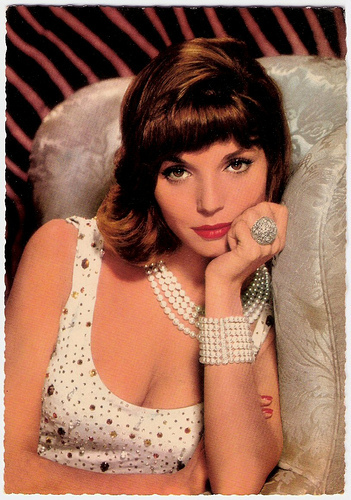
German postcard by Krüger, no. 902/255.
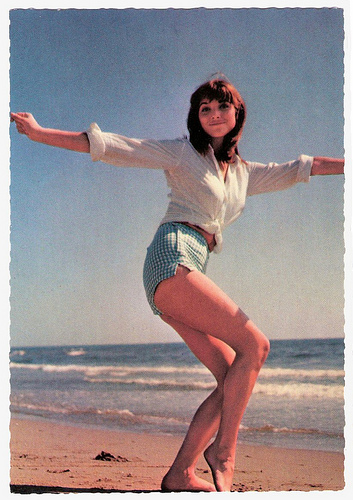
German postcard by ISV, no. D 22. Photo: Pierluigi.
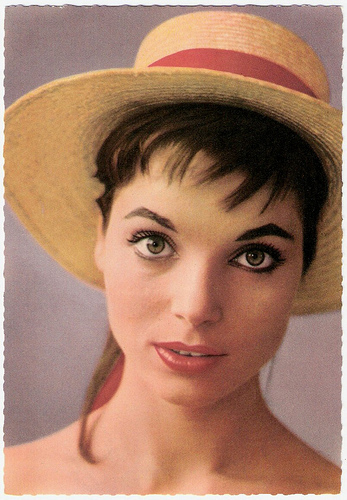
German postcard by ISV, no. D 27. Photo: Pierluigi.
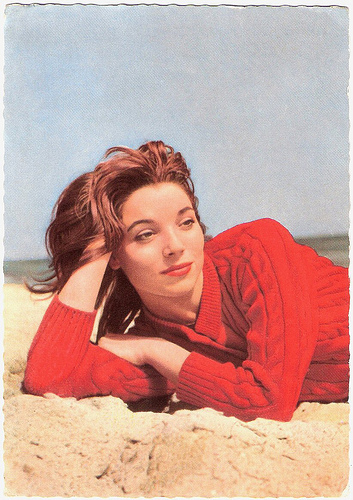
German postcard by Universum-Film Aktiengesellschaft (Ufa), Berlin-Tempelhof, no. CK 39. Retail price: 30 Pfg. Photo: Ufa.
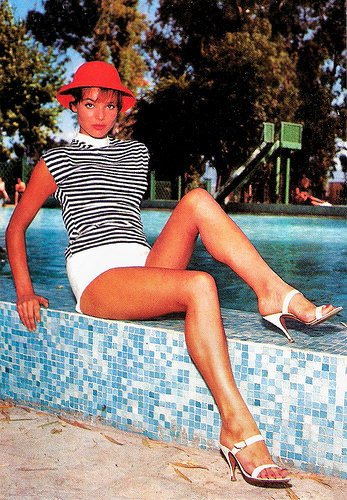
Spanish postcard by Postal Oscarcolor, no. 407.
The World of Fashion
Elsa Martinelli was born Elsa Tia in Grosseto, Tuscany, in 1932 (according to AllMovie ) or 1935 (according to IMDb ). With her large and very poor family she moved to Rome.
In 1953, while working as a barmaid, she was discovered by designer Roberto Capucci who introduced her to the fashion world. She became a model and began playing small roles in films.
She appeared uncredited in Le Rouge et le noir/Scarlet and Black (Claude Autant-Lara, 1954) starring Gérard Philipe.
Her first important film role came the following year with the American Western The Indian Fighter (André De Toth, 1955), in which she played the Native American heroine opposite Kirk Douglas. Douglas claims to have spotted her on a magazine cover and hired her for his production company, Bryna Productions.

Italian postcard by Rotalfoto, Milano / G.B. & F., V, no. 2072. Photo: Carlo Ponti. Publicity still for La risaia/Rice Girl (Raffaello Matarazzo, 1956). Caption: Saluti dalla Risaia (Greetings from the rice girl).
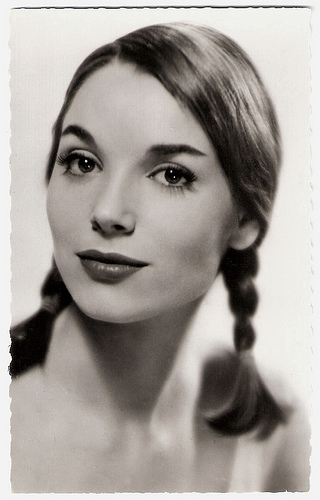
French postcard by Editions P.I., Paris, offered by Les Carbones Korès 'Carboplane', no. 917. Photo: Paramount, 1957.
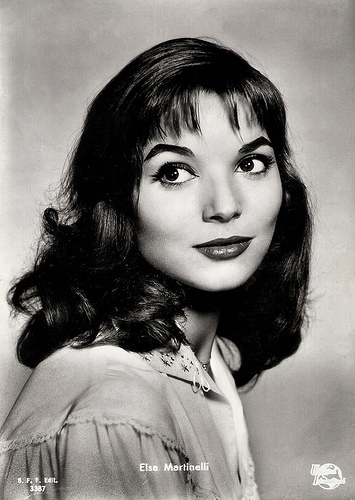
Italian postcard by Casa Editr. Ballerini & Fratini, Firenze (B.F.F. Edit.), no. 3387. Photo: Universal.
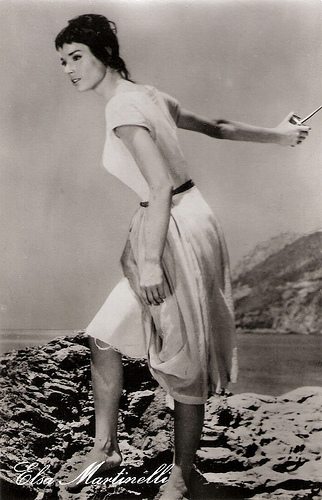
East-German postcard by VEB Progress Film-Vertrieb, no. 1064, 1959. Retail price: 0,20 DM. Photo: Maxima-Lux Rome; Aspa, Madrid. Publicity still for La mina/The Mine (Giuseppe Bennati, 1957).
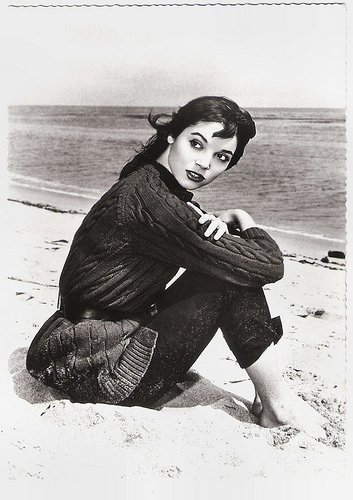
Italian postcard by 3K, no. 3841.
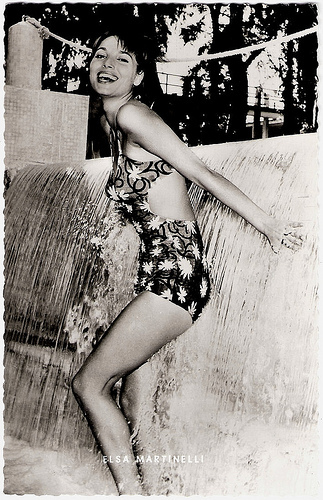
German postcard by Kunst und Bild, Berlin-Charlottenburg, no. S 737. Photo: Unitalia-Film / Dial.
Modern Cinderella
In 1956 Elsa Martinelli won the Silver Berlin Bear Award for Best Actress at the Berlin International Film Festival. She won this prestigious award for playing a modern Cinderella in the comedy Donatella (Mario Monicelli, 1956) with Gabriele Ferzetti .
From then on, she divided her time between Europe and the US and appeared in such films as Four Girls in Town (Jack Sher, 1956) with George Nader , Manuela/The Stowaway Girl (Guy Hamilton, 1957) with Trevor Howard , the historical drama I Battellieri del Volga/Prisoner of the Volga (Victor Tourjansky, 1959) with John Derek and the romance Un amore a Roma/Love in Rome (Dino Risi, 1960).
Highlights were the excellent drama La notte brava (Mauro Bolognini, 1959), based on a novel by Pier Paolo Pasolini and the haunting and surreal horror film Et mourir de plaisir/Blood and Roses (Roger Vadim, 1960).
The latter was an attempt to retell the classic Sheridan Le Fanu vampire tale Carmilla, co-starring the director's wife Annette Vadim (or Annette Stroyberg).
In 1957 Elsa married wealthy Count Franco Mancinelli Scotti di San Vito. Her mother-in-law, Countess Margherita Manicineli Scotti di San Vito, reportedly expelled her son from their Rome palace because the marriage was against her wishes. Finally she fired her son from his job as manager of the family estate.
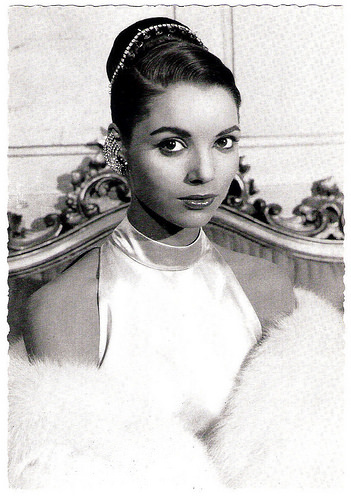
German postcard by Filmbilder-Vertrieb Ernst Freihoff, Essen, no. 233. Photo: Georg Michalke.
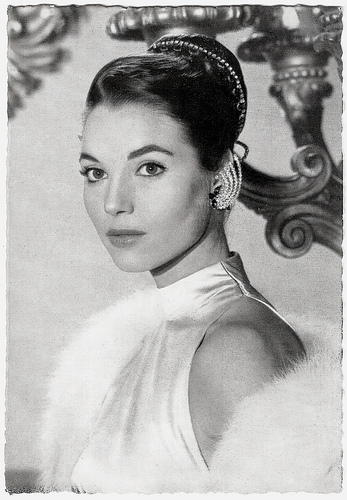
German postcard by WS-Druck, Wanne-Eickel, no. 284. Photo: Georg Michalke / Archiv Filmpress Zürich.
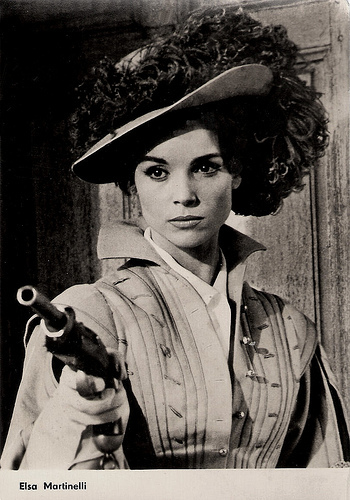
East-German postcard by VEB Progress Film-Vertrieb, Berlin, no. 1.974, 1963. Photo: publicity still for Le capitan/Captain Blood (André Hunebelle, 1960).
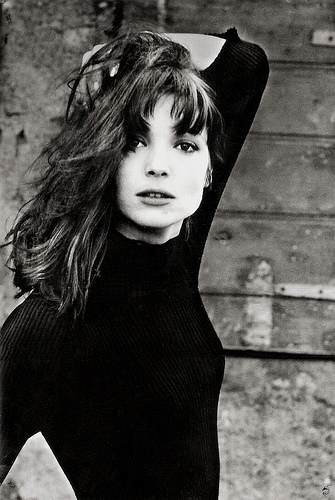
Romanian postcard by Casa Filmului Acin, no. 103. Photo: publicity still for Hatari! (Howard Hawks, 1962).

Romanian postcard by Casa Filmului Acin, no. 470. Sent by mail in 1972. Photo: publicity still for Le procès/The Trial (Orson Welles, 1962) with Anthony Perkins .
Tried and True Howard Hawks Fashion
One of Elsa Martinelli’s most interesting films is Orson Welles ’ adaptation of Franz Kafka's The Trial, Le Procès (Orson Welles, 1962). Anthony Perkins played Joseph K, a man condemned for an unnamed crime in an unnamed country. Seeking justice, he is sucked into a labyrinth of bureaucracy. Along the way, he becomes involved with three women - Jeanne Moreau , Romy Schneider and Martinelli - who in their own individual ways are functions of the System that persecutes him.
In the action and adventure comedy Hatari! (Howard Hawks, 1962) Martinelli was the eye candy in a star cast with John Wayne, Gérard Blain, Red Buttons and Hardy Krüger . Wayne's men-only contingent is reduced to jello when Elsa enters the scene, but in tried and true Howard Hawks fashion, she quickly becomes ‘one of the guys’.
In the comedy The Pigeon That Took Rome (Melville Shavelson, 1962) she starred opposite Charlton Heston, and in The V.I.P.’s (Anthony Asquith, 1963) she was the protegee of Orson Welles .
In the South Seas adventure Rampage (Phil Karlson, 1963) she co-starred with Robert Mitchum, and in the episodic sex comedy Sette Volte Donna/Woman Times Seven (Vittorio De Sica, 1967) with Lex Barker .
In the big-budget adaptation of Terry Southern's satiric sex farce Candy (Christian Marquand, 1968), she played Candy’s mother in a cast with Charles Aznavour , Marlon Brando , and Richard Burton .
In Italy she made the near surrealist western Il mio corpo per un poker/Belle Starr (Piero Cristofani, Lina Wertmuller, 1968), and a stylish erotic thriller, Una sull'altra/One on Top of the Other (Lucio Fulci, 1969), with Marisa Mell and Jean Sorel .
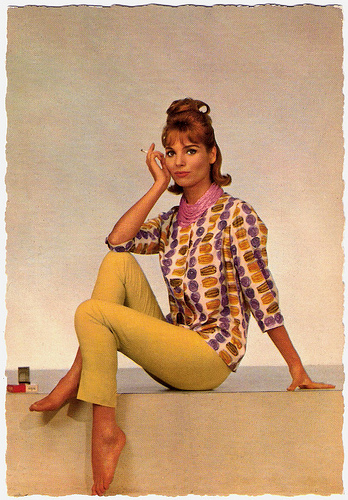
French postcard by E.D.U.G., no. 199. Photo: Sam Lévin.
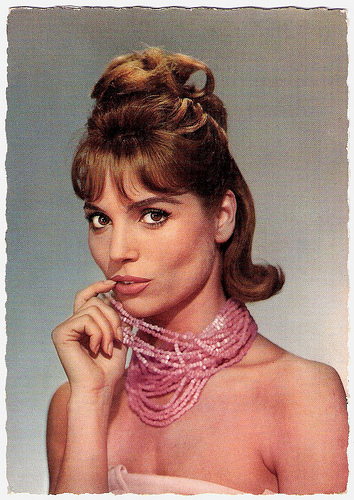
French postcard by E.D.U.G., no. 124. Photo: Sam Lévin.
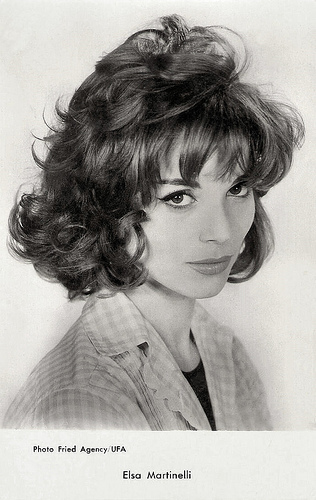
French postcard by Editions P.I., Paris, offered by Les Carbones Korès 'Carboplane', no. FK 32. Photo: Fried Agency / Ufa.
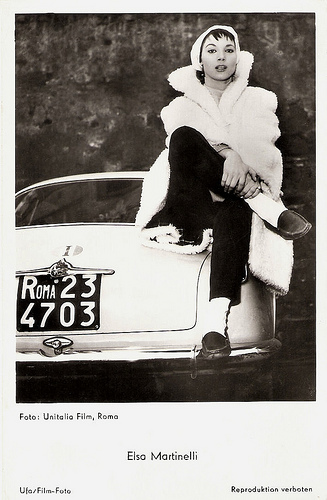
German postcard by Ufa/Film-Foto, no. FK 3172. Photo: Unitalia Film, Roma.
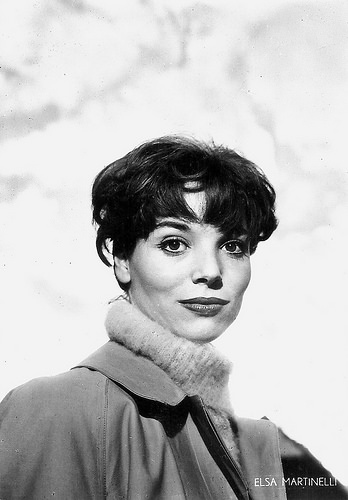
Italian photocard, editor and photographer unknown.
Interior Designer
In the 1970s the film career of Elsa Martinelli somehow halted. She only appeared incidentally in European films. She starred opposite Robert Hossein in the French caper film La Part des Lions/The Lions' Share (Jean Larriaga, 1971), and she played a supporting part in the political drama Garofano Rosso/The Red Carnation (Luigi Faccini, 1976) with Marina Berti .
On TV she appeared as a guest star in The Return of the Saint (1979) with Ian Ogilvy as Simon Templar. Meanwhile she had started a new, successful career as an interior designer, but she continued to accept incidental parts in films and TV-series.
After Sono Un Fenomeno Paranormale/I'm a Paranormal Phenomenon (Sergio Corbucci, 1985) with Alberto Sordi , she made unheralded return appearances in the international productions Arrivederci Roma (Clive Donner, 1990) and the inconsequential all-star comedy Once Upon a Crime (Eugene Levy, 1992).
Most recently she was seen in the short film Cabiria, Priscilla e le altre/Cabiria, Priscilla and the Others (Fabrizio Celestini, 1999) and the TV-series Orgoglio (2005).
Elsa Martinelli was married from 1957 till 1964 to Count Franco Mancinelli Scotti di San Vito, by whom she has a daughter, actress Cristiana Mancinelli (1958). In 1968 she married Paris Match photographer and 1970s furniture designer Willy Rizzo, with whom she has a son.
Trailer The Indian Fighter (1955). Source: Project1950s Tony (YouTube).
Italian trailer Donatella (1956). Source: CG Entertainment (YouTube). No subtitles, sorry.
German DVD trailer for La risaia/Rice Girl 1956).Source: Arild Rafalzik (YouTube). No subtitles, sorry.
Trailer Hatari! (1962). Source: Paramountmovies Digital (YouTube).
Trailer Le Procès/The Trial (1962). Source: Danios 12345 (YouTube).
Elsa Martinelli and Robert Hoffman in Come Imparai ad Amare le Donne (1967). Source: stranevisioni (YouTube). No subtitles, sorry.
Sources: Hal Erickson (AllMovie), Kimberly Lindbergs (Cinebeats), Glamour Girls of the Silver Screen, Wikipedia, and .

German postcard by Krüger, no. 902/255.

German postcard by ISV, no. D 22. Photo: Pierluigi.

German postcard by ISV, no. D 27. Photo: Pierluigi.

German postcard by Universum-Film Aktiengesellschaft (Ufa), Berlin-Tempelhof, no. CK 39. Retail price: 30 Pfg. Photo: Ufa.

Spanish postcard by Postal Oscarcolor, no. 407.
The World of Fashion
Elsa Martinelli was born Elsa Tia in Grosseto, Tuscany, in 1932 (according to AllMovie ) or 1935 (according to IMDb ). With her large and very poor family she moved to Rome.
In 1953, while working as a barmaid, she was discovered by designer Roberto Capucci who introduced her to the fashion world. She became a model and began playing small roles in films.
She appeared uncredited in Le Rouge et le noir/Scarlet and Black (Claude Autant-Lara, 1954) starring Gérard Philipe.
Her first important film role came the following year with the American Western The Indian Fighter (André De Toth, 1955), in which she played the Native American heroine opposite Kirk Douglas. Douglas claims to have spotted her on a magazine cover and hired her for his production company, Bryna Productions.

Italian postcard by Rotalfoto, Milano / G.B. & F., V, no. 2072. Photo: Carlo Ponti. Publicity still for La risaia/Rice Girl (Raffaello Matarazzo, 1956). Caption: Saluti dalla Risaia (Greetings from the rice girl).

French postcard by Editions P.I., Paris, offered by Les Carbones Korès 'Carboplane', no. 917. Photo: Paramount, 1957.

Italian postcard by Casa Editr. Ballerini & Fratini, Firenze (B.F.F. Edit.), no. 3387. Photo: Universal.

East-German postcard by VEB Progress Film-Vertrieb, no. 1064, 1959. Retail price: 0,20 DM. Photo: Maxima-Lux Rome; Aspa, Madrid. Publicity still for La mina/The Mine (Giuseppe Bennati, 1957).

Italian postcard by 3K, no. 3841.

German postcard by Kunst und Bild, Berlin-Charlottenburg, no. S 737. Photo: Unitalia-Film / Dial.
Modern Cinderella
In 1956 Elsa Martinelli won the Silver Berlin Bear Award for Best Actress at the Berlin International Film Festival. She won this prestigious award for playing a modern Cinderella in the comedy Donatella (Mario Monicelli, 1956) with Gabriele Ferzetti .
From then on, she divided her time between Europe and the US and appeared in such films as Four Girls in Town (Jack Sher, 1956) with George Nader , Manuela/The Stowaway Girl (Guy Hamilton, 1957) with Trevor Howard , the historical drama I Battellieri del Volga/Prisoner of the Volga (Victor Tourjansky, 1959) with John Derek and the romance Un amore a Roma/Love in Rome (Dino Risi, 1960).
Highlights were the excellent drama La notte brava (Mauro Bolognini, 1959), based on a novel by Pier Paolo Pasolini and the haunting and surreal horror film Et mourir de plaisir/Blood and Roses (Roger Vadim, 1960).
The latter was an attempt to retell the classic Sheridan Le Fanu vampire tale Carmilla, co-starring the director's wife Annette Vadim (or Annette Stroyberg).
In 1957 Elsa married wealthy Count Franco Mancinelli Scotti di San Vito. Her mother-in-law, Countess Margherita Manicineli Scotti di San Vito, reportedly expelled her son from their Rome palace because the marriage was against her wishes. Finally she fired her son from his job as manager of the family estate.

German postcard by Filmbilder-Vertrieb Ernst Freihoff, Essen, no. 233. Photo: Georg Michalke.

German postcard by WS-Druck, Wanne-Eickel, no. 284. Photo: Georg Michalke / Archiv Filmpress Zürich.

East-German postcard by VEB Progress Film-Vertrieb, Berlin, no. 1.974, 1963. Photo: publicity still for Le capitan/Captain Blood (André Hunebelle, 1960).

Romanian postcard by Casa Filmului Acin, no. 103. Photo: publicity still for Hatari! (Howard Hawks, 1962).

Romanian postcard by Casa Filmului Acin, no. 470. Sent by mail in 1972. Photo: publicity still for Le procès/The Trial (Orson Welles, 1962) with Anthony Perkins .
Tried and True Howard Hawks Fashion
One of Elsa Martinelli’s most interesting films is Orson Welles ’ adaptation of Franz Kafka's The Trial, Le Procès (Orson Welles, 1962). Anthony Perkins played Joseph K, a man condemned for an unnamed crime in an unnamed country. Seeking justice, he is sucked into a labyrinth of bureaucracy. Along the way, he becomes involved with three women - Jeanne Moreau , Romy Schneider and Martinelli - who in their own individual ways are functions of the System that persecutes him.
In the action and adventure comedy Hatari! (Howard Hawks, 1962) Martinelli was the eye candy in a star cast with John Wayne, Gérard Blain, Red Buttons and Hardy Krüger . Wayne's men-only contingent is reduced to jello when Elsa enters the scene, but in tried and true Howard Hawks fashion, she quickly becomes ‘one of the guys’.
In the comedy The Pigeon That Took Rome (Melville Shavelson, 1962) she starred opposite Charlton Heston, and in The V.I.P.’s (Anthony Asquith, 1963) she was the protegee of Orson Welles .
In the South Seas adventure Rampage (Phil Karlson, 1963) she co-starred with Robert Mitchum, and in the episodic sex comedy Sette Volte Donna/Woman Times Seven (Vittorio De Sica, 1967) with Lex Barker .
In the big-budget adaptation of Terry Southern's satiric sex farce Candy (Christian Marquand, 1968), she played Candy’s mother in a cast with Charles Aznavour , Marlon Brando , and Richard Burton .
In Italy she made the near surrealist western Il mio corpo per un poker/Belle Starr (Piero Cristofani, Lina Wertmuller, 1968), and a stylish erotic thriller, Una sull'altra/One on Top of the Other (Lucio Fulci, 1969), with Marisa Mell and Jean Sorel .

French postcard by E.D.U.G., no. 199. Photo: Sam Lévin.

French postcard by E.D.U.G., no. 124. Photo: Sam Lévin.

French postcard by Editions P.I., Paris, offered by Les Carbones Korès 'Carboplane', no. FK 32. Photo: Fried Agency / Ufa.

German postcard by Ufa/Film-Foto, no. FK 3172. Photo: Unitalia Film, Roma.

Italian photocard, editor and photographer unknown.
Interior Designer
In the 1970s the film career of Elsa Martinelli somehow halted. She only appeared incidentally in European films. She starred opposite Robert Hossein in the French caper film La Part des Lions/The Lions' Share (Jean Larriaga, 1971), and she played a supporting part in the political drama Garofano Rosso/The Red Carnation (Luigi Faccini, 1976) with Marina Berti .
On TV she appeared as a guest star in The Return of the Saint (1979) with Ian Ogilvy as Simon Templar. Meanwhile she had started a new, successful career as an interior designer, but she continued to accept incidental parts in films and TV-series.
After Sono Un Fenomeno Paranormale/I'm a Paranormal Phenomenon (Sergio Corbucci, 1985) with Alberto Sordi , she made unheralded return appearances in the international productions Arrivederci Roma (Clive Donner, 1990) and the inconsequential all-star comedy Once Upon a Crime (Eugene Levy, 1992).
Most recently she was seen in the short film Cabiria, Priscilla e le altre/Cabiria, Priscilla and the Others (Fabrizio Celestini, 1999) and the TV-series Orgoglio (2005).
Elsa Martinelli was married from 1957 till 1964 to Count Franco Mancinelli Scotti di San Vito, by whom she has a daughter, actress Cristiana Mancinelli (1958). In 1968 she married Paris Match photographer and 1970s furniture designer Willy Rizzo, with whom she has a son.
Trailer The Indian Fighter (1955). Source: Project1950s Tony (YouTube).
Italian trailer Donatella (1956). Source: CG Entertainment (YouTube). No subtitles, sorry.
German DVD trailer for La risaia/Rice Girl 1956).Source: Arild Rafalzik (YouTube). No subtitles, sorry.
Trailer Hatari! (1962). Source: Paramountmovies Digital (YouTube).
Trailer Le Procès/The Trial (1962). Source: Danios 12345 (YouTube).
Elsa Martinelli and Robert Hoffman in Come Imparai ad Amare le Donne (1967). Source: stranevisioni (YouTube). No subtitles, sorry.
Sources: Hal Erickson (AllMovie), Kimberly Lindbergs (Cinebeats), Glamour Girls of the Silver Screen, Wikipedia, and .
Published on January 20, 2017 22:00
January 19, 2017
Sascha Gura
Around 1920, Sascha Gura (1896-?) was highly popular and active in the silent cinema of the Weimar Republic. She is particularly memorable in a few expressionist horror films by Otto Rippert and F.W. Murnau. After the rise of the Nazis, the Jewish actress disappeared in oblivion.
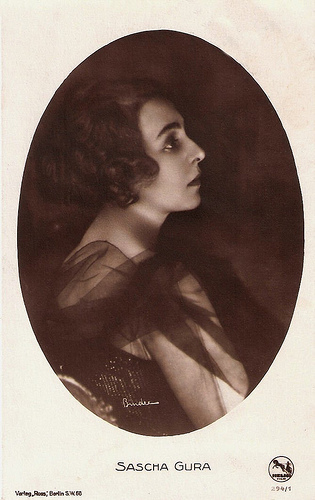
German postcard by Ross Verlag, Berlin, no. 294/1. Photo: Alex Binder / Decla.
Seducing By Dance
Sascha Gura was born in Munich, Germany in 1896 as Eugenia Theresia Gura. She was the daughter of the singer and actor Hermann Gura and granddaughter of singer and actor Eugen Gura.
Sascha had her professional training at the Königliche Hochschule für Musik (Now Universität der Künste Berlin). Her career started as operetta singer during the First World War and from 1921 on she became successful at the Komische Oper in Berlin.
Gura became a film actress in 1919, debuting in the expressionist silent film Der Totentanz/Dance of Death (Otto Rippert, 1919), a Helios Film production, scripted by Fritz Lang. Gura played the lead of a dancer who kills men after seducing them by her dance. She is forced to do so by a disfigured doctor ( Werner Krauss ) who thus takes revenge on the world, until she meets a man (Karl Bernhard) she falls in love with.
It was followed by such films as Phantome des Lebens/Phantom of Life (Josef Coenen, 1919) with Lil Dagover , and Das Haupt des Juarez/The Head of Juarez (Johannes Guter, Rudolf Meinert, 1920) starring Eduard von Winterstein. For six years she would perform in more of such dark dramas and adventure stories.
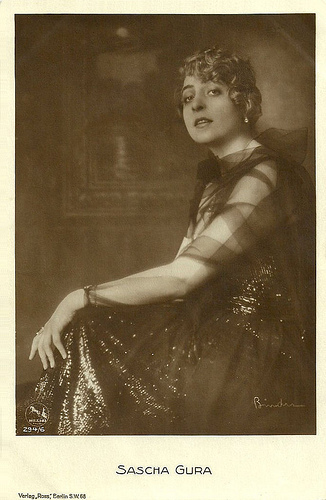
German postcard by Ross Verlag, Berlin, no. 294/6. Photo: Alex Binder / Helios Film.
Poison Ivy
In 1920 Sascha Gura went to Vienna to perform in two films by Heinz Hanus at Astoria-Film, the adaptation Wie Satan starb/How Satan Died (Heinz Hanus, 1920) with Nora Gregor , and Unter der Knute des Schicksals/Under the Knout of Destiny (Heinz Hanus, 1921).
Memorable was Gura’s part in F.W. Murnau’s horror film Die Bücklige und die Tanzerin/The Hunchback and the Dancer (Friedrich Wilhelm Murnau, 1920), in which she played the female lead Gina, opposite John Gottowt.
Carl Mayer’s script is similar to Der Totentanz: a disfigured man takes vengeance on the world. The story also reminds Batman’s Poison Ivy. A hunchback, who has become a millionaire by finding diamonds in Java, but also learned there about mortal venoms. When Berlin dancer Gina first falls for him and then goes back to the baron she already loved before, he makes her skin mortal to anyone who kisses her. Sadly, the film is considered lost.
Then followed Die Liebschaften des Hektor Dalmore/The love affairs of Hektor Dalmore (Richard Oswald, 1921) featuring Conrad Veidt . In the next years followed more than a dozen film parts in silent films such as the female lead in Die Handschrift des Inka/The manuscript of the Inca (1925) by Gernot Bock-Stieber, with whom she had done various films before as well.
In 1927 Gura quitted acting in silent cinema, after making the action film Bezwinger der 1000 Gefahren/Conqueror of 1000 dangers (1927) directed by its star, Harry Piel . She played two small parts in sound films, in Trenck - Der Roman einer großen Liebe/Trenck (Ernst Neubach, Heinz Paul, 1932) starring Hans Stüwe , and Grüss mir die Lore noch einmal/Greet Lore for Me one more time (Carl Heinz Wolff, 1934).
Then the Jewish actress got into trouble with the Nazi regime and her career ended. We couldn't find more information on the web about her further whereabouts.
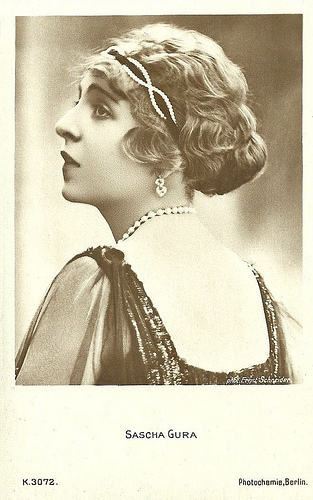
German postcard by Photochemie, Berlin, no. K 3072. Photo: Ernst Schneider.
Sources: Stephanie d'Heil (Steffi-line.de - German), Filmportal.de, Wikipedia (German) and .

German postcard by Ross Verlag, Berlin, no. 294/1. Photo: Alex Binder / Decla.
Seducing By Dance
Sascha Gura was born in Munich, Germany in 1896 as Eugenia Theresia Gura. She was the daughter of the singer and actor Hermann Gura and granddaughter of singer and actor Eugen Gura.
Sascha had her professional training at the Königliche Hochschule für Musik (Now Universität der Künste Berlin). Her career started as operetta singer during the First World War and from 1921 on she became successful at the Komische Oper in Berlin.
Gura became a film actress in 1919, debuting in the expressionist silent film Der Totentanz/Dance of Death (Otto Rippert, 1919), a Helios Film production, scripted by Fritz Lang. Gura played the lead of a dancer who kills men after seducing them by her dance. She is forced to do so by a disfigured doctor ( Werner Krauss ) who thus takes revenge on the world, until she meets a man (Karl Bernhard) she falls in love with.
It was followed by such films as Phantome des Lebens/Phantom of Life (Josef Coenen, 1919) with Lil Dagover , and Das Haupt des Juarez/The Head of Juarez (Johannes Guter, Rudolf Meinert, 1920) starring Eduard von Winterstein. For six years she would perform in more of such dark dramas and adventure stories.

German postcard by Ross Verlag, Berlin, no. 294/6. Photo: Alex Binder / Helios Film.
Poison Ivy
In 1920 Sascha Gura went to Vienna to perform in two films by Heinz Hanus at Astoria-Film, the adaptation Wie Satan starb/How Satan Died (Heinz Hanus, 1920) with Nora Gregor , and Unter der Knute des Schicksals/Under the Knout of Destiny (Heinz Hanus, 1921).
Memorable was Gura’s part in F.W. Murnau’s horror film Die Bücklige und die Tanzerin/The Hunchback and the Dancer (Friedrich Wilhelm Murnau, 1920), in which she played the female lead Gina, opposite John Gottowt.
Carl Mayer’s script is similar to Der Totentanz: a disfigured man takes vengeance on the world. The story also reminds Batman’s Poison Ivy. A hunchback, who has become a millionaire by finding diamonds in Java, but also learned there about mortal venoms. When Berlin dancer Gina first falls for him and then goes back to the baron she already loved before, he makes her skin mortal to anyone who kisses her. Sadly, the film is considered lost.
Then followed Die Liebschaften des Hektor Dalmore/The love affairs of Hektor Dalmore (Richard Oswald, 1921) featuring Conrad Veidt . In the next years followed more than a dozen film parts in silent films such as the female lead in Die Handschrift des Inka/The manuscript of the Inca (1925) by Gernot Bock-Stieber, with whom she had done various films before as well.
In 1927 Gura quitted acting in silent cinema, after making the action film Bezwinger der 1000 Gefahren/Conqueror of 1000 dangers (1927) directed by its star, Harry Piel . She played two small parts in sound films, in Trenck - Der Roman einer großen Liebe/Trenck (Ernst Neubach, Heinz Paul, 1932) starring Hans Stüwe , and Grüss mir die Lore noch einmal/Greet Lore for Me one more time (Carl Heinz Wolff, 1934).
Then the Jewish actress got into trouble with the Nazi regime and her career ended. We couldn't find more information on the web about her further whereabouts.

German postcard by Photochemie, Berlin, no. K 3072. Photo: Ernst Schneider.
Sources: Stephanie d'Heil (Steffi-line.de - German), Filmportal.de, Wikipedia (German) and .
Published on January 19, 2017 22:00
January 18, 2017
Albert Rueprecht
Austrian actor Albert Rueprecht (1929) was a member of the Burgtheater and Theater in der Josefstadt in Vienna. The blond actor made over 40 feature films, including many Heimatfilms in which he often played the handsome jeune premier.
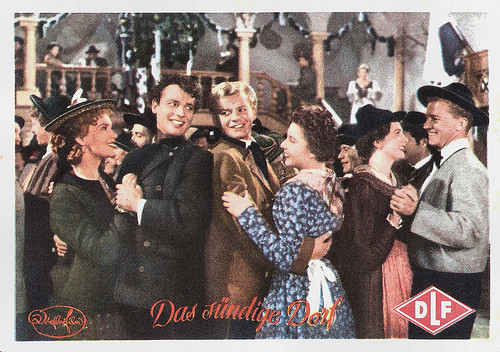
West-German postcard by DLF. Photo: Dörfler-Filmproduktion. Publicity still for Das sündige Dorf/The Village of Sin (Ferdinand Dörfler, 1954) with Renate Mannheim, Thomas Reyer, Albert Rueprecht and Hanna Hutten.
Romeo
Albert Rueprecht was born in 1929 in Vienna, the capital of Austria. He had his first stage experiences at the Akademischen Gymnasium when he played in Ferdinand Raimund’s Alpenkönig und Menschenfeind (King of the Alps and Enemy of the People).
From 1949 to 1951, he took acting classes with Zdenko Kestranek, Helmuth Krauss and Edward Wolters, teachers of the Max Reinhardt Seminar in Vienna. He had his first engagements as an actor at the Theater der Courage and the Theater am Parkring.
At the Wiener Volkstheater he played in 1953 Ferdinand in Kabale und Liebe (Intrigue and Love) by Friedrich Schiller. After appearances at Theater in der Josefstadt, he came in 1954 to the prestigious Burgtheater.
There he played among others Romeo in Romeo and Juliet, Don Juan in Dame Kobold by Calderón de la Barca and Gottfried in Das Käthchen von Heilbronn (Cathy of Heilbronn) by Heinrich von Kleist.
In 1955 he was in the cast of the historic production with which the Burgtheater re-opened: König Ottokars Glück und Ende (King Ottokar's Fortune and End) on the stage. For almost ten years he remained at the Burgtheater. From 1958 to 2004 he was an ensemble member at the Theater in der Josefstadt. There he played a total of over 80 roles.
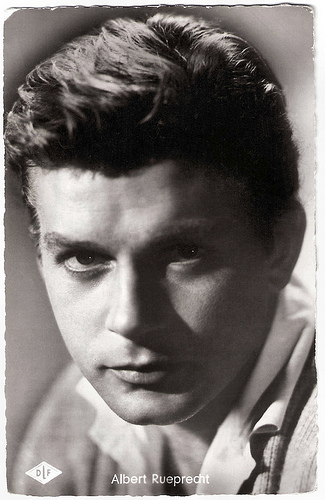
German postcard by Kolibri-Verlag, Minden/Westf., no. 2102. Photo: H.P. / Deutsche London / Schwennecke. Publicity still for Wo der Wildbach rauscht/Where the Wildbach rushes (Heinz Paul, 1956).
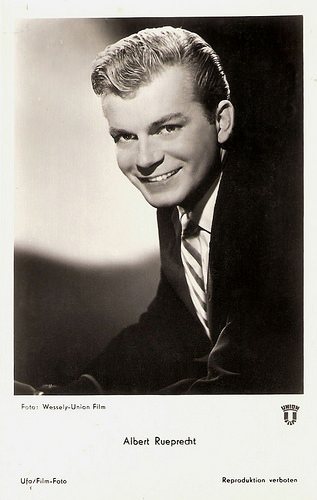
German postcard by Ufa, no. 6309/2. Photo: Wessely / Union-Film.
A Classic of the Heimatfilm
In 1954, Albert Rueprecht had a part in Echo der Berge/Echo of the mountains (Alfons Stummer, 1954), an Austrian classic of the Heimatfilm genre and one the most popular German language films ever.
He would play in many Heimatfilms of the 1950s, including Die Wirtin zur Goldenen Krone/The Innkeeper of the Golden Crown (Theo Lingen, 1955), Dort wo die Alpen glühen/Where the Alpine glow (Otto Meyer, 1956), and Im Prater blüh’n wieder die Bäume/Trees Are Blooming in Vienna (Hans Wolff, 1958) with Johanna Matz .
Often he was the good-looking jeune premier, which made him quite popular. His roles ranged from a young officer to a peasant in love, from the ‘elegant man of the world’ to the emperor.
In the last part of the Sissi trilogy, Sissi – Schicksalsjahre einer Kaiserin/Sissi - Fateful Years of an Empress (Ernst Marischka, 1957), he played the Archduke Ferdinand Max opposite Romy Schneider .
In total, Rueprecht made over 50 feature films, including the melodrama Das Licht der Liebe/The light of love (Robert Adolf Stemmle, 1954) with Paula Wessely as his mother, and Der Vogelhändler/The Bird Seller (Géza von Cziffra, 1962) with Conny Froboess .
After the end of the Heimatfilm wave, Rueprecht only got small roles including a few parts in international productions, such as Song Without End (Charles Walters, 1960) starring Dirk Bogarde . He participated in TV series and intensified his theatrical work, especially at the Theater in der Josefstadt.
In 2008 he played at the Mörbischer Seefestspiele the Emperor Franz Joseph in the operetta Im weißen Rößl (The White Horse Inn). His later films include Duett zu dritt/Tea for Three (Gerhard Janda, 1976) with Iris Berben, The Fifth Musketeer (Ken Annakin, 1979) and Ein Herz wird wieder jung/A heart becomes young again (Heide Pils, 1999).
Albert Rueprecht was married with the actresses Ellen Umlauf and Ann Millar (Elisabeth Rueprecht, born Millar) who died in 2010. His son is Alexander Rueprecht, from his marriage with Ellen Umlauf.
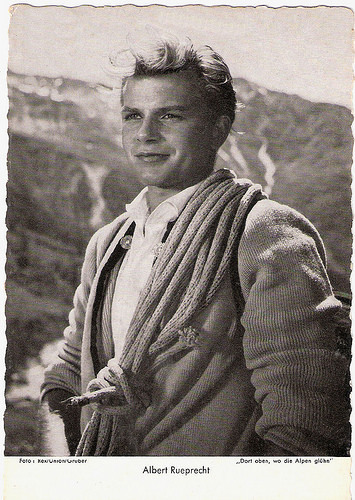
German postcard by WS-Druck, Wanne-Eickel, no. 144. Photo: Rex / Union / Gruber. Publicity still for Dort oben, wo die Alpen glühen/Up there where the Alps glow (Otto Meyer, 1956).
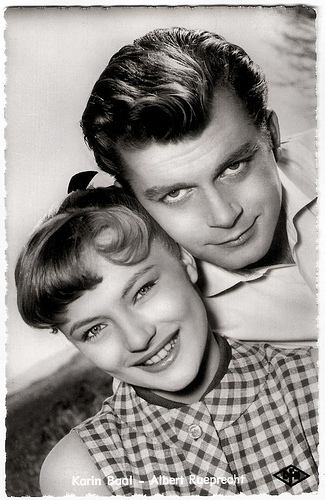
German postcard by Kolibri-Verlag, Minden/Westf., no. 2507. Photo: DFH / Lilo. Publicity still for Der müde Theodor/Tired Theodore (Géza von Cziffra, 1957) with Karin Baal .
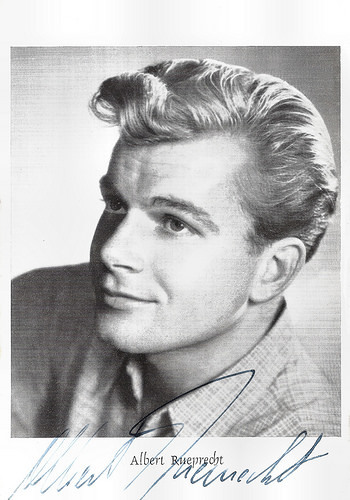
Vintage autograph card.
Sources: Wikipedia (German) and .

West-German postcard by DLF. Photo: Dörfler-Filmproduktion. Publicity still for Das sündige Dorf/The Village of Sin (Ferdinand Dörfler, 1954) with Renate Mannheim, Thomas Reyer, Albert Rueprecht and Hanna Hutten.
Romeo
Albert Rueprecht was born in 1929 in Vienna, the capital of Austria. He had his first stage experiences at the Akademischen Gymnasium when he played in Ferdinand Raimund’s Alpenkönig und Menschenfeind (King of the Alps and Enemy of the People).
From 1949 to 1951, he took acting classes with Zdenko Kestranek, Helmuth Krauss and Edward Wolters, teachers of the Max Reinhardt Seminar in Vienna. He had his first engagements as an actor at the Theater der Courage and the Theater am Parkring.
At the Wiener Volkstheater he played in 1953 Ferdinand in Kabale und Liebe (Intrigue and Love) by Friedrich Schiller. After appearances at Theater in der Josefstadt, he came in 1954 to the prestigious Burgtheater.
There he played among others Romeo in Romeo and Juliet, Don Juan in Dame Kobold by Calderón de la Barca and Gottfried in Das Käthchen von Heilbronn (Cathy of Heilbronn) by Heinrich von Kleist.
In 1955 he was in the cast of the historic production with which the Burgtheater re-opened: König Ottokars Glück und Ende (King Ottokar's Fortune and End) on the stage. For almost ten years he remained at the Burgtheater. From 1958 to 2004 he was an ensemble member at the Theater in der Josefstadt. There he played a total of over 80 roles.

German postcard by Kolibri-Verlag, Minden/Westf., no. 2102. Photo: H.P. / Deutsche London / Schwennecke. Publicity still for Wo der Wildbach rauscht/Where the Wildbach rushes (Heinz Paul, 1956).

German postcard by Ufa, no. 6309/2. Photo: Wessely / Union-Film.
A Classic of the Heimatfilm
In 1954, Albert Rueprecht had a part in Echo der Berge/Echo of the mountains (Alfons Stummer, 1954), an Austrian classic of the Heimatfilm genre and one the most popular German language films ever.
He would play in many Heimatfilms of the 1950s, including Die Wirtin zur Goldenen Krone/The Innkeeper of the Golden Crown (Theo Lingen, 1955), Dort wo die Alpen glühen/Where the Alpine glow (Otto Meyer, 1956), and Im Prater blüh’n wieder die Bäume/Trees Are Blooming in Vienna (Hans Wolff, 1958) with Johanna Matz .
Often he was the good-looking jeune premier, which made him quite popular. His roles ranged from a young officer to a peasant in love, from the ‘elegant man of the world’ to the emperor.
In the last part of the Sissi trilogy, Sissi – Schicksalsjahre einer Kaiserin/Sissi - Fateful Years of an Empress (Ernst Marischka, 1957), he played the Archduke Ferdinand Max opposite Romy Schneider .
In total, Rueprecht made over 50 feature films, including the melodrama Das Licht der Liebe/The light of love (Robert Adolf Stemmle, 1954) with Paula Wessely as his mother, and Der Vogelhändler/The Bird Seller (Géza von Cziffra, 1962) with Conny Froboess .
After the end of the Heimatfilm wave, Rueprecht only got small roles including a few parts in international productions, such as Song Without End (Charles Walters, 1960) starring Dirk Bogarde . He participated in TV series and intensified his theatrical work, especially at the Theater in der Josefstadt.
In 2008 he played at the Mörbischer Seefestspiele the Emperor Franz Joseph in the operetta Im weißen Rößl (The White Horse Inn). His later films include Duett zu dritt/Tea for Three (Gerhard Janda, 1976) with Iris Berben, The Fifth Musketeer (Ken Annakin, 1979) and Ein Herz wird wieder jung/A heart becomes young again (Heide Pils, 1999).
Albert Rueprecht was married with the actresses Ellen Umlauf and Ann Millar (Elisabeth Rueprecht, born Millar) who died in 2010. His son is Alexander Rueprecht, from his marriage with Ellen Umlauf.

German postcard by WS-Druck, Wanne-Eickel, no. 144. Photo: Rex / Union / Gruber. Publicity still for Dort oben, wo die Alpen glühen/Up there where the Alps glow (Otto Meyer, 1956).

German postcard by Kolibri-Verlag, Minden/Westf., no. 2507. Photo: DFH / Lilo. Publicity still for Der müde Theodor/Tired Theodore (Géza von Cziffra, 1957) with Karin Baal .

Vintage autograph card.
Sources: Wikipedia (German) and .
Published on January 18, 2017 22:00
January 17, 2017
Der brennende Acker (1922)
This week's film special is about the German silent film Der brennende Acker/Burning Soil (Friedrich Wilhelm Murnau, 1922). Murnau shot this drama right before his vampire classic Nosferatu (1922). Der brennende Acker is remarkable for its beautiful exterior shots and its all-star cast, including Vladimir Gajdarov and Lya de Putti. For many decades the film was considered lost, but in 1978 an almost complete print was found in the estate of an Italian priest. There also remains this beautiful series of postcards by Edition de la Cinématographie Française, published for the French release of the film, in France titled La terre qui flambe.
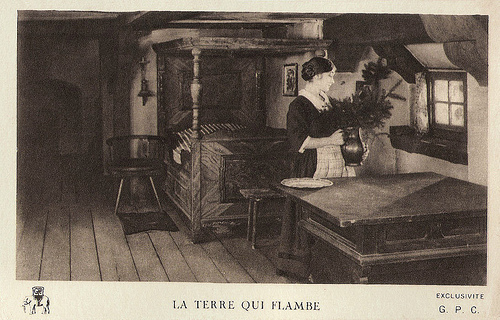
French postcard by Edition de la Cinématographie Française, Paris. Photo: G.P.C. Publicity still for Der brennende Acker/Burning Soil/La terre qui flambe (Friedrich Wilhelm Murnau, 1922). Maria (Grete Diercks) works in the household of Peter Rog and his father. Peter is in love with her and wants to marry her, but she instead loves his younger brother Johannes.
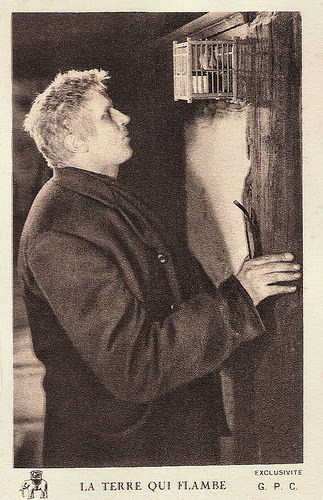
French postcard by Edition de la Cinématographie Française, Paris. Photo: G.P.C. Publicity still for Der brennende Acker/Burning Soil/La terre qui flambe (Friedrich Wilhelm Murnau, 1922) with Eugen Klöpfer as Peter Rog.
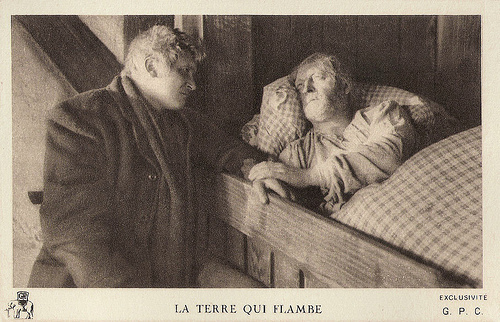
French postcard by Edition de la Cinématographie Française, Paris. Photo: G.P.C. Publicity still for Der brennende Acker/Burning Soil/La terre qui flambe (Friedrich Wilhelm Murnau, 1922). Peter Rog (Eugen Klöpfer) takes care of his dying father ( Werner Krauss ).
The Devil's Field
Der brennende Acker presents two households: that of the wealthy Count Josef Emmanuel of Rudenbergand the Rogs, a fairly prosperous farm family who live nearby.
When the old farmer Rog ( Werner Krauss ) dies, his hard-working son Peter (Eugen Klöpfer) attends him and stays at the farm after his father's death.
The other, younger son is the more worldly Johannes ( Vladimir Gajdarov ). He has great ambitions and he refuses the love of the servant Maria (Grete Diercks).
His ambition leads the handsome Johannes to charm Gerda ( Lya de Putti ), the daughter of the old Count Rudenberg (Eduard von Winterstein), who is also dying. Gerda helps Johannes to a job as the secretary of the Count.
Johannes discovers that the Count's second wife Helga (Stella Arbenina) will inherit the Devil's Field. Only he knows that the land sits on an untapped oil field worth a fortune.
Joahnnes turns his attention from Gerda to Helga. When she is widowed, he marries her. His greed leads to death and burning soil.
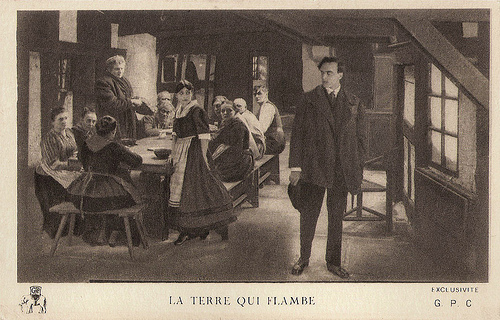
French postcard by Edition de la Cinématographie Française, Paris. Photo: G.P.C. Publicity still for Der brennende Acker/Burning Soil/La terre qui flambe (Friedrich Wilhelm Murnau, 1922). At the farm of the Rog family. The housemaid Maria (Grete Diercks) eyes Johannes Rog ( Vladimir Gajdarov ), but he is only interested in money.
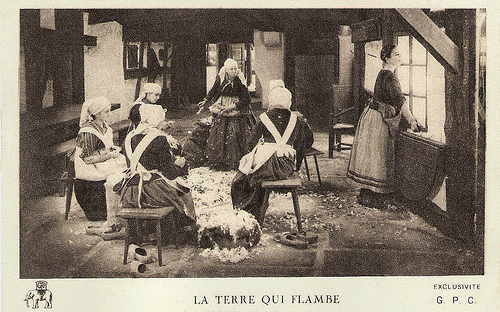
French postcard by Edition de la Cinématographie Française, Paris. Photo: G.P.C. Publicity still for Der brennende Acker/Burning Soil/La terre qui flambe (Friedrich Wilhelm Murnau, 1922) with Grete Diercks as the housemaid Marie.
Friedrich Wilhelm Murnau
In the 1920s Friedrich Wilhelm Murnau (1888-1931) was with Fritz Lang and G. W. Pabst one of the three great German film directors and Sandra Brennan at AllMovie writes that "To this day German filmmaker F.W.Murnau remains one of the most influential directors of cinema."
He made his directorial debut in 1919, the fantasy film Der Knabe in Blau/Emerald of Death (1919). His next films were also fantasy films: The three-part Satanas/Satan (1919), Murnau's first film with cinematographer Karl Freund and leading actor Conrad Veidt , and Der Bucklige und die Tänzerin/The Hunchback and the Dancer (1920), that marked the start of Murnau's collaboration with screenplay writer Carl Mayer.
With Schloss Vogelöd/The Haunted Castle (1921), filmed in only 16 days, Murnau already proved his ability to create an atmosphere of fear and horror, an ability that he masterly refined in Der Brennende Acker (1922) and his famous vampire film Nosferatu – Eine Symphonie des Grauens/Nosferatu, a Symphony of Horror (1922).
His next film, Der letzte Mann/The Last Laugh (1924), utilized unique camera techniques that later became the basis for mise-en-scene. For this film, Karl Freund masterly operated the 'moving camera'.
Besides Der letzte Mann, Murnau's literary adaptations Tartüff/Tartuffe (1925) and Faust (1925/26) also rank among the classic films of Weimar cinema produced by Erich Pommer.
In 1926, Murnau moved to Hollywood to work for Fox studios. His first American film, Sunrise: A Story of Two Humans (1927), is considered to be the apex of German silent cinema, and won an Academy award for its artistic quality.
His next film Four Devils (1928) was turned into a happy ending and was equipped with a sound track. The same happened to Our Daily Bread/City Girl (1929/30).
Murnau returned to Berlin but his negotiations with Ufa did not lead to a result. In 1929, he travelled to Tahiti where he made the naïve love story Tabu (1931) at his own expense. Deep in debt, he returned to Hollywood, where Paramount offered him a ten-year contract.
Tabu became a box-office hit, but the week before it opened, F.W. Murnau was killed in an auto accident. He was only 42.
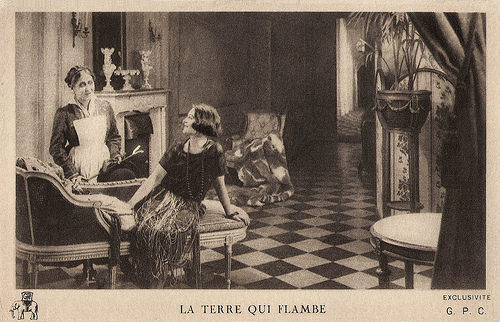
French postcard by Edition de la Cinématographie Française, Paris. Photo: G.P.C. Publicity still for Der brennende Acker/Burning Soil/La terre qui flambe (Friedrich Wilhelm Murnau, 1922). Gerda ( Lya de Putti ) and her maid (Leonie Taliansky).
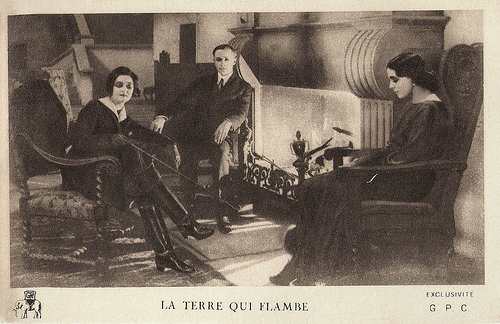
French postcard by Edition de la Cinématographie Française, Paris. Photo: G.P.C. Publicity still for Der brennende Acker/Burning Soil/La terre qui flambe (Friedrich Wilhelm Murnau, 1922). Count Rudenburg (Eduard von Winterstein), flanked by, left, his daughter Gerda ( Lya de Putti ), and right, his second wife Helga (Stella Arbenina).
Der brennende Acker
Der brennende Acker/Burning Soil or in French La terre qui flambe was considered lost for a long time. In 1978 an almost complete print was found in the estate of an Italian priest, who had organised screenings with his film collection in mental hospitals
Since then, Der brennende Acker is acclaimed for its visual quality, the contrast between the simple rustic farm and the airy and elegant castle. Thorkell A. Ottarsson at IMDb : "The film is quite dramatic and dark, even surprisingly dark at times. A superb film from one of the best directors of all time."
To achieve his visual effects, innovative camera angles, and bold lighting, Murnau had two of the most renowned cameramen photographing the film. Fritz Arno Wagner filmed the first part and Karl Freund the second part, and the sets were built by the equally renowned Rochus Gliese.
Karl Freund, who began as a projectionist in Berlin and newsreel cameraman, worked for Ufa in the 1920s and gained the international reputation of being a master cameraman. His later credits include such classics as Metropolis, Der Lezte Mann/The Last Laugh, Der Golem/The Golem and Variété/Variety.
W. Morrow at IMDb describes beautifully his fascination for Der brennende Acker: "a sustained mood of wintry melancholy, perked by a number of understated but impressive directorial touches. There's business involving a document torn into little pieces that is poetic. When Murnau was at his peak, in such films as Faust and Sunrise, he would stage his effects on a much grander scale, but here he manages to create a beautiful moment with a few torn pieces of paper."
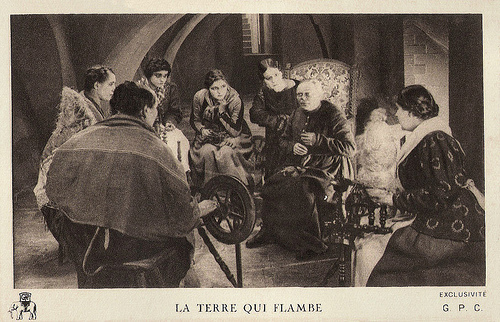
French postcard by Edition de la Cinématographie Française, Paris. Photo: G.P.C. Publicity still for Der brennende Acker/Burning Soil/La terre qui flambe (Friedrich Wilhelm Murnau, 1922). The old maid talks to the young servants about the Devil's Field.
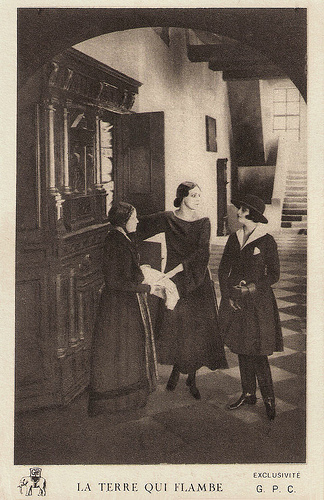
French postcard by Edition de la Cinématographie Française, Paris. Photo: G.P.C. Publicity still for Der brennende Acker/Burning Soil/La terre qui flambe (Friedrich Wilhelm Murnau, 1922). Helga, Count Rudenburg's second wife (Stella Arbenina), and Gerda, the Count's daughter ( Lya de Putti ), in a fierce get together.
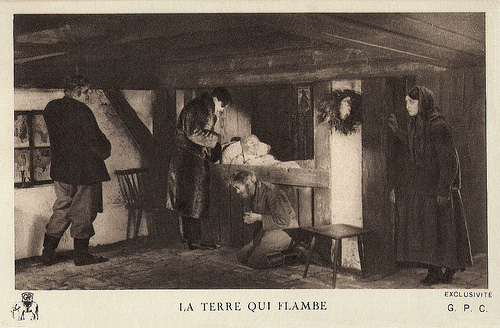 French postcard by Edition de la Cinématographie Française, Paris. Photo: G.P.C. Publicity still for Der brennende Acker/Burning Soil/La terre qui flambe (Friedrich Wilhelm Murnau, 1922). Johannes Rog (
Vladimir Gajdarov
) arrives too late at the deathbed of his father (
Werner Krauss
), while, left, his brother Peter (Eugen Klöpfer), and right, the maid Maria (Grete Diercks), look on.
French postcard by Edition de la Cinématographie Française, Paris. Photo: G.P.C. Publicity still for Der brennende Acker/Burning Soil/La terre qui flambe (Friedrich Wilhelm Murnau, 1922). Johannes Rog (
Vladimir Gajdarov
) arrives too late at the deathbed of his father (
Werner Krauss
), while, left, his brother Peter (Eugen Klöpfer), and right, the maid Maria (Grete Diercks), look on.
Sources: Sandra Brennan (AllMovie), John DeBartolo (Silents are Golden), W. Morrow (IMDb), Thorkell A. Ottarsson (IMDb), Yepok (IMDb), Filmportal.de (German), Wikipedia (German) and IMDb.

French postcard by Edition de la Cinématographie Française, Paris. Photo: G.P.C. Publicity still for Der brennende Acker/Burning Soil/La terre qui flambe (Friedrich Wilhelm Murnau, 1922). Maria (Grete Diercks) works in the household of Peter Rog and his father. Peter is in love with her and wants to marry her, but she instead loves his younger brother Johannes.

French postcard by Edition de la Cinématographie Française, Paris. Photo: G.P.C. Publicity still for Der brennende Acker/Burning Soil/La terre qui flambe (Friedrich Wilhelm Murnau, 1922) with Eugen Klöpfer as Peter Rog.

French postcard by Edition de la Cinématographie Française, Paris. Photo: G.P.C. Publicity still for Der brennende Acker/Burning Soil/La terre qui flambe (Friedrich Wilhelm Murnau, 1922). Peter Rog (Eugen Klöpfer) takes care of his dying father ( Werner Krauss ).
The Devil's Field
Der brennende Acker presents two households: that of the wealthy Count Josef Emmanuel of Rudenbergand the Rogs, a fairly prosperous farm family who live nearby.
When the old farmer Rog ( Werner Krauss ) dies, his hard-working son Peter (Eugen Klöpfer) attends him and stays at the farm after his father's death.
The other, younger son is the more worldly Johannes ( Vladimir Gajdarov ). He has great ambitions and he refuses the love of the servant Maria (Grete Diercks).
His ambition leads the handsome Johannes to charm Gerda ( Lya de Putti ), the daughter of the old Count Rudenberg (Eduard von Winterstein), who is also dying. Gerda helps Johannes to a job as the secretary of the Count.
Johannes discovers that the Count's second wife Helga (Stella Arbenina) will inherit the Devil's Field. Only he knows that the land sits on an untapped oil field worth a fortune.
Joahnnes turns his attention from Gerda to Helga. When she is widowed, he marries her. His greed leads to death and burning soil.

French postcard by Edition de la Cinématographie Française, Paris. Photo: G.P.C. Publicity still for Der brennende Acker/Burning Soil/La terre qui flambe (Friedrich Wilhelm Murnau, 1922). At the farm of the Rog family. The housemaid Maria (Grete Diercks) eyes Johannes Rog ( Vladimir Gajdarov ), but he is only interested in money.

French postcard by Edition de la Cinématographie Française, Paris. Photo: G.P.C. Publicity still for Der brennende Acker/Burning Soil/La terre qui flambe (Friedrich Wilhelm Murnau, 1922) with Grete Diercks as the housemaid Marie.
Friedrich Wilhelm Murnau
In the 1920s Friedrich Wilhelm Murnau (1888-1931) was with Fritz Lang and G. W. Pabst one of the three great German film directors and Sandra Brennan at AllMovie writes that "To this day German filmmaker F.W.Murnau remains one of the most influential directors of cinema."
He made his directorial debut in 1919, the fantasy film Der Knabe in Blau/Emerald of Death (1919). His next films were also fantasy films: The three-part Satanas/Satan (1919), Murnau's first film with cinematographer Karl Freund and leading actor Conrad Veidt , and Der Bucklige und die Tänzerin/The Hunchback and the Dancer (1920), that marked the start of Murnau's collaboration with screenplay writer Carl Mayer.
With Schloss Vogelöd/The Haunted Castle (1921), filmed in only 16 days, Murnau already proved his ability to create an atmosphere of fear and horror, an ability that he masterly refined in Der Brennende Acker (1922) and his famous vampire film Nosferatu – Eine Symphonie des Grauens/Nosferatu, a Symphony of Horror (1922).
His next film, Der letzte Mann/The Last Laugh (1924), utilized unique camera techniques that later became the basis for mise-en-scene. For this film, Karl Freund masterly operated the 'moving camera'.
Besides Der letzte Mann, Murnau's literary adaptations Tartüff/Tartuffe (1925) and Faust (1925/26) also rank among the classic films of Weimar cinema produced by Erich Pommer.
In 1926, Murnau moved to Hollywood to work for Fox studios. His first American film, Sunrise: A Story of Two Humans (1927), is considered to be the apex of German silent cinema, and won an Academy award for its artistic quality.
His next film Four Devils (1928) was turned into a happy ending and was equipped with a sound track. The same happened to Our Daily Bread/City Girl (1929/30).
Murnau returned to Berlin but his negotiations with Ufa did not lead to a result. In 1929, he travelled to Tahiti where he made the naïve love story Tabu (1931) at his own expense. Deep in debt, he returned to Hollywood, where Paramount offered him a ten-year contract.
Tabu became a box-office hit, but the week before it opened, F.W. Murnau was killed in an auto accident. He was only 42.

French postcard by Edition de la Cinématographie Française, Paris. Photo: G.P.C. Publicity still for Der brennende Acker/Burning Soil/La terre qui flambe (Friedrich Wilhelm Murnau, 1922). Gerda ( Lya de Putti ) and her maid (Leonie Taliansky).

French postcard by Edition de la Cinématographie Française, Paris. Photo: G.P.C. Publicity still for Der brennende Acker/Burning Soil/La terre qui flambe (Friedrich Wilhelm Murnau, 1922). Count Rudenburg (Eduard von Winterstein), flanked by, left, his daughter Gerda ( Lya de Putti ), and right, his second wife Helga (Stella Arbenina).
Der brennende Acker
Der brennende Acker/Burning Soil or in French La terre qui flambe was considered lost for a long time. In 1978 an almost complete print was found in the estate of an Italian priest, who had organised screenings with his film collection in mental hospitals
Since then, Der brennende Acker is acclaimed for its visual quality, the contrast between the simple rustic farm and the airy and elegant castle. Thorkell A. Ottarsson at IMDb : "The film is quite dramatic and dark, even surprisingly dark at times. A superb film from one of the best directors of all time."
To achieve his visual effects, innovative camera angles, and bold lighting, Murnau had two of the most renowned cameramen photographing the film. Fritz Arno Wagner filmed the first part and Karl Freund the second part, and the sets were built by the equally renowned Rochus Gliese.
Karl Freund, who began as a projectionist in Berlin and newsreel cameraman, worked for Ufa in the 1920s and gained the international reputation of being a master cameraman. His later credits include such classics as Metropolis, Der Lezte Mann/The Last Laugh, Der Golem/The Golem and Variété/Variety.
W. Morrow at IMDb describes beautifully his fascination for Der brennende Acker: "a sustained mood of wintry melancholy, perked by a number of understated but impressive directorial touches. There's business involving a document torn into little pieces that is poetic. When Murnau was at his peak, in such films as Faust and Sunrise, he would stage his effects on a much grander scale, but here he manages to create a beautiful moment with a few torn pieces of paper."

French postcard by Edition de la Cinématographie Française, Paris. Photo: G.P.C. Publicity still for Der brennende Acker/Burning Soil/La terre qui flambe (Friedrich Wilhelm Murnau, 1922). The old maid talks to the young servants about the Devil's Field.

French postcard by Edition de la Cinématographie Française, Paris. Photo: G.P.C. Publicity still for Der brennende Acker/Burning Soil/La terre qui flambe (Friedrich Wilhelm Murnau, 1922). Helga, Count Rudenburg's second wife (Stella Arbenina), and Gerda, the Count's daughter ( Lya de Putti ), in a fierce get together.
 French postcard by Edition de la Cinématographie Française, Paris. Photo: G.P.C. Publicity still for Der brennende Acker/Burning Soil/La terre qui flambe (Friedrich Wilhelm Murnau, 1922). Johannes Rog (
Vladimir Gajdarov
) arrives too late at the deathbed of his father (
Werner Krauss
), while, left, his brother Peter (Eugen Klöpfer), and right, the maid Maria (Grete Diercks), look on.
French postcard by Edition de la Cinématographie Française, Paris. Photo: G.P.C. Publicity still for Der brennende Acker/Burning Soil/La terre qui flambe (Friedrich Wilhelm Murnau, 1922). Johannes Rog (
Vladimir Gajdarov
) arrives too late at the deathbed of his father (
Werner Krauss
), while, left, his brother Peter (Eugen Klöpfer), and right, the maid Maria (Grete Diercks), look on.Sources: Sandra Brennan (AllMovie), John DeBartolo (Silents are Golden), W. Morrow (IMDb), Thorkell A. Ottarsson (IMDb), Yepok (IMDb), Filmportal.de (German), Wikipedia (German) and IMDb.
Published on January 17, 2017 22:00
January 16, 2017
Sophie Marceau
French actress Sophie Marceau (1966) became a European film star with a string of successful films, including La boum/The Party (1980), L'Étudiante/The Student (1988), Fanfan (1993), and La fille de d'Artagnan/Revenge of the Musketeers (1994). Internationally she became known with her performances in Braveheart (1995), and the 19th James Bond film The World Is Not Enough (1999). She received a Cesar for La Boum 2 (1983) and she won a Moliere award for a stage production of Eurydice in 1991.
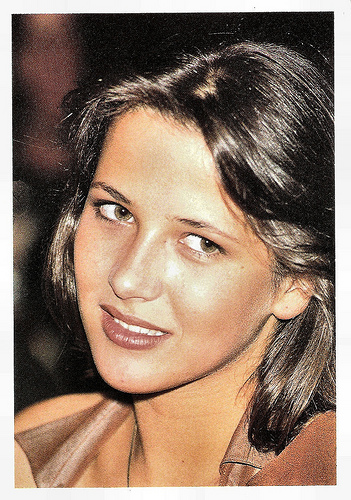
French postcard, no. 956. Photo: Patrick Davy.
La Boum
Sophie Marceau was born Sophie Danièle Sylvie Maupu in 1966 in Paris, France. She has a three-years-older brother, Sylvain. Her parents, Simone (Morisset), a shop assistant, and Benoît Maupu, a truck driver, divorced when she was nine years old.
She grew up far from the studio spotlights in the Paris suburb of Gentilly. When she was 14, she auditioned for a role in a film about teenagers called La Boum/The Party (1980) and director Claude Pinoteau gave her the leading role. After viewing the rushes, Alain Poiré, director of the Gaumont Film Company, signed Marceau to a long-term contract.
The comedy La Boum was a hit, not only in France, where 4,378,500 tickets were sold, but also in several other European countries. She also played in La Boum 2/The Party 2 (Claude Pinoteau, 1982), another hit, for which she received the Cesar for Most Promising Actress in 1983.
Then the 16-years-old actress bought back her contract with Gaumont for one million French francs, for which she had to borrow a lot of money. She went to study at the Ecole Florent in Paris, and focused on more dramatic roles. She played roles in the historical war drama Fort Saganne (Alain Corneau, 1984) with Gérard Depardieu and Catherine Deneuve , the romantic drama L'amour braque/Mad Love (Andrzej Zulawski, 1985) with Francis Huster , the crime drama Police (Maurice Pialat, 1985), and the psychological thriller Descente aux enfers/Descent Into Hell (Francis Girod, 1986).
In 1988, she starred in the romantic comedy L'Étudiante/The Student (Claude Pinoteau, 1988) and the historical adventure film Chouans! (Philippe de Broca, 1988), based on the novel by Honoré de Balzac. That year, Marceau was named Best Romantic Actress at the Festival International du Film Romantique (International Festival of Romantic Film) in Cabourg for her role in Chouans!
Marceau next starred with Jacques Dutronc in Mes nuits sont plus belles que vos jours/My Nights Are More Beautiful Than Your Days (1989), which was directed by her long-time companion Andrzej Zulawski. The following year, she starred in her American debut Pacific Palisades (Bernard Schmitt, 1990) and in La note bleue/The Blue Note (Andrzej Zulawski, 1990), her third film directed by Zulawski.
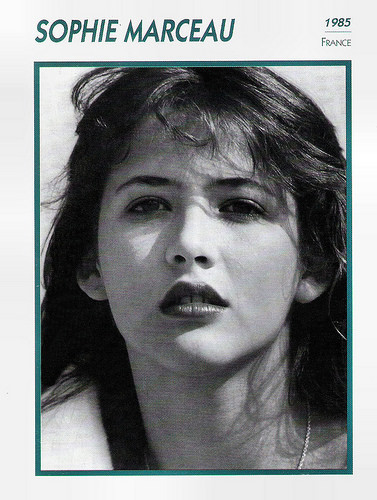
French collectors card in the series 'Portrait de Stars; L'encyclopédie du Cinéma' by Edito Service, 1991. Photo: Gamma Caption: Sophie Marceau, 1985, France.
The World Is Not Enough
In 1991, Sophie Marcerau made her stage debut in Jean Anouilh's Eurydice. She was awarded the Moliere Award for Best Newcomer.
Marceau began to make less dramatic films. She starred with Vincent Perez in the comedy Fanfan (Alexandre Jardin, 1993) and the Swashbuckler adventure La fille de d'Artagnan/Revenge of the Musketeers (Bertrand Tavernier, 1994). Both were popular in France, but received mixed reviews.
In 1994, she returned to the theatre as Eliza Doolittle in G.B. Shaw’s Pygmalion. Marceau had her international breakthrough in 1995 when she played Isabelle, Princess of Wales in the historical epic Braveheart (Mel Gibson, 1995). The film was nominated for ten Academy awards and won five, including Best Picture and Best Director.
That year, she was also part of an ensemble of international actors in Al di là delle nuvole/Beyond the Clouds (1995), directed by Michelangelo Antonioni and Wim Wenders. In 1997 followed the title role in Anna Karenina (Bernard Rose 1997), filmed in Russia. She played Hippolyta in the Shakespeare adaptation A Midsummer Night's Dream (Michael Hoffman, 1999).
Arguably her best known role is the villainess Bond girl Elektra King in The World Is Not Enough (Michael Apted, 1999), the third film with Pierce Brosnan as MI6 agent 007. Despite mixed critical reception, The World Is Not Enough earned $361,832,400 worldwide.
Marceau teamed up again with Zulawski to film La fidélité/Fidelity (Andrzej Zulawski, 2000), playing the role of a talented photographer who takes a job at a scandal-mongering tabloid and becomes romantically involved with an eccentric children's book publisher.
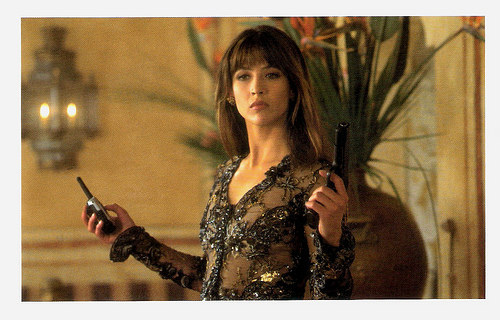
British postcard by EON Productions. Photo: Danjaq / LLC / United Artists Corporation. Publicity still for The World is Not Enough (Michael Apted, 1999) with Sophie Marceau as Elektra King.
Speak to Me of Love
From 2000 on, Sophie Marceau worked mainly in France. In 2002, she made her directorial debut in the feature film Speak to Me of Love, for which she was named Best Director at the Montreal World Film Festival. The film starred Judith Godrèche. It was her second directorial effort, following her nine-minute short film L'aube à l'envers (1995), which had opened the Un Certain Regard section at the Cannes Film Festival that year.
Marceau played a widowed nurse in À ce soir/Nelly (Laure Duthilleul, 2004), an undercover police agent in the romantic thriller Anthony Zimmer (Jérôme Salle, 2005), and the troubled daughter of a murdered film star in La disparue de Deauville/Trivial (2007), her second feature as a director.
Marceau played a member of the French Resistance in Les Femmes de l'ombre/Female Agents (Jean-Paul Salomé, 2008), and she teamed up with Monica Bellucci in the thriller Ne te retourne pas/Don't Look Back (Marina de Van, 2009) about the mysterious connection between two women who have never met.
She played a successful business executive forced to confront her unhappy childhood in the romantic comedy L'âge de raison/With Love... from the Age of Reason (Yann Samuell, 2010). Recent films include the thriller Arrêtez-moi/Arrest Me (Jean-Paul Lilienfeld, 2013) and the French-Belgian drama La Taularde/Jailbirds (Audrey Estrougo, 2015). In 2015, she was a member of the jury of the Cannes Film Festival.
From 1984 to 2001, Sophie Marceau was in a relationship with Polish/French director Andrzej Zulawski. They have a son, Vincent Zulawkski (1985). Later she was in long-time relationships with producer Jim Lemley, and with actor Christophe Lambert . With Lemley she has a daughter, Juliette Lemley (2002).
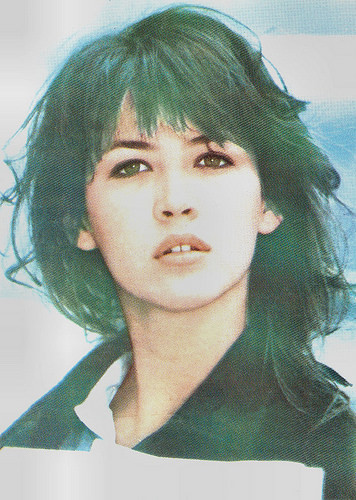
Romanian postcard by Casa Filmului Acin. Photo: publicity still for L'étudiante/The Student (Claude Pinoteau, 1988).
Sources: Yuri German (AllMovie), Marceau.co.uk, Wikipedia and .

French postcard, no. 956. Photo: Patrick Davy.
La Boum
Sophie Marceau was born Sophie Danièle Sylvie Maupu in 1966 in Paris, France. She has a three-years-older brother, Sylvain. Her parents, Simone (Morisset), a shop assistant, and Benoît Maupu, a truck driver, divorced when she was nine years old.
She grew up far from the studio spotlights in the Paris suburb of Gentilly. When she was 14, she auditioned for a role in a film about teenagers called La Boum/The Party (1980) and director Claude Pinoteau gave her the leading role. After viewing the rushes, Alain Poiré, director of the Gaumont Film Company, signed Marceau to a long-term contract.
The comedy La Boum was a hit, not only in France, where 4,378,500 tickets were sold, but also in several other European countries. She also played in La Boum 2/The Party 2 (Claude Pinoteau, 1982), another hit, for which she received the Cesar for Most Promising Actress in 1983.
Then the 16-years-old actress bought back her contract with Gaumont for one million French francs, for which she had to borrow a lot of money. She went to study at the Ecole Florent in Paris, and focused on more dramatic roles. She played roles in the historical war drama Fort Saganne (Alain Corneau, 1984) with Gérard Depardieu and Catherine Deneuve , the romantic drama L'amour braque/Mad Love (Andrzej Zulawski, 1985) with Francis Huster , the crime drama Police (Maurice Pialat, 1985), and the psychological thriller Descente aux enfers/Descent Into Hell (Francis Girod, 1986).
In 1988, she starred in the romantic comedy L'Étudiante/The Student (Claude Pinoteau, 1988) and the historical adventure film Chouans! (Philippe de Broca, 1988), based on the novel by Honoré de Balzac. That year, Marceau was named Best Romantic Actress at the Festival International du Film Romantique (International Festival of Romantic Film) in Cabourg for her role in Chouans!
Marceau next starred with Jacques Dutronc in Mes nuits sont plus belles que vos jours/My Nights Are More Beautiful Than Your Days (1989), which was directed by her long-time companion Andrzej Zulawski. The following year, she starred in her American debut Pacific Palisades (Bernard Schmitt, 1990) and in La note bleue/The Blue Note (Andrzej Zulawski, 1990), her third film directed by Zulawski.

French collectors card in the series 'Portrait de Stars; L'encyclopédie du Cinéma' by Edito Service, 1991. Photo: Gamma Caption: Sophie Marceau, 1985, France.
The World Is Not Enough
In 1991, Sophie Marcerau made her stage debut in Jean Anouilh's Eurydice. She was awarded the Moliere Award for Best Newcomer.
Marceau began to make less dramatic films. She starred with Vincent Perez in the comedy Fanfan (Alexandre Jardin, 1993) and the Swashbuckler adventure La fille de d'Artagnan/Revenge of the Musketeers (Bertrand Tavernier, 1994). Both were popular in France, but received mixed reviews.
In 1994, she returned to the theatre as Eliza Doolittle in G.B. Shaw’s Pygmalion. Marceau had her international breakthrough in 1995 when she played Isabelle, Princess of Wales in the historical epic Braveheart (Mel Gibson, 1995). The film was nominated for ten Academy awards and won five, including Best Picture and Best Director.
That year, she was also part of an ensemble of international actors in Al di là delle nuvole/Beyond the Clouds (1995), directed by Michelangelo Antonioni and Wim Wenders. In 1997 followed the title role in Anna Karenina (Bernard Rose 1997), filmed in Russia. She played Hippolyta in the Shakespeare adaptation A Midsummer Night's Dream (Michael Hoffman, 1999).
Arguably her best known role is the villainess Bond girl Elektra King in The World Is Not Enough (Michael Apted, 1999), the third film with Pierce Brosnan as MI6 agent 007. Despite mixed critical reception, The World Is Not Enough earned $361,832,400 worldwide.
Marceau teamed up again with Zulawski to film La fidélité/Fidelity (Andrzej Zulawski, 2000), playing the role of a talented photographer who takes a job at a scandal-mongering tabloid and becomes romantically involved with an eccentric children's book publisher.

British postcard by EON Productions. Photo: Danjaq / LLC / United Artists Corporation. Publicity still for The World is Not Enough (Michael Apted, 1999) with Sophie Marceau as Elektra King.
Speak to Me of Love
From 2000 on, Sophie Marceau worked mainly in France. In 2002, she made her directorial debut in the feature film Speak to Me of Love, for which she was named Best Director at the Montreal World Film Festival. The film starred Judith Godrèche. It was her second directorial effort, following her nine-minute short film L'aube à l'envers (1995), which had opened the Un Certain Regard section at the Cannes Film Festival that year.
Marceau played a widowed nurse in À ce soir/Nelly (Laure Duthilleul, 2004), an undercover police agent in the romantic thriller Anthony Zimmer (Jérôme Salle, 2005), and the troubled daughter of a murdered film star in La disparue de Deauville/Trivial (2007), her second feature as a director.
Marceau played a member of the French Resistance in Les Femmes de l'ombre/Female Agents (Jean-Paul Salomé, 2008), and she teamed up with Monica Bellucci in the thriller Ne te retourne pas/Don't Look Back (Marina de Van, 2009) about the mysterious connection between two women who have never met.
She played a successful business executive forced to confront her unhappy childhood in the romantic comedy L'âge de raison/With Love... from the Age of Reason (Yann Samuell, 2010). Recent films include the thriller Arrêtez-moi/Arrest Me (Jean-Paul Lilienfeld, 2013) and the French-Belgian drama La Taularde/Jailbirds (Audrey Estrougo, 2015). In 2015, she was a member of the jury of the Cannes Film Festival.
From 1984 to 2001, Sophie Marceau was in a relationship with Polish/French director Andrzej Zulawski. They have a son, Vincent Zulawkski (1985). Later she was in long-time relationships with producer Jim Lemley, and with actor Christophe Lambert . With Lemley she has a daughter, Juliette Lemley (2002).

Romanian postcard by Casa Filmului Acin. Photo: publicity still for L'étudiante/The Student (Claude Pinoteau, 1988).
Sources: Yuri German (AllMovie), Marceau.co.uk, Wikipedia and .
Published on January 16, 2017 22:00
January 15, 2017
Jarmila Novotná
Czech soprano Jarmila Novotná (1907-1994) was one of the world-renowned opera luminaries of the 20th Century. Her film appearances were unfortunately few and far between.
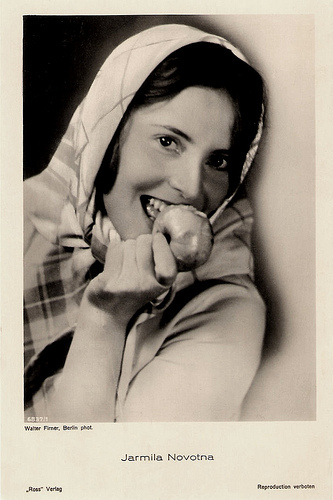
German postcard by Ross Verlag, no. 6837/1, 1931-1932. Photo: Walter Firner, Berlin.
The Bartered Bride
Jarmila Novotná was born in Prague, Czech Republic in 1907. She studied singing with Emmy Destinn.
In 1925, the 17-years-old Novotná made her operatic debut at the Prague Opera House as Marenka in Bedřich Smetana's Prodaná nevěsta (The Bartered Bride). Six days later, the lyric soprano sang there as Violetta in Giuseppe Verdi's La traviata.
The following year, she made her film debut in the silent film Vyznavaci slunce/The Sun Disciples (Václav Binovec, 1926), starring Luigi Serventi .
In 1928 she starred in Verona as Gilda opposite Giacomo Lauri-Volpi in Verdi's Rigoletto and at the Teatro San Carlo in Naples as Adina opposite Tito Schipa in Gaetano Donizetti's L'elisir d'amore. In 1929 she joined the Kroll Opera in Berlin, where she sang Violetta as well as the title roles of Giacomo Puccini's Manon Lescaut and Madama Butterfly.
When talking pictures arrived, she headlined in German films like Brand in Der Oper/Fire in the Opera House (Carl Froelich, 1930), with Gustaf Gründgens, Der Bettelstudent/The Beggar Student (Victor Janson, 1931), and the film version of The Bartered Bride, Die Verkaufte Braut (Max Ophüls, 1932).
Hal Erickson at AllMovie on Die Verkaufte Braut (1930): “The original libretto, involving the comic misadventures of two mismatched couples, is given a respectable amount of attention, but the film's biggest selling card is the photographic dexterity of Max Ophuls, who never met a camera crane he didn't like. Since filmed opera was seldom big box-office in 1932, Ophuls concentrates on the farcical elements of the story; especially worth noting are comic contributions by Paul Kemp and Otto Wernicke, who seldom let their German film fans down. Curiously, star Jarmila Novotna, whose ‘live’ appearances in The Bartered Bride were much prized by contemporary critics, doesn't come off all that well in this film version.”
Other films followed such as Nacht Der Grossen Liebe/Night of the Great Love (Geza von Bolvary, 1933) with Gustav Fröhlich . In January 1933 she created the female lead in Jaromir Weinberger's new operetta Frühlingsstürme (Spring Storms), opposite Richard Tauber at the Theater im Admiralspalast, Berlin. This was the last new operetta produced in the Weimar Republic, and she and Tauber were both soon forced to leave Germany by the new Nazi regime.
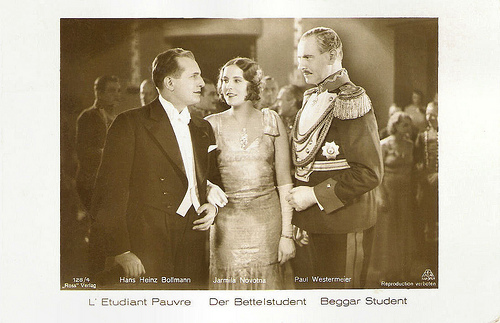
German postcard by Ross Verlag, no. 128/4. Photo: Aafa Film. Publicity still for Der Bettelstudent/The Beggar Student (Victor Janson, 1931) with Jarmila Novotna, Paul Westermeier and Hans Heinz Bollmann.
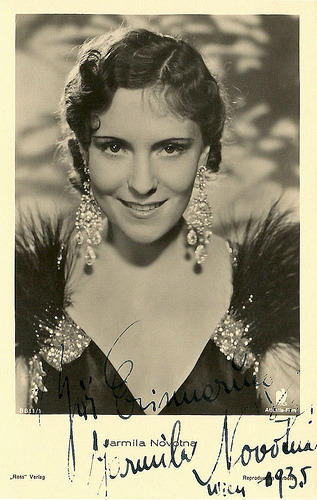
German postcard by Ross Verlag, no. 8811/1, 1933-1934. Photo: Atlantis-Film. Collection: Didier Hanson.
The Last Waltz
Jarmila Novotnà returned to Czechoslovakia to star in the film Skrivanci pisen/Lark's Songs (Svatopluk Innemann, 1933).
In 1934, she left for Vienna, where she created the title role in Franz Lehár's operetta Giuditta opposite Richard Tauber . Her immense success in that role led to a contract with the Vienna State Opera, where she was named Kammersängerin. She also appeared there with Tauber in The Bartered Bride and Madama Butterfly.
In the cinema, she starred in the Austrian operetta film Frasquita (Karel Lamac, 1934) with Heinz Ruhmann , the Austrian romantic thriller Der Kosak und die Nachtigall/The Cossack and the Nightingale (Phil Jutzi, 1935) with Iván Petrovich , and in the French-British operetta film La dernière valse/The Last Waltz (Leo Mittler, 1935), which was made in two language versions.
She then left the film industry to concentrate on her stage work with the Viennese State Opera. After the Anschluss of Austria, she had to leave Vienna.
In January 1940 she made her debut with the Metropolitan Opera in New York, as Mimí in Puccini's La bohème. From 1940 to 1956, Novotná performed regularly at the Met.
In 1946 she returned before the cameras in a straight dramatic role in the Hollywood production The Search (Fred Zinnemann, 1946), starring Montgomery Clift. The Search is a semi-documentary film on the plight of WWII orphans. Novotná played a Czech mother who has lost contact with her young son when they were in Auschwitz and she now travels from one refugee camp to another in search of him.
Novotna's then played turn of the century diva Maria Selka in the biopic The Great Caruso (Richard Thorpe, 1951), featuring Mario Lanza. The film traces legendary tenor Enrico Caruso's ascension from adolescent choir singer in Naples to the uppermost ranks of the opera world. Mario Lanza's tenor voice made this film one of the top box-office draws of 1951, and this helped to popularise opera among the general public.
On TV she appeared in The Great Waltz (Max Liebman, 1955), which charts the life and times of composer Johann Strauss, Jr. She also played Hans’ mother in the TV musical Hans Brinker, or the Silver Skates (Sidney Lumet, 1958), starring Tab Hunter . Her last screen appearance was as an interviewee in the documentary Toscanini: The Maestro (Peter Rosen, 1985).
At 85, Jarmila Novotná passed away in New York in 1994.
Jarmila Novotna in Skrivanci pisen/Lark's Songs (1933). Source: Radio Santos (YouTube).
Jarmila Novotna and Keith Andes in The Great Waltz (1955). Source: Vai Music (YouTube).
Sources: Hal Erickson (AllMovie), Wikipedia, and .

German postcard by Ross Verlag, no. 6837/1, 1931-1932. Photo: Walter Firner, Berlin.
The Bartered Bride
Jarmila Novotná was born in Prague, Czech Republic in 1907. She studied singing with Emmy Destinn.
In 1925, the 17-years-old Novotná made her operatic debut at the Prague Opera House as Marenka in Bedřich Smetana's Prodaná nevěsta (The Bartered Bride). Six days later, the lyric soprano sang there as Violetta in Giuseppe Verdi's La traviata.
The following year, she made her film debut in the silent film Vyznavaci slunce/The Sun Disciples (Václav Binovec, 1926), starring Luigi Serventi .
In 1928 she starred in Verona as Gilda opposite Giacomo Lauri-Volpi in Verdi's Rigoletto and at the Teatro San Carlo in Naples as Adina opposite Tito Schipa in Gaetano Donizetti's L'elisir d'amore. In 1929 she joined the Kroll Opera in Berlin, where she sang Violetta as well as the title roles of Giacomo Puccini's Manon Lescaut and Madama Butterfly.
When talking pictures arrived, she headlined in German films like Brand in Der Oper/Fire in the Opera House (Carl Froelich, 1930), with Gustaf Gründgens, Der Bettelstudent/The Beggar Student (Victor Janson, 1931), and the film version of The Bartered Bride, Die Verkaufte Braut (Max Ophüls, 1932).
Hal Erickson at AllMovie on Die Verkaufte Braut (1930): “The original libretto, involving the comic misadventures of two mismatched couples, is given a respectable amount of attention, but the film's biggest selling card is the photographic dexterity of Max Ophuls, who never met a camera crane he didn't like. Since filmed opera was seldom big box-office in 1932, Ophuls concentrates on the farcical elements of the story; especially worth noting are comic contributions by Paul Kemp and Otto Wernicke, who seldom let their German film fans down. Curiously, star Jarmila Novotna, whose ‘live’ appearances in The Bartered Bride were much prized by contemporary critics, doesn't come off all that well in this film version.”
Other films followed such as Nacht Der Grossen Liebe/Night of the Great Love (Geza von Bolvary, 1933) with Gustav Fröhlich . In January 1933 she created the female lead in Jaromir Weinberger's new operetta Frühlingsstürme (Spring Storms), opposite Richard Tauber at the Theater im Admiralspalast, Berlin. This was the last new operetta produced in the Weimar Republic, and she and Tauber were both soon forced to leave Germany by the new Nazi regime.

German postcard by Ross Verlag, no. 128/4. Photo: Aafa Film. Publicity still for Der Bettelstudent/The Beggar Student (Victor Janson, 1931) with Jarmila Novotna, Paul Westermeier and Hans Heinz Bollmann.

German postcard by Ross Verlag, no. 8811/1, 1933-1934. Photo: Atlantis-Film. Collection: Didier Hanson.
The Last Waltz
Jarmila Novotnà returned to Czechoslovakia to star in the film Skrivanci pisen/Lark's Songs (Svatopluk Innemann, 1933).
In 1934, she left for Vienna, where she created the title role in Franz Lehár's operetta Giuditta opposite Richard Tauber . Her immense success in that role led to a contract with the Vienna State Opera, where she was named Kammersängerin. She also appeared there with Tauber in The Bartered Bride and Madama Butterfly.
In the cinema, she starred in the Austrian operetta film Frasquita (Karel Lamac, 1934) with Heinz Ruhmann , the Austrian romantic thriller Der Kosak und die Nachtigall/The Cossack and the Nightingale (Phil Jutzi, 1935) with Iván Petrovich , and in the French-British operetta film La dernière valse/The Last Waltz (Leo Mittler, 1935), which was made in two language versions.
She then left the film industry to concentrate on her stage work with the Viennese State Opera. After the Anschluss of Austria, she had to leave Vienna.
In January 1940 she made her debut with the Metropolitan Opera in New York, as Mimí in Puccini's La bohème. From 1940 to 1956, Novotná performed regularly at the Met.
In 1946 she returned before the cameras in a straight dramatic role in the Hollywood production The Search (Fred Zinnemann, 1946), starring Montgomery Clift. The Search is a semi-documentary film on the plight of WWII orphans. Novotná played a Czech mother who has lost contact with her young son when they were in Auschwitz and she now travels from one refugee camp to another in search of him.
Novotna's then played turn of the century diva Maria Selka in the biopic The Great Caruso (Richard Thorpe, 1951), featuring Mario Lanza. The film traces legendary tenor Enrico Caruso's ascension from adolescent choir singer in Naples to the uppermost ranks of the opera world. Mario Lanza's tenor voice made this film one of the top box-office draws of 1951, and this helped to popularise opera among the general public.
On TV she appeared in The Great Waltz (Max Liebman, 1955), which charts the life and times of composer Johann Strauss, Jr. She also played Hans’ mother in the TV musical Hans Brinker, or the Silver Skates (Sidney Lumet, 1958), starring Tab Hunter . Her last screen appearance was as an interviewee in the documentary Toscanini: The Maestro (Peter Rosen, 1985).
At 85, Jarmila Novotná passed away in New York in 1994.
Jarmila Novotna in Skrivanci pisen/Lark's Songs (1933). Source: Radio Santos (YouTube).
Jarmila Novotna and Keith Andes in The Great Waltz (1955). Source: Vai Music (YouTube).
Sources: Hal Erickson (AllMovie), Wikipedia, and .
Published on January 15, 2017 22:00
January 14, 2017
Exported to the USA: Audrey Hepburn
Till 26 March 2017, Gemeentemuseum Den Haag (The Hague, The Netherlands) presents the exhibition Hubert de Givenchy - To Audrey with Love. The exhibition is not only a grand retrospective to the famous French couturier Hubert de Givenchy, but is also a homage to his muse, Audrey Hepburn (1929-1993). The Belgian-born, British-Dutch actress and humanitarian was elegant, talented and funny. After a start in the European cinema Hepburn became one of the most successful Hollywood stars of the 1950s and 1960s.
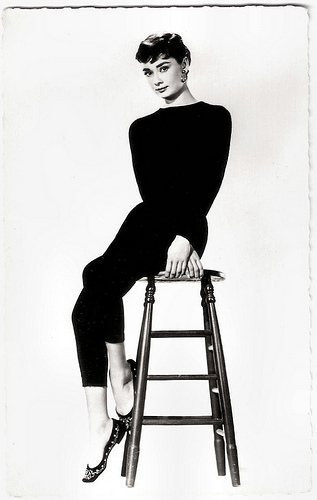
French postcard by Editions du Globe, Paris, no. 385. Photo: Paramount / P.P.C. Publicity still for Sabrina (Billy Wilder, 1954). Costume: Hubert de Givenchy.
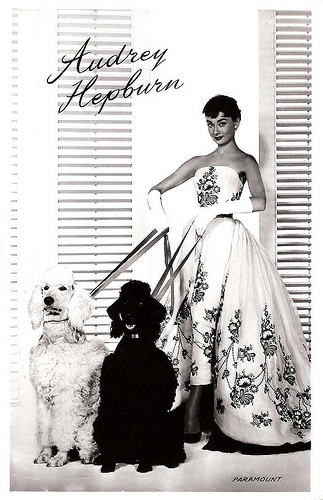
Dutch postcard by Takken, Utrecht, no. 1530. Photo: Paramount. Publicity still for Sabrina (Billy Wilder, 1954). Costume: Hubert de Givenchy.
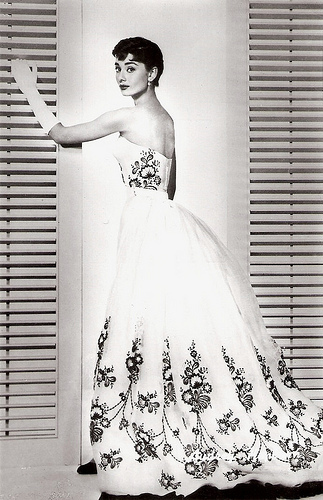
French postcard. Publicity still for Sabrina (Billy Wilder, 1954). Costume: Hubert de Givenchy.
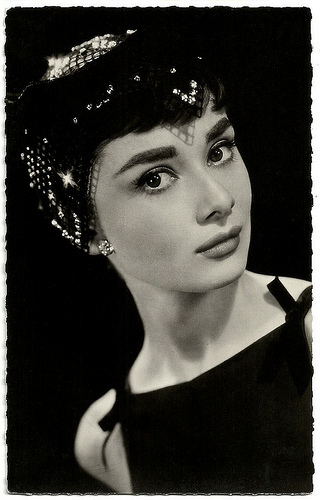
French postcard by Editions du Globe, Paris / PPC, 1955. Photo: Audrey Hepburn in Sabrina (Billy Wilder, 1954). Costume: Hubert de Givenchy.
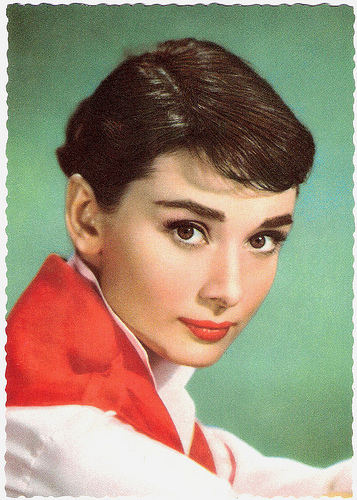
German postcard by Ufa, Berlin-Tempelhof, no. CK-5. Retail price: 30 Pfg. Photo: Paramount Film.
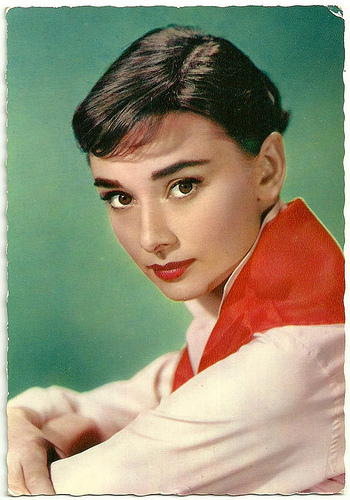
French postcard. Unknown editor and photographer.
War Time in Arnhem
Audrey Hepburn was born as Audrey Kathleen Ruston in Ixelles/Elsene, a municipality in Brussels, Belgium, in 1929. She was the only child of Joseph Victor Anthony Ruston, a Briton, and his second wife, the former Baroness Ella van Heemstra, a Dutch aristocrat, who was a daughter of a former governor of Dutch Guiana.
Her father later used the surname of his maternal grandmother, Kathleen Hepburn, to the family's and her surname became Hepburn-Ruston. Hepburn's father's job with a British insurance company meant the family travelled often between Brussels, England, and The Netherlands. In 1935, her parents divorced and her father, a Nazi sympathiser, left the family.
In 1939, her mother moved her and her two half-brothers to their grandfather's home in Arnhem in the Netherlands, believing the Netherlands would be safe from a German attack. Hepburn attended the Arnhem Conservatory from 1939 to 1945, where she trained in ballet along with the standard school curriculum. In 1940, the Germans invaded the Netherlands. During the German occupation, Hepburn adopted the pseudonym Edda van Heemstra, modifying her mother's documents because an 'English sounding' name was considered dangerous.
By 1944, Audrey had become a proficient ballerina. She secretly danced for groups of people to collect money for the Dutch resistance. During the Dutch famine that followed, over the winter of 1944, people starved and froze to death in the streets. Hepburn and many others resorted to making flour out of tulip bulbs to bake cakes and biscuits. Hepburn's wartime experiences later led her to become involved with UNICEF.
In 1945, after the war, Hepburn left the Arnhem Conservatory and moved to Amsterdam, where she took ballet lessons with Lithuanian-Dutch-Jewish dancer and choreographer Sonia Gaskell. Hepburn made her first film appearance in Nederlands in 7 lessen/Dutch in Seven Lessons (Charles Huguenot van der Linden, Heinz Josephson, 1948), a Dutch film made for KLM Royal Dutch Airlines. It had a film-within-the-film scenario involving a cameraman who's given a week to photograph the aerial highlights of Holland for a travelogue. Hepburn played the stewardess.
She then travelled with her mother to London. Gaskell provided an introduction to Marie Rambert, and Hepburn studied ballet at the Ballet Rambert, supporting herself with part time work as a model. Rambert warned her that she could not become a prima ballerina, because she was relatively tall (1.7m). Audrey decided to pursue an acting career instead.
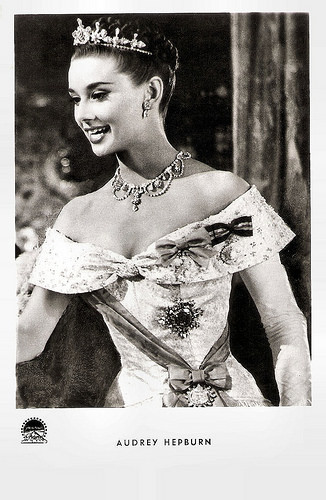
German postcard by Kunst und Bild, Berlin, no. A 1031. Photo: Paramount. Publicity still for Roman Holiday (William Wyler, 1952).
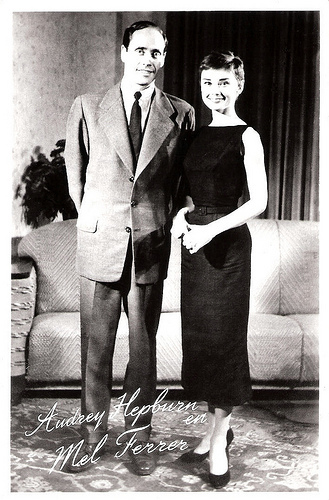
Dutch postcard by Takken, Utrecht, no. 1598. With Mel Ferrer.
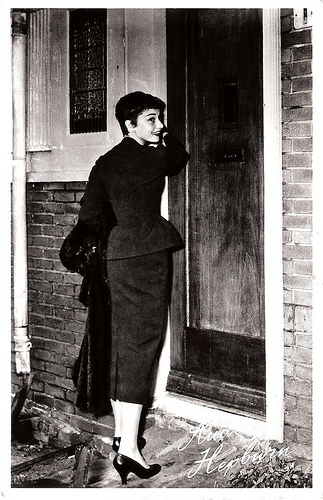
Dutch postcard by Takken, Utrecht, no. 1599. Audrey Hepburn visiting Arnhem after the war.
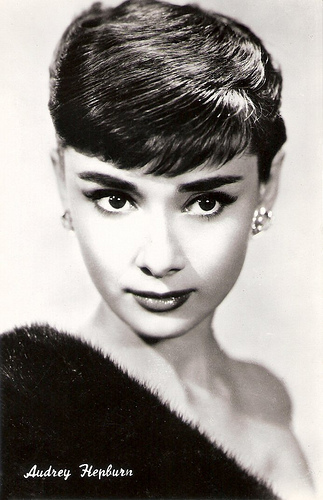
Italian postcard by Bromofoto, Milano (Milan).
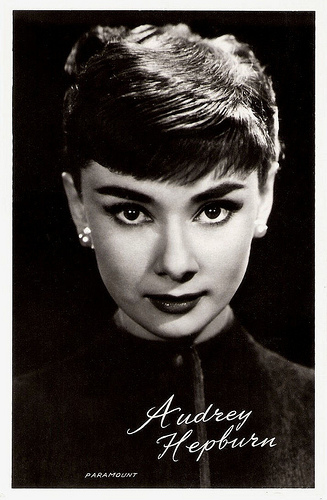
Dutch postcard by Takken, Utrecht, no. 1422. Photo: Paramount.
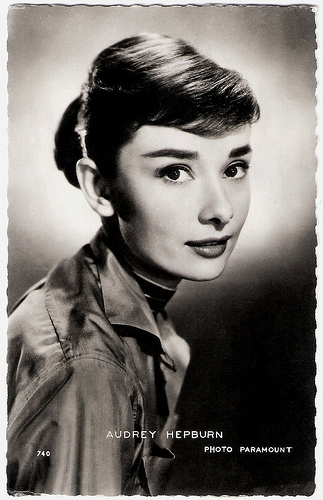
French postcard by Editions P.I., Paris, no. 740. Photo: Paramount, 1956.
Meeting Colette
In London, Audrey Hepburn played in musical theatre in productions such as High Button Shoes and Sauce Piquante. Her theatre work revealed that her voice was not strong and needed to be developed, and during this time she took elocution lessons with the actor Felix Aylmer.
Part time modelling work was not always available and Hepburn registered with the casting officers of Britain's film studios in the hope of getting work as an extra. Hepburn's first British film role was in the farce One Wild Oat (Charles Saunders, 1951) in which she played a hotel receptionist. She played several more small roles in Young Wives' Tale (Henry Cass, 1951), Laughter in Paradise (Mario Zampi, 1951), the classic crime comedy The Lavender Hill Mob (Charles Crichton, 1951), and the comedy Monte Carlo Baby (Jean Boyer, Lester Fuller, 1951).
Monte Carlo Baby was shot at the same time as the French-language version, Nous irons à Monte Carlo (Jean Boyer, 1952). During the filming Hepburn met the famous author Colette, who recommended her for the lead character of a stage version of her novel Gigi on Broadway.
Colette reportedly said when she first saw Hepburn "Voilà! There's our Gigi!" The play opened on 24 November, 1951, and ran for 219 performances. Audrey won a Theatre World Award for her performance. Hepburn's first significant film performance was in the British crime drama Secret People (Thorold Dickinson, 1952), starring Valentina Cortese . Audrey played a prodigious ballerina, and did all of her own dancing scenes.
Her first starring role was opposite Gregory Peck in the Italian-set Roman Holiday (William Wyler, 1952). Producers initially wanted Elizabeth Taylor for the role of Princess Ann, but director William Wyler was so impressed by Hepburn's screen test (the camera was left on and candid footage of Hepburn relaxing and answering questions, unaware that she was still being filmed, displayed her talents), that he cast her in the lead. For her enchanting role in Roman Holiday she would win an Academy Award, a Golden Globe and a BAFTA. Paramount signed her to a seven-picture contract with twelve months in between films to allow her time for stage work.
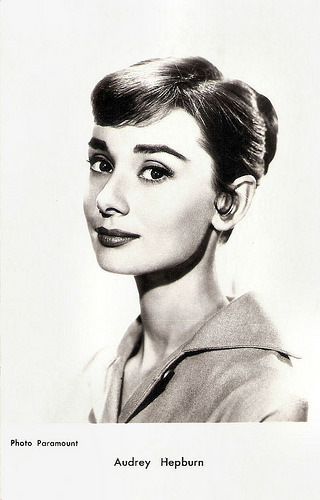
French postcard by Editions P.I., Paris, no. 788. Photo: Paramount.
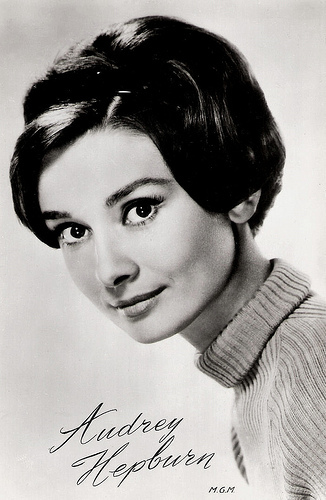
Dutch postcard by Uitg. Takken, Utrecht, no. 4244. Photo: MGM. Publicity still for Green Mansions (Mel Ferrer, 1959).
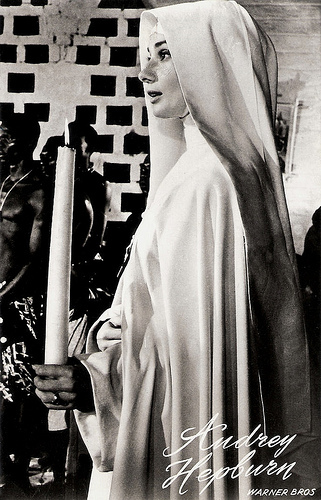
Dutch postcard by Takken, Utrecht, no. 4175. Photo: Warner Bros. Publicity still for The Nun's Story. (Fred Zinnemann, 1959).
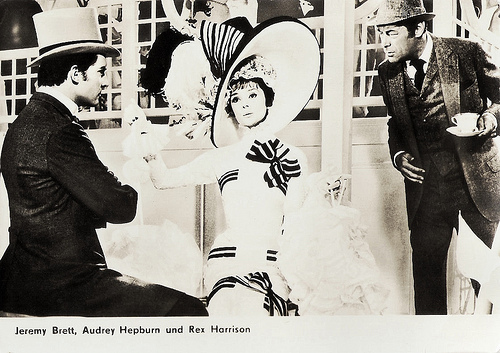
East-German postcard by VEB-Progress Film-Vertrieb, Berlin, no. 2989. Retail price: 0,20 MDM. Photo: Warner Bros. Publicity still for My Fair Lady (George Cukor, 1964) with Jeremy Brett and Rex Harrison . Costumes: Cecil Beaton.
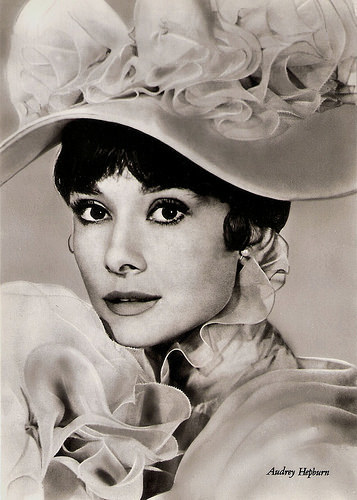
East-German postcard by VEB-Progress Film-Vertrieb, Berlin, no. 2988. Retail price: 0,20 MDM. Photo: Warner Bros. Publicity still for My Fair Lady (George Cukor, 1964). Costume: Cecil Beaton.
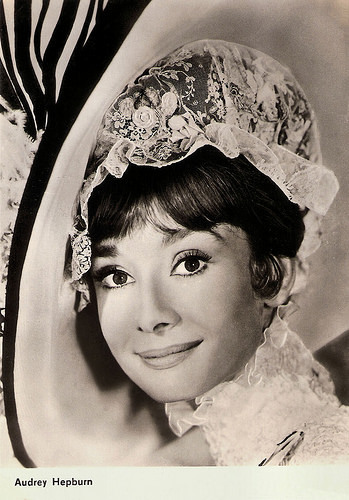
East-German postcard by VEB-Progress Film-Vertrieb, Berlin, no. 3028. Retail price: 0,20 MDM. Photo: Warner Bros. Publicity still for My Fair Lady (George Cukor, 1964). Costume: Cecil Beaton.
Oscar and Tony
After Roman Holiday, Audrey Hepburn filmed Sabrina (Billy Wilder, 1954) with Humphrey Bogart and William Holden. Hepburn was sent to a then young and upcoming fashion designer Hubert de Givenchy to decide on her wardrobe. Their creative partnership endured for the remainder of Hepburn’s life. Audrey Hepburn wore De Givenchy creations in some of her most renowned films, such as How to steal a Million (William Wyler, 1966) and Breakfast at Tiffany’s (Blake Edwards, 1961).
In 1954, she returned to the stage to play the water sprite in Ondine in a performance with Mel Ferrer, who she would marry later in the year. She also won a Tony Award for her performance in Ondine (1954). Hepburn is one of only three actresses to receive a Best Actress Oscar and Best Actress Tony in the same year - the others were Shirley Booth and Ellen Burstyn.
Audrey Hepburn was now one of the most successful film actresses in the world, but also a major fashion influence. Her gamine and elfin appearance and widely recognised sense of chic were both admired and imitated. She costarred with such notable leading men as Henry Fonda in War and Peace (King Vidor, 1956), Fred Astaire in Funny Face (Stanley Donen, 1957), Maurice Chevalier and Gary Cooper in Love in the Afternoon (Billy Wilder, 1957), Anthony Perkins in Green Mansions (Mel Ferrer, 1959), and Burt Lancaster in The Unforgiven (John Huston, 1960).
According to Denny Jackson at IMDb , "Audrey reached the pinnacle of her career when she played Holly Golightly in the delightful film Breakfast at Tiffany's (1961). For this she received another Oscar nomination." Opposite Shirley MacLaine she starred in The Children's Hour (William Wyler, 1961). She scored another box office hit with the espionage caper Charade (Stanley Donen, 1963) with Cary Grant.
One of her most radiant roles was as Eliza Doolittle in the film version of My Fair Lady (George Cukor, 1964), opposite Rex Harrison. She became only the third actor to receive $1,000,000 for a film role. She followed it with roles opposite Peter O'Toole in How to Steal a Million (William Wyler, 1966) and Albert Finney in Two for the Road (Stanley Donen, 1967).
She received Academy Award nominations for Sabrina (1954), The Nun's Story (Fred Zinnemann, 1959), Breakfast at Tiffany's (1961) and Wait Until Dark (Terence Young, 1967), and won BAFTA Awards for her performances in The Nun's Story (1959) and Charade (1963). After Wait Until Dark (Terence Young, 1967) and 15 years of continuous success, she took a break from film-making from 1968 to 1975, mostly to spend more time with her two sons.
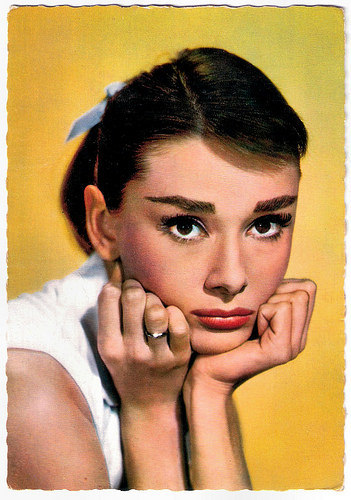
French postcard by E.D.U.G., no. 129.
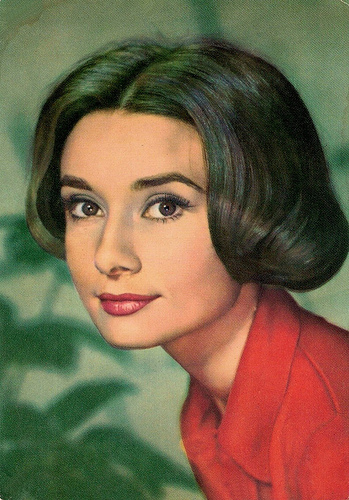
Spanish postcard by Postal Oscarcolor, no. F-179.
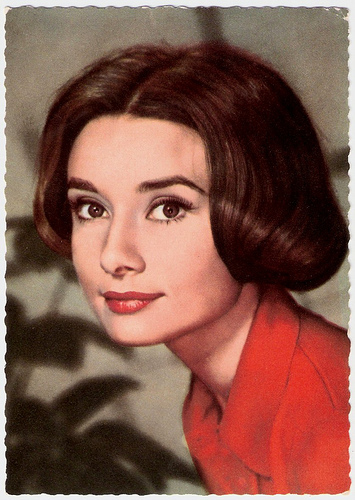
German postcard by Ufa (Universum-Film Aktiengesellschaft, Berlin-Tempelhof), no. CK-179. Photo: Terb Agency / Ufa. Retail price was 30 Pfg.
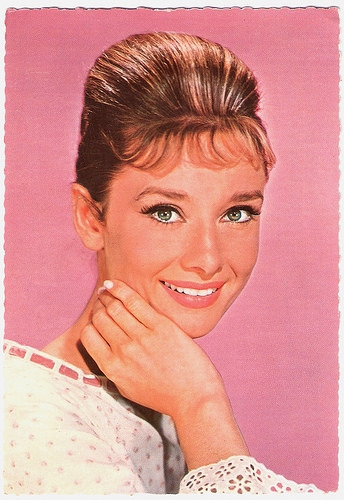
French postcard by E.D.U.G., no. 222.
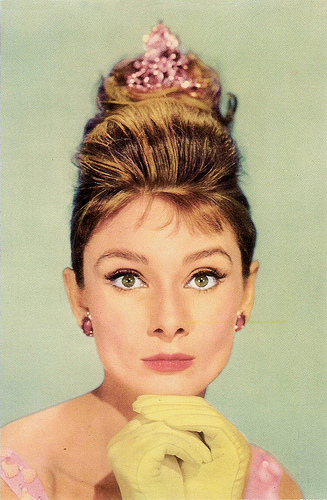
Israelian postcard by Editions De Luxe, no. 130. Photo: publicity still for Breakfast at Tiffany's (Blake Edwards, 1961).
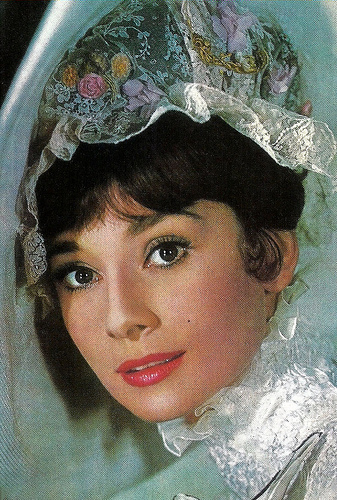
Spanish postcard by Oscarcolor. Audrey Hepburn in My Fair Lady (George Cukor, 1964).
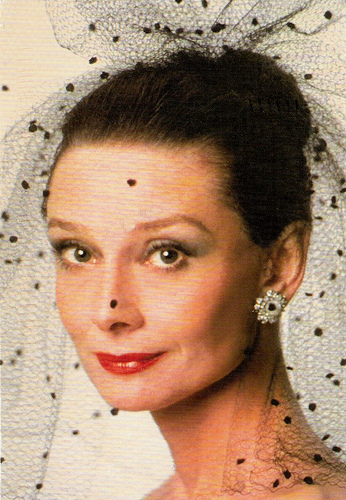
American postcard.
Passion for Humanitarian Work
In 1976 Audrey Hepburn returned to the screen with Sean Connery in the period piece Robin and Marian (Richard Lester, 1976), which was moderately successful.
Three years later she took the leading role of in the international production Bloodline (Terence Young, 1979) based on a novel by Sidney Sheldon. The film, an international intrigue amid the jet-set, was a critical and box office failure. Another commercial failure was the mad cap private-eye caper They All Laughed (Peter Bogdanovich, 1981).
In 1989 she made her last film appearance as an angel in the romantic comedy Always (Steven Spielberg, 1989) starring Richard Dreyfuss.
Her war-time experiences inspired her passion for humanitarian work, and although she had worked for United Nations Children's Fund (UNICEF) since the 1950s, during her later life, she dedicated much of her time and energy to the organisation. From 1988 until 1992, she worked in some of the most profoundly disadvantaged communities of Africa, South America and Asia. In 1992, she was awarded the Presidential Medal of Freedom in recognition of her work as a UNICEF Goodwill Ambassador.
After her divorce from American actor Mel Ferrer, Hepburn married Italian psychiatrist Dr. Andrea Dotti. She had a son with each – Sean (1960) by Ferrer, and Luca (1970) by Dotti. From 1980 until her death, she lived with the Dutch actor Robert Wolders.
In 1993, Audrey Hepburn died of appendiceal cancer at her home in Tolochenaz, Switzerland at the age of 63. She was posthumously awarded The Jean Hersholt Humanitarian Award by the Academy of Motion Picture Arts and Sciences for her humanitarian work. She received a posthumous Grammy Award for her spoken word recording, Audrey Hepburn's Enchanted Tales in 1994, and in the same year, won an Emmy Award for Outstanding Achievement for Gardens of the World with Audrey Hepburn, thereby becoming one of a few people to receive an Academy, Emmy, Grammy and Tony award. In 1999, she was ranked as the third greatest female star of all time by the American Film Institute.
Scenes from Nederlands in 7 lessen/Dutch in Seven Lessons (1948). Source: EverythingAudrey.com (YouTube).
Audrey Hepburn in Laughter in Paradise (1951). Source: myusernameisrobyn (YouTube).
Scenes from Secret People (1952). Source: EverythingAudrey.com (YouTube).
The screen test by William Wyler for Roman Holiday (1952). Source: Haphazard Studios (YouTube).
Audrey Hepburn and husband Mel Ferrer visit the Netherlands to attend a film premiere of El Greco starring Mel Ferrer. Source: FabAudrey (YouTube).
Trailer of Breakfast at Tiffany's (1961). Source: FabAudrey (YouTube).
The Fashion Designer and His Muse - Audrey Hepburn and Hubert de Givenchy. Source: Nanda (YouTube).
Sources: (IMDb), Gemeentemuseum Den Haag, Wikipedia and .

French postcard by Editions du Globe, Paris, no. 385. Photo: Paramount / P.P.C. Publicity still for Sabrina (Billy Wilder, 1954). Costume: Hubert de Givenchy.

Dutch postcard by Takken, Utrecht, no. 1530. Photo: Paramount. Publicity still for Sabrina (Billy Wilder, 1954). Costume: Hubert de Givenchy.

French postcard. Publicity still for Sabrina (Billy Wilder, 1954). Costume: Hubert de Givenchy.

French postcard by Editions du Globe, Paris / PPC, 1955. Photo: Audrey Hepburn in Sabrina (Billy Wilder, 1954). Costume: Hubert de Givenchy.

German postcard by Ufa, Berlin-Tempelhof, no. CK-5. Retail price: 30 Pfg. Photo: Paramount Film.

French postcard. Unknown editor and photographer.
War Time in Arnhem
Audrey Hepburn was born as Audrey Kathleen Ruston in Ixelles/Elsene, a municipality in Brussels, Belgium, in 1929. She was the only child of Joseph Victor Anthony Ruston, a Briton, and his second wife, the former Baroness Ella van Heemstra, a Dutch aristocrat, who was a daughter of a former governor of Dutch Guiana.
Her father later used the surname of his maternal grandmother, Kathleen Hepburn, to the family's and her surname became Hepburn-Ruston. Hepburn's father's job with a British insurance company meant the family travelled often between Brussels, England, and The Netherlands. In 1935, her parents divorced and her father, a Nazi sympathiser, left the family.
In 1939, her mother moved her and her two half-brothers to their grandfather's home in Arnhem in the Netherlands, believing the Netherlands would be safe from a German attack. Hepburn attended the Arnhem Conservatory from 1939 to 1945, where she trained in ballet along with the standard school curriculum. In 1940, the Germans invaded the Netherlands. During the German occupation, Hepburn adopted the pseudonym Edda van Heemstra, modifying her mother's documents because an 'English sounding' name was considered dangerous.
By 1944, Audrey had become a proficient ballerina. She secretly danced for groups of people to collect money for the Dutch resistance. During the Dutch famine that followed, over the winter of 1944, people starved and froze to death in the streets. Hepburn and many others resorted to making flour out of tulip bulbs to bake cakes and biscuits. Hepburn's wartime experiences later led her to become involved with UNICEF.
In 1945, after the war, Hepburn left the Arnhem Conservatory and moved to Amsterdam, where she took ballet lessons with Lithuanian-Dutch-Jewish dancer and choreographer Sonia Gaskell. Hepburn made her first film appearance in Nederlands in 7 lessen/Dutch in Seven Lessons (Charles Huguenot van der Linden, Heinz Josephson, 1948), a Dutch film made for KLM Royal Dutch Airlines. It had a film-within-the-film scenario involving a cameraman who's given a week to photograph the aerial highlights of Holland for a travelogue. Hepburn played the stewardess.
She then travelled with her mother to London. Gaskell provided an introduction to Marie Rambert, and Hepburn studied ballet at the Ballet Rambert, supporting herself with part time work as a model. Rambert warned her that she could not become a prima ballerina, because she was relatively tall (1.7m). Audrey decided to pursue an acting career instead.

German postcard by Kunst und Bild, Berlin, no. A 1031. Photo: Paramount. Publicity still for Roman Holiday (William Wyler, 1952).

Dutch postcard by Takken, Utrecht, no. 1598. With Mel Ferrer.

Dutch postcard by Takken, Utrecht, no. 1599. Audrey Hepburn visiting Arnhem after the war.

Italian postcard by Bromofoto, Milano (Milan).

Dutch postcard by Takken, Utrecht, no. 1422. Photo: Paramount.

French postcard by Editions P.I., Paris, no. 740. Photo: Paramount, 1956.
Meeting Colette
In London, Audrey Hepburn played in musical theatre in productions such as High Button Shoes and Sauce Piquante. Her theatre work revealed that her voice was not strong and needed to be developed, and during this time she took elocution lessons with the actor Felix Aylmer.
Part time modelling work was not always available and Hepburn registered with the casting officers of Britain's film studios in the hope of getting work as an extra. Hepburn's first British film role was in the farce One Wild Oat (Charles Saunders, 1951) in which she played a hotel receptionist. She played several more small roles in Young Wives' Tale (Henry Cass, 1951), Laughter in Paradise (Mario Zampi, 1951), the classic crime comedy The Lavender Hill Mob (Charles Crichton, 1951), and the comedy Monte Carlo Baby (Jean Boyer, Lester Fuller, 1951).
Monte Carlo Baby was shot at the same time as the French-language version, Nous irons à Monte Carlo (Jean Boyer, 1952). During the filming Hepburn met the famous author Colette, who recommended her for the lead character of a stage version of her novel Gigi on Broadway.
Colette reportedly said when she first saw Hepburn "Voilà! There's our Gigi!" The play opened on 24 November, 1951, and ran for 219 performances. Audrey won a Theatre World Award for her performance. Hepburn's first significant film performance was in the British crime drama Secret People (Thorold Dickinson, 1952), starring Valentina Cortese . Audrey played a prodigious ballerina, and did all of her own dancing scenes.
Her first starring role was opposite Gregory Peck in the Italian-set Roman Holiday (William Wyler, 1952). Producers initially wanted Elizabeth Taylor for the role of Princess Ann, but director William Wyler was so impressed by Hepburn's screen test (the camera was left on and candid footage of Hepburn relaxing and answering questions, unaware that she was still being filmed, displayed her talents), that he cast her in the lead. For her enchanting role in Roman Holiday she would win an Academy Award, a Golden Globe and a BAFTA. Paramount signed her to a seven-picture contract with twelve months in between films to allow her time for stage work.

French postcard by Editions P.I., Paris, no. 788. Photo: Paramount.

Dutch postcard by Uitg. Takken, Utrecht, no. 4244. Photo: MGM. Publicity still for Green Mansions (Mel Ferrer, 1959).

Dutch postcard by Takken, Utrecht, no. 4175. Photo: Warner Bros. Publicity still for The Nun's Story. (Fred Zinnemann, 1959).

East-German postcard by VEB-Progress Film-Vertrieb, Berlin, no. 2989. Retail price: 0,20 MDM. Photo: Warner Bros. Publicity still for My Fair Lady (George Cukor, 1964) with Jeremy Brett and Rex Harrison . Costumes: Cecil Beaton.

East-German postcard by VEB-Progress Film-Vertrieb, Berlin, no. 2988. Retail price: 0,20 MDM. Photo: Warner Bros. Publicity still for My Fair Lady (George Cukor, 1964). Costume: Cecil Beaton.

East-German postcard by VEB-Progress Film-Vertrieb, Berlin, no. 3028. Retail price: 0,20 MDM. Photo: Warner Bros. Publicity still for My Fair Lady (George Cukor, 1964). Costume: Cecil Beaton.
Oscar and Tony
After Roman Holiday, Audrey Hepburn filmed Sabrina (Billy Wilder, 1954) with Humphrey Bogart and William Holden. Hepburn was sent to a then young and upcoming fashion designer Hubert de Givenchy to decide on her wardrobe. Their creative partnership endured for the remainder of Hepburn’s life. Audrey Hepburn wore De Givenchy creations in some of her most renowned films, such as How to steal a Million (William Wyler, 1966) and Breakfast at Tiffany’s (Blake Edwards, 1961).
In 1954, she returned to the stage to play the water sprite in Ondine in a performance with Mel Ferrer, who she would marry later in the year. She also won a Tony Award for her performance in Ondine (1954). Hepburn is one of only three actresses to receive a Best Actress Oscar and Best Actress Tony in the same year - the others were Shirley Booth and Ellen Burstyn.
Audrey Hepburn was now one of the most successful film actresses in the world, but also a major fashion influence. Her gamine and elfin appearance and widely recognised sense of chic were both admired and imitated. She costarred with such notable leading men as Henry Fonda in War and Peace (King Vidor, 1956), Fred Astaire in Funny Face (Stanley Donen, 1957), Maurice Chevalier and Gary Cooper in Love in the Afternoon (Billy Wilder, 1957), Anthony Perkins in Green Mansions (Mel Ferrer, 1959), and Burt Lancaster in The Unforgiven (John Huston, 1960).
According to Denny Jackson at IMDb , "Audrey reached the pinnacle of her career when she played Holly Golightly in the delightful film Breakfast at Tiffany's (1961). For this she received another Oscar nomination." Opposite Shirley MacLaine she starred in The Children's Hour (William Wyler, 1961). She scored another box office hit with the espionage caper Charade (Stanley Donen, 1963) with Cary Grant.
One of her most radiant roles was as Eliza Doolittle in the film version of My Fair Lady (George Cukor, 1964), opposite Rex Harrison. She became only the third actor to receive $1,000,000 for a film role. She followed it with roles opposite Peter O'Toole in How to Steal a Million (William Wyler, 1966) and Albert Finney in Two for the Road (Stanley Donen, 1967).
She received Academy Award nominations for Sabrina (1954), The Nun's Story (Fred Zinnemann, 1959), Breakfast at Tiffany's (1961) and Wait Until Dark (Terence Young, 1967), and won BAFTA Awards for her performances in The Nun's Story (1959) and Charade (1963). After Wait Until Dark (Terence Young, 1967) and 15 years of continuous success, she took a break from film-making from 1968 to 1975, mostly to spend more time with her two sons.

French postcard by E.D.U.G., no. 129.

Spanish postcard by Postal Oscarcolor, no. F-179.

German postcard by Ufa (Universum-Film Aktiengesellschaft, Berlin-Tempelhof), no. CK-179. Photo: Terb Agency / Ufa. Retail price was 30 Pfg.

French postcard by E.D.U.G., no. 222.

Israelian postcard by Editions De Luxe, no. 130. Photo: publicity still for Breakfast at Tiffany's (Blake Edwards, 1961).

Spanish postcard by Oscarcolor. Audrey Hepburn in My Fair Lady (George Cukor, 1964).

American postcard.
Passion for Humanitarian Work
In 1976 Audrey Hepburn returned to the screen with Sean Connery in the period piece Robin and Marian (Richard Lester, 1976), which was moderately successful.
Three years later she took the leading role of in the international production Bloodline (Terence Young, 1979) based on a novel by Sidney Sheldon. The film, an international intrigue amid the jet-set, was a critical and box office failure. Another commercial failure was the mad cap private-eye caper They All Laughed (Peter Bogdanovich, 1981).
In 1989 she made her last film appearance as an angel in the romantic comedy Always (Steven Spielberg, 1989) starring Richard Dreyfuss.
Her war-time experiences inspired her passion for humanitarian work, and although she had worked for United Nations Children's Fund (UNICEF) since the 1950s, during her later life, she dedicated much of her time and energy to the organisation. From 1988 until 1992, she worked in some of the most profoundly disadvantaged communities of Africa, South America and Asia. In 1992, she was awarded the Presidential Medal of Freedom in recognition of her work as a UNICEF Goodwill Ambassador.
After her divorce from American actor Mel Ferrer, Hepburn married Italian psychiatrist Dr. Andrea Dotti. She had a son with each – Sean (1960) by Ferrer, and Luca (1970) by Dotti. From 1980 until her death, she lived with the Dutch actor Robert Wolders.
In 1993, Audrey Hepburn died of appendiceal cancer at her home in Tolochenaz, Switzerland at the age of 63. She was posthumously awarded The Jean Hersholt Humanitarian Award by the Academy of Motion Picture Arts and Sciences for her humanitarian work. She received a posthumous Grammy Award for her spoken word recording, Audrey Hepburn's Enchanted Tales in 1994, and in the same year, won an Emmy Award for Outstanding Achievement for Gardens of the World with Audrey Hepburn, thereby becoming one of a few people to receive an Academy, Emmy, Grammy and Tony award. In 1999, she was ranked as the third greatest female star of all time by the American Film Institute.
Scenes from Nederlands in 7 lessen/Dutch in Seven Lessons (1948). Source: EverythingAudrey.com (YouTube).
Audrey Hepburn in Laughter in Paradise (1951). Source: myusernameisrobyn (YouTube).
Scenes from Secret People (1952). Source: EverythingAudrey.com (YouTube).
The screen test by William Wyler for Roman Holiday (1952). Source: Haphazard Studios (YouTube).
Audrey Hepburn and husband Mel Ferrer visit the Netherlands to attend a film premiere of El Greco starring Mel Ferrer. Source: FabAudrey (YouTube).
Trailer of Breakfast at Tiffany's (1961). Source: FabAudrey (YouTube).
The Fashion Designer and His Muse - Audrey Hepburn and Hubert de Givenchy. Source: Nanda (YouTube).
Sources: (IMDb), Gemeentemuseum Den Haag, Wikipedia and .
Published on January 14, 2017 22:00
Paul van Yperen's Blog
- Paul van Yperen's profile
- 13 followers
Paul van Yperen isn't a Goodreads Author
(yet),
but they
do have a blog,
so here are some recent posts imported from
their feed.



